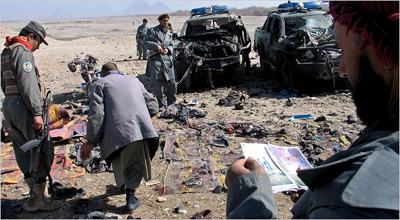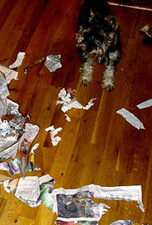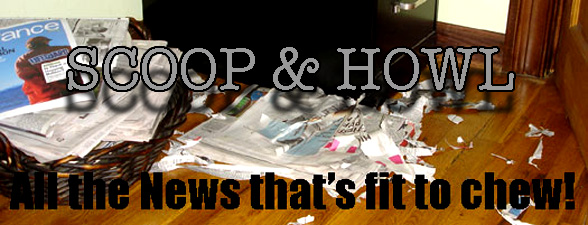
Meet Jasmine, the rescue dog who has become a surrogate mother
for the 50th time
31st
December 2008
When Jasmine the abandoned greyhound arrived at a wildlife
sanctuary shivering and desperate for food, she needed all
the love in the world to nurse her back to full health.
Now
it appears the kindness and patience shown to her has rubbed
off - for the rescue dog has become a surrogate mother for
the 50th time. Seven-year-old Jasmine is currently caring
for tiny Bramble, an 11-week-old roe deer fawn found semi-conscious
in a nearby field. She cuddles up to her to keep her warm,
showers her with affection and makes sure nothing is matted
in her fur. In short, the perfect foster mum.
But then again, she has had plenty of practice, having cared
for five fox cubs, four badger cubs, 15 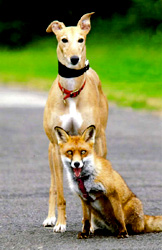 chicks,
eight guinea pigs, two stray puppies and even 15 rabbits. chicks,
eight guinea pigs, two stray puppies and even 15 rabbits.
Jasmine was brought to the Nuneaton and Warwickshire Wildlife
Sanctuary by the police in 2003, having been found dumped
in a garden shed. She was cold, filthy and malnourished. It
took a few weeks for her to fully trust staff at the centre
but with tender loving care she was nursed back to full fitness.
Five years on, Jasmine is now the one looking after stray
waifs.
Geoff Grewcock, who runs the sanctuary, said: 'She simply
dotes on the animals as if they were her on, it's incredible
to see. She takes all the stress out of them and it helps
them to not only feel close to her but to settle into their
new surroundings. As soon as an animal is brought in, she
walks over takes a sniff or two and then licks and cuddles
them. It is quite amazing, particularly as she is a greyhound
breed and they are usually quite aggressive, That is why they
are used for racing.'
'Jasmine was abused when she was younger, the police brought
her to us after discovering her whimpering in a garden shed.
She was very nervous around us, she was caked in mud and dust
and very thin. It took a while but gradually she got used
to us and has been at the centre ever since. Having been neglected
herself, it's a real surprise to she her show so much warmth
and affection to other creatures. It's not just animals, she
is great which children too, she is such a gentle, big-hearted
dog.'
Bramble the fawn arrived at the centre two months ago after
a dog walker came across her in a field dazed and confused.
Until she is old enough to be released back into the wild,
she will continue to be cared for by Jasmine.
 Geoff added: 'They are inseparable at the moment, Bramble
walks between her legs and they keep kissing each other. They
walk together round the sanctuary. It's absolutely marvellous.
It's a real treat to see them.
Geoff added: 'They are inseparable at the moment, Bramble
walks between her legs and they keep kissing each other. They
walk together round the sanctuary. It's absolutely marvellous.
It's a real treat to see them.
'But she is like that with all of our animals, even the rabbits
which greyhounds usually chase down the track. I remember
we had two puppies that had been abandoned by a nearby railway
line, one was a Lakeland Terrier cross and another was a Jack
Russell Doberman cross. They were tiny when they arrived at
the centre and Jasmine approached them and grabbed one by
the scruff of the neck in her mouth and put him on the settee.
Then he fetched the other one and sat down with them, cuddling
them.
'She has done the same with the fox and badger cubs, she licks
the rabbits and guinea pigs and even lets the birds perch
on the bridge of her nose.
'It's very touching. Her maternal instincts take over all
the time.'
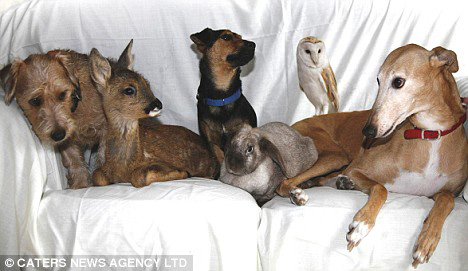
Happy family: Pictured from left to right are Toby, a stray
Lakeland
dog; Bramble, an orphaned roe deer; Buster, a stray Jack Russell;
a
dumped rabbit; Sky, an injured barn owl, and Jasmine
|

"Marley
& Me" top dog at busy Christmas box office
By Dean Goodman
Mon
Dec 29, 2008
LOS ANGELES (Reuters) - It may have been a bleak Christmas
for U.S. retailers but Hollywood enjoyed a bumper holiday
as new films, led by the dog tale "Marley & Me"
and awards contender "The Curious Case of Benjamin Button,"
drew throngs of moviegoers to theaters across North America.
"Marley & Me" sold an estimated $37 million
worth of tickets during the traditional three-day weekend
beginning on Friday, distributor 20th Century Fox said on
Sunday. Jennifer Aniston and Owen Wilson star in the adaptation
of a bestseller about a couple and their Labrador retriever.
The movie about "life, love and family" -- according
to Fox senior vice president of domestic distribution Bert
Livingston -- played strongly with audiences of all ages seeking
feel-good entertainment.
As with the four other new releases, "Marley & Me"
opened on Thursday and earned $14.7 million -- a new Christmas
Day record.

Movie review: 'Marley
& Me'
a
sweet tearjerker
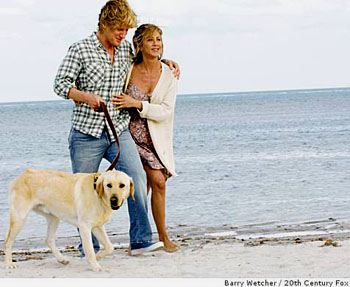 Walter Addiego, Chronicle staff writer
Walter Addiego, Chronicle staff writer
Thursday,
December 25, 2008
Marley & Me: Comedy. Starring Owen Wilson, Jennifer Aniston
and Eric Dane. Directed by David Frankel. (PG. 123 minutes.
At Bay Area theaters.)
This love letter to man's best friend will make dog fanciers
roll over and do tricks. It's so warmhearted, you'll want
to run out and hug the nearest big, sloppy mutt.
And while you're watching it, have your handkerchief ready.
Though partly a comedy about the joys and stresses of modern
family life, "Marley & Me" is also a tearjerker.
The "Me" of the title is John Grogan, in real life
a Philadelphia Inquirer columnist who often wrote about his
wife and kids and Marley, the family's boisterous Labrador.
Readers loved Marley's misadventures, so the columnist wrote
a best-selling book, "Marley & Me: Life and Love
With the World's Worst Dog."
Click
√
on image for full review
|

The UnDog and the NonCat
By
TERI KARUSH ROGERS
Published:
December 26, 2008
IN a city awash in creature comforts for those who can still
afford them, a few remain unattainable at any price. Some
New Yorkers who yearn for the comfort of creatures —
specifically, cats and dogs — find themselves stymied
by their apartment buildings’ restrictions on pets.
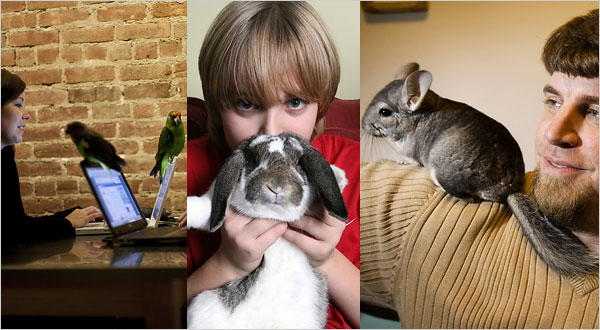
NO
DOG POLICIES led Tonia Misvaer, left, to two small parrots,
Swami and Odin; Dylan Edwards-Gaherty, center, and Pounce,
a rabbit that joined the family because their building prohibited
dogs; and Morgan Dontanville, right, with Ajax, a chinchilla.
But
just as city dwellers are accustomed to settling when it comes
to real estate, many aspiring cat and dog owners turn to other
species to satisfy their yen for a cuddle, companionship or
wish to convey childhood lessons in responsibility.
A partial list of things that slither, hop, glide, swim or
scurry beyond the purview of co-op boards, landlords and occasionally,
the law, includes chinchillas, parrots, bearded dragons, tortoises,
pythons, fancy mice, monkeys and ferrets, along with a more
pedestrian assortment of gerbils, guinea pigs and goldfish.
Click
√
on image for full article
Photos
from left: Michael Nagle , Suzanne DeChillo, Robert Caplan
for The New York Times
|

Dogfighting Making a Comeback in Afghanistan
By
KIRK SEMPLE
Published:
December 27, 2008
KABUL, Afghanistan — In a dingy butcher’s shop
reeking of slaughter, a half-dozen sheep’s carcasses
dangled from hooks, and two men spoke of dogs.

Dogfighting tournaments in Kabul draw thousands of men and
boys as spectators.
“My
dog is younger than his dog, I have the advantage,” said
one of the men, known as Abdul Sabour, 49. “And my dog
is more energetic than his dog.”
“He’s lying,” grumbled the other man, Kefayatullah,
50. “His dog is old. He’s just here wasting his
time. How many dogs has my dog beaten? Sixty! My dog has been
a champion for three years!”
The men were arranging a dogfight, largely in the international
language of trash-talking. They represented two groups of bettors.
The purse, they said, was $50,000, a fortune in this impoverished
country and one of the biggest prizes here in recent memory.
Afghans like to fight. They will boast about this. They will
say that fighting is in their blood. And for all the horrors
of three decades of war, they still find room to fight for fun,
most often through proxies: cocks, rams, goats, camels, kites.
And dogs. Dogfighting was banned under the Taliban, who considered
it un-Islamic. But since the Taliban’s ouster in 2001,
the sport has regained its earlier popularity, with dogfighters
entering their charges in informal weekly tournaments on dusty
lots in the country’s major cities.
The sport has even experienced a resurgence in the south, where
the influence of the Taliban is strongest, though the crowds
have thinned somewhat since February, when a suicide bomber
detonated himself at a dogfighting match. About 80 people were
killed and more were wounded.
Here in the capital, there are two tournaments every week, both
on Friday, the day of prayer. The bigger one unfolds in the
morning in a natural dirt amphitheater at the bottom of a craggy
slope on the city’s outskirts. It draws thousands of men
and boys as spectators — like most sports and sporting
events in Afghanistan, it is almost exclusively a male pursuit.
“It’s something from our ancestors,” said
Ghulam Yahya Amirzadah, 21, whose family owns 17 dogs in Kabul
and in their hometown in the northwest province of Badghis.
Mr. Amirzadah, who is known in dogfighting circles as Lala Herati,
said he inherited the pastime from his father, who ran fighting
dogs in his youth.
“It’s
not about money,” Mr. Amirzadah said. “If
my dog beats another dog, it makes me feel like I’ve won
$100,000.
I
can survive just from the happiness.”
For
full article, click √
on image above
Photo:
Tyler Hicks/The New York Times

|
 Ad
Featuring Singer Proves Bonanza for the A.S.P.C.A.
Ad
Featuring Singer Proves Bonanza for the A.S.P.C.A.
By STEPHANIE STROM
Published:
December 25, 2008
Marie Bedford first saw what has become known as “The
Ad” in nonprofit circles about a year and a  half
ago. “I saw it a couple of times and found I just had
to respond,” Ms. Bedford, an actress living in Brooklyn,
said. “It’s so moving.” half
ago. “I saw it a couple of times and found I just had
to respond,” Ms. Bedford, an actress living in Brooklyn,
said. “It’s so moving.”
The television advertisement, for
the American Society for the Prevention of Cruelty to Animals,
features heartbreaking photographs of dogs and cats scrolling
across the screen while Sarah McLachlan, the Canadian singer-songwriter,
croons the haunting song “Angel” in the background.
That simple pitch has raised roughly $30 million for the organization
since the advertisements started running in early 2007, making
it the A.S.P.C.A.’s most
successful fund-raising effort — and a landmark in nonprofit
fund-raising, where such amounts are virtually unimaginable
for a single commercial. (The organization’s annual
budget is $50 million.)
Ms. McLachlan appears only momentarily to ask viewers to share
her support for the A.S.P.C.A.
“Sarah made it possible to do in two minutes what took
30 minutes before,” said Jo Sullivan, the organization’s
senior vice president for development and communications,
referring to the long-form use of celebrities in the past.
“She literally has changed the way we fund-raise.”
Like Ms. Bedford, many of the roughly 200,000 new donors attracted
to the organization through the advertisement are “annuity”
donors who have pledged an average of $21 a month to the A.S.P.C.A.,
which charges their credit card or receives the money via
an automatic electronic transfer from their bank.
The advertisement came about by accident.
The A.S.P.C.A. had been working
with a Canadian firm, Eagle-Com Inc., which helps charities
raise money using television and that had helped the A.S.P.C.A.
create spots featuring celebrities like Jason Alexander of
“Seinfeld,” Kevin Nealon from “Saturday
Night Live” and Jennifer Coolidge, who played the manicurist
in “Legally Blonde.” Those advertisements typically
ran in the early hours of the morning, which was all the organization
could afford.
Eagle-Com was working on a project for a small animal shelter
in Vancouver, British Columbia, that Ms. McLachlan supported
and asked if she might be interested in doing similar work
for the A.S.P.C.A.
“She asked for information about our mission and programs
and just got really excited,” Ms. Sullivan said. “People
keep asking us how we cultivated her — did we send flowers,
chocolates — but it really was just a happy accident.”
Donations from the McLachlan commercial enabled the A.S.P.C.A
to buy prime-time slots on national networks like CNN, which
in turn has generated more income. This holiday season, the
A.S.P.C.A. rolled out another
advertisement featuring Ms. McLachlan singing “Silent
Night,” and it will release another McLachlan advertisement
in January.
“I don’t want people to hear $30 million and not
understand that we’ve grown tremendously with that increase
in income,” Ms. Sullivan said.
For instance, over the last decade, the A.S.P.C.A.
has increased its grants to support other animal welfare organizations
by 900 percent. “A big chunk of that has come in the
last three years because of this ad,” Ms. Sullivan said.
|

CINDY
ADAMS
Dec.
22, 2008
 I
am in London for the weekend because my friends James and
Charlene Nederlander gave me a lift in their plane. I
am in London for the weekend because my friends James and
Charlene Nederlander gave me a lift in their plane.
On the flight over, by the way, I told them that, when we
returned, I was having a minister come to my home for a blessing
of the animals. I wanted him to bless my Yorkies Jazzy and
Juicy for the New Year. The Nederlanders also had a Yorkie
so I asked: "Want to bring Cupcake?" Said Charlene:
"No, Cupcake is in Palm Beach, where we are going when
we get back."
Two
seconds silence, then: "You think he could do it with
a photo?"
|

Donna
Karan to drop fur from her designs
22
December 2008
Thanks to the hard work of PETA's staff, members, and volunteers
and after nearly a year of 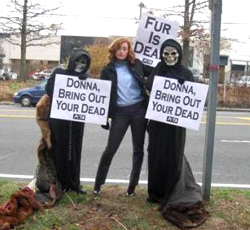 pressuring
designer Donna Karan to drop fur from her designs--by protesting
outside her boutiques, crashing her runway show, and exposing
her cruel use of fur onlin--Donna Karan has pressuring
designer Donna Karan to drop fur from her designs--by protesting
outside her boutiques, crashing her runway show, and exposing
her cruel use of fur onlin--Donna Karan has  announced
that all her Fall 2009 lines will be fur-free and that she
has "no plans" to use fur in the future. announced
that all her Fall 2009 lines will be fur-free and that she
has "no plans" to use fur in the future.
Karan's turnaround came days after PETA launched its online
campaign and after mega--fashion guru Tim
Gunn sent Karan and designer Giorgio Armani a video
that he narrated for PETA showing animals skinned alive for
their fur and urged them to open their eyes to the violent
and bloody fur industry.
While Donna Karan has followed in the footsteps of top designers--including
Ralph Lauren, Tommy
Hilfiger, and Calvin Klein -- ARMANI { http://getactive.peta.org/ct/fdxCTNK164i8/
} still refuses to stop using fur. Armani claims that he "only"
uses fur from rabbits who are butchered for meat.
Contact
Armani
to tell him that the cruelty depicted in this video on fur
farms in both China and France show animals who are used for
both fur and meat. Tell him that even if the meat of gentle
rabbits killed for their fur is sold to be eaten, the rabbits
endure the same suffering.
|

TOUGH
TIMES PUT MORE PETS IN SHELTERS
December
22, 2008
More people are giving up their dogs and cats to animal shelters
as the emotional bonds between people and pets get tested
by hard economic times.
From the Malvern, Pa., man who turned his two dogs over in
order to help pay for his mother's cancer treatments, to the
New York woman who euthanized her cat rather than keeping
it alive with expensive medications, economic anxieties make
it difficult for some pet owners to justify spending $1,000
a year or more on pet food, veterinary services and other
costs.
The population growth at animal shelters shows how the weak
economy is also shrinking the pool of potential adopters.
And it coincides with a drop-off in government funding and
charitable donations. The effect has been cramped quarters
for dogs and cats, a faster rate of shelters euthanizing animals
and some shelters turning away people looking to surrender
pets.
“No
matter how little money and how few possesions you own,
having a Dog makes you rich."
~
LEWIS SABIN
|

Weird
but True
Kathianne Boniello
December
21, 2008
Was
this dog the model for "Beverly Hills Chihuahua"?
An Australian woman says she spends $200,000 a year to pamper
her tiny Maltese terrier with organic food, designer duds and
$500 Gucci collars.
Owner Winnie Ng of Melbourne said she had even bought an SUV to
make it easier to haul Ariel and his stroller to the park, but
says the pooch likes sticking his head out into the breeze, so
she bought a Mini Cooper convertible, too. |
 
2
Years Jail, No Pet for Lake Carmel Man Who Punched Puppy
Thursday,
18 December 2008
CARMEL, N.Y. (AP) -- A man who admitted breaking
a puppy's jaw has been sentenced to two years in prison and
ordered never to keep any pets.
Putnam County Judge James Rooney imposed the sentence on 20-year-old
Gerald Barrett of Lake Carmel after rejecting a more lenient
plea bargain.
Barrett admitted in October that he punched his ex-girlfriend's
4-month-old pit bull, Cali, and then called the young woman
from jail despite an order of protection. He pleaded guilty
to animal cruelty and contempt.
Prosecutors had agreed to recommend six months in jail but
Rooney said Dec. 4 that he found the pre-sentencing report
disturbing. He told Barrett he could withdraw the plea, but
he did not.
Wednesday's sentence includes a ban on keeping any animals
other than farm animals.
|
 
Hero Dog Found in NJ, Chased Burglar from New City Home
Posted:
Thursday, 18 December 2008
NEW CITY, N.Y. -- A 1-year-old pit bull mix has been
found after she apparently 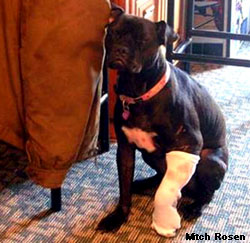 chased
an intruder from her family's New City home on Tuesday. chased
an intruder from her family's New City home on Tuesday.
Kola - a sick 1-year-old black pit bull mix - was found in
New Jersey, its owner Mitch Rosen said.
Yesterday a woman found Kola tied to a pole at a Costco and
then took her to an animal shelter. Rosen later identified
her and took her home.
Rosen said he and his wife entered their home around 2:30
p.m. Tuesday and noticed that a window was broken. They also
noticed muddy footprints in the house and that Kola was gone.
It appears that the dog chased the intruder out
of the house before anything was stolen from the New City
home.
Rosen and his family rescued Kola earlier this year after she
was seized from a dog-fighting ring in Yonkers.
TM &
Copyright 2008 CBS Radio Inc. and its relevant subsidiaries.
CBS RADIO & EYE Logo TM & Copyright 2008 CBS Broadcasting
Inc. Used under license. All Rights Reserved. This material
may not be published, broadcast, rewritten, or redistributed.
TheAssociated Press contributed to this report.
|
|  The
Scoop & Howl The
Scoop & Howl
IRAQI JOURNALIST INSULTS DOGS
Letter
to the Editor of the New York Times
For Iraqi journalist Muntader al-Zaidi
“Dogs
are blameless, devoid of calculation, neither blessed nor cursed
with human motives. They can’t really be held responsible
for what they do. But we can.” JON KATZ
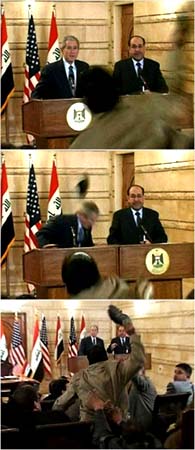 Iraqi
Journalist Hurls Shoes at Bush and Denounces Him on TV as a
‘DOG’ Iraqi
Journalist Hurls Shoes at Bush and Denounces Him on TV as a
‘DOG’
By STEVEN LEE MYERS and ALISSA J. RUBIN
Published:
December 15, 2008

BAGHDAD — President Bush made a valedictory visit on Sunday
to Iraq, ...an Iraqi journalist hurled his shoes at Mr. Bush’s
head and denounced him on live television as a “dog”
who had delivered death and sorrow [in Iraq] from nearly six
years of war.
“This is a gift from the Iraqis; this is the farewell
kiss, you
dog!” yelled Iraqi journalist Muntader al-Zaidi.
Point of
Information: DOGS have never “delivered
death and sorrow” anywhere. MAN has. Why insult DOGS
by calling Bush one of Them.
"Beware
the beast Man, for he is the Devil's pawn. Alone among god's
primates, he kills for sport or lust or greed. Yea, he will
murder his brother to possess his brother's land. Let him not
breed in great numbers, for he will make a desert of his home
and yours. Shun him; drive him back into his jungle lair, for
he is the harbinger of death." From THE PLANET OF THE APES
by ROD SERLING & MICHAEL WILSON
Related story at http://www.from-the-doghouse.com/Scoop_and_Howl.html#Muslims-Dogs
May
the Dogs be with you!
ROBERT COANE
http://www.from-the-doghouse.com

In
Iraqi’s Shoe-Hurling Protest, Arabs Find a Hero (It's
Not Bush)
http://www.nytimes.com/2008/12/16/world/middleeast/16shoe.html?_r=1&hp
|
| 
Pressroom
Press
Release
ASPCA
Responds to New Biden Family Puppy;
Reiterates Tips on Finding Responsible Breeder
NEW YORK,
December 16, 2008
In
response to recent news reports regarding Vice President-Elect
Joe Biden’s new German Shepherd puppy and subsequent reports
that the Pennsylvanian Department of Agriculture just last week
issued five warnings and two citations to the kennel operator
where the puppy was purchased the ASPCA ®(The American Society
for the Prevention of Cruelty to Animals ®) today reminds
potential pet parents of some valuable tips for considering
adding a furry family member to the household or when purchasing
pets from a breeder.
“At the ASPCA, we are happy the Biden family has chosen
to bring a new pet into their home,” said ASPCA President
& CEO Ed Sayres. “Pets provide us with unconditional
love, and I’m sure the Bidens will certainly find a loyal
family companion in their new puppy. But we also want to remind
people who are looking for a breeder, that for the health and
well-being of the dog, they do their homework to find a responsible
one.”
The kennel inspection report said that the owner of the Wolf
Den Kennel in Spring City, Penn., failed to provide records
for dogs purchased or sold, and failed to produce complete rabies
vaccination records for her adult dogs. Warnings for maintenance
and sanitation were also issued after inspectors discovered
a strong ammonia smell inside the house where dogs were kept,
poor ventilation, and broken wires and piping in some outdoor
kennel areas.
Because there are homeless pets awaiting adoption in every community
in the nation, the ASPCA strongly advocates that potential pet
parents ‘make pet adoption their first option’ when
considering bringing a dog or cat into their home. Local animal
shelters offer many choices, whether one’s preference
is dog or cat, small or large, purebred or lovable mutt.
Those who are committed to acquiring a specific breed of dog
should first contact their local chapter of the breed’s
rescue group or locate a responsible breeder. Responsible breeders
are individuals who have focused their efforts on one or a select
few breeds. Through breeding, historical research and ongoing
study, mentoring relationships, club memberships, showing, raising
and training these breeds, they have become experts in the breed’s
health, heritable conditions, temperament and behavior. Responsible
breeders are well-suited to educate and screen potential buyers/adopters
and provide follow-up support after purchase or adoption. Most
importantly, when considering a specific breed, please consider
that responsible breeders do not sell their dogs through pet
stores, but invite their customers to visit their facility and
meet their animals in a comfortable and sanitary environment
to guarantee the safety of their dogs, as well as take lifetime
responsibility for the animals they have bred.
For the ASPCA’s tips on how to find a responsible breeder,
and for more information on how to bring a pet into your home,
please visit http://www.aspca.org .
√
ASPCA Policies and Positions
Position Statement on Criteria for Responsible Breeding |
 BLOG BLOG
Joe Biden Buys One, Gets One Killed
Posted
by Christine Doré
Dec.
12, 2008
I
was extremely disappointed to read that Vice President-elect
Joe Biden and his wife bought a dog from a breeder instead of
adopting one from an animal shelter. Obviously he or his wife
blanked on Ingrid's letter , which asked him to consider adopting
and explained, "Every year, U.S. animal shelters are forced
to euthanize millions of wonderful, deserving dogs and cats
because of the lack of good homes."
Ugh. I'm sorely upset about this—not to mention worried
that his supporters will now all run out and get purebred German
shepherds. I mean, not only is it really out of touch with dog
issues to buy a dog from a breeder—or plain cold-hearted—it's
such a bad idea that one New Mexico county has just banned selling
dogs from pet stores altogether . At least some Americans know
what's up. So what's with our future vice president?
If it weren't bad enough that Biden chose to buy from a breeder,
we are now trying to confirm the accuracy of a report that was
sent to us alleging that he bought his dog from a known puppy
mill operator ! An anti–puppy mill activist who claims
to have firsthand knowledge of this particular breeder's operation
writes, "When I was there, she had dogs living outside
in [I]gloos and a large side building wrapped in blue plastic
… the barking was deafening … her inspection report
states approximately 100 breeding dogs … she sold more
than 275 dogs in 2006 … it was a stupid move on Biden's
part … a puppy mill, for sure." Wow, Biden—if
this is true, you've left us speechless.
Well, we decided to remind Mr. Biden and his home state of Delaware
that every time someone buys a dog from a breeder, a dog in
an animal shelter is killed. We will be running the following
PSA on every station we can in Delaware:
Mr.
Biden may have let us down, but we're still pinning our hopes
on President-elect Obama , who said, "[a] lot of shelter
dogs are mutts like me."
POST
A COMMENT >>> http://blog.peta.org/archives/2008/12/joe_biden_buys.php?c=weekly_enews
|

Awwww!
Joe Biden gets a new puppy
The Vice President-elect's grandchildren will
pick out a name
Dec.
14, 2008
POTTSTOWN, Pa. - You could say the incoming Democratic administration
is already going to the dogs.
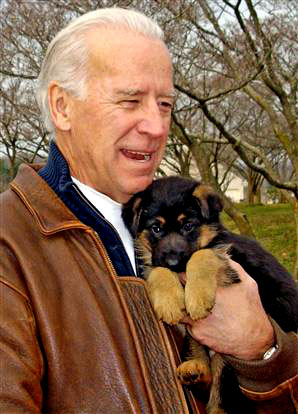 Vice
President-elect Joe Biden has picked out a 3-month-old male
German shepherd from a suburban Philadelphia kennel to bring
with him to Washington. Vice
President-elect Joe Biden has picked out a 3-month-old male
German shepherd from a suburban Philadelphia kennel to bring
with him to Washington.
Biden, riding deep with seven black Secret Service vehicles,
rolled up to German Shepherd breeder Linda Brown’s home
in Chester County, Penn. on Saturday and rolled out having
chosen the nation's Second Dog.
President-elect Barack Obama's children will also be getting
a dog when they move to Washington.
Jill Biden promised her hubby that if he and Obama won the
election they too would buy a dog.
Biden's pup, from Jolindy's German shepherd kennel in Spring
City, will be trained and housebroken over the next several
weeks and delivered after the inauguration.
The owner of the kennel says Biden told her his grandchildren
will get to pick a name.
Mark Tobin, who coordinates the K-9 division for police in
Biden's home county of New Castle, Del., will do the training.
Apparently, Biden had Tobin scout out breeder Linda Brown
beforehand. Brown said Tobin called her up, came to her house
to check her out, and told her she had “beautiful dogs.”
And, that’s pretty much how it all began.
Brown says the Vice President-elect will be relieved to find
his new puppy isn't a political beast. The puppy he chose
is "very even-tempered" she said, and will make
a nice family dog.
|
 ASPCA
Arrests Bronx Man for Cruelty to St. Bernard Mix
ASPCA
Arrests Bronx Man for Cruelty to St. Bernard Mix
December
12, 2008
 On November 20, ASPCA Humane Law Enforcement agents arrested
Bronx resident Cedric Flemming for neglecting his seven-year-old
female dog, Precious. Flemming, 28, was charged with one count
of misdemeanor animal cruelty, punishable by up to one year
in jail and a $2,000 fine.
On November 20, ASPCA Humane Law Enforcement agents arrested
Bronx resident Cedric Flemming for neglecting his seven-year-old
female dog, Precious. Flemming, 28, was charged with one count
of misdemeanor animal cruelty, punishable by up to one year
in jail and a $2,000 fine.
Back in October, when responding to a complaint, ASPCA Special
Agent John De La Torre first discovered the emaciated St. Bernard
mix, about ten blocks north of Yankee Stadium. Agent De La Torre
seized the dog and brought her to the ASPCA’s Bergh Memorial
Animal Hospital, where she was treated for starvation and neglect.
Under the care of our veterinarians, Precious’s gaunt
65-pound frame soon bulked up by 45 percent—after just
one month at the ASPCA, she weighed in at a healthy 94 pounds.
“When she first came in, Precious looked like a walking
skeleton,” remembers Trish McMillan, ASPCA Senior Manager,
Animal Behavior. “She’s now looking a million times
better. You wouldn’t believe she’s the same dog!”
Ready to move on to a happier chapter of her life, this sweet
girl is now available for adoption at the ASPCA’s 92nd
Street Adoption Center. “Precious is a snuggly couch potato!”
says McMillan. “She can be a bit shy at first, but she
warms up to new people quickly—especially for cookies.
Her ideal home would be a quiet one where she’ll be allowed
on the furniture for frequent petting and belly rubs. This is
an affectionate, low-maintenance dog who will lie around and
cause no trouble.”
If you know of an animal whose health is being compromised by
neglect, please report it. In New York City, contact the ASPCA's
anonymous tip line at (877) THE-ASPCA. Visit our Report
Cruelty FAQ to learn how to report cruelty elsewhere.
|

The upscale
Beverly Center Mall in Los Angeles announced it will terminate
the lease of the Hollywood pet store institution, Pet Love.
Wed,
December 10, 2008
Since
last July, Best Friends staff and members like you have been
at the Beverly Center educating potential customers that those
cute puppies at Pet Love really come from cruel puppy mills.
The goal of the Puppy-Store-Free-LA campaign is to convince
stores to offer homeless pets for adoption rather than sell
dogs from puppy mills. We’ve already seen two pets stores
shut down, and now we have the biggest victory we could have
hoped for. Pet Love, a store that sells to the Hollywood elite,
is shutting its doors.
The iconic store has sold tens of thousands of unfixed dogs
in the 15 years they have been in business, adding to the
thousands of animals that clog area shelters and where many
thousands die annually. But thanks to you, tireless efforts
from countless volunteers, and the Best Friends Puppy Mill
Campaign staff, the store will no longer be a part of the
perpetual cycle of abuse.
This is only the beginning. The closing of such a giant in
the pet store industry in LA, like Pet Love, is a huge victory,
but we cannot stop now.


MEMBERSHIP
APPEAL
√ Click on Image
|

News Alert
December
5, 2008
Thinking
of Getting a Puppy This Holiday Season?
Watch
This Video First
√

It’s
the picture-perfect scene: Sweet little Suzy, just turned
three, toddles downstairs to find a new puppy with a big red
bow. And with the latest charismatic canine movies—
Beverly Hills Chihuahua and Marley & Me —hitting
the big screen, purebred Chihuahuas and Labrador retrievers
are bound to be on kids’ lists this holiday season.
Unfortunately, while the giver may have the best intentions,
that cute little pooch most likely came from a substandard
commercial breeding operation, commonly known as a puppy mill
. And with the holiday season upon us, puppy scammers are
on the prowl, hoping to lure shoppers with endearing photos
and phony promises.
If you’re thinking of surprising the family with a new
pet for the holidays, we’re all for it—if you
do it the right way! To help you out, ASPCA President Ed Sayres
and Officer Annemarie Lucas, ASPCA Humane Law Enforcement’s
Supervisory Special Investigator, have prepared a special
video message with tips for determining if a pet really is
the best gift—and if so, where to find your furry bundle
of joy. (Here’s a not-so-subtle hint: your local shelter
or rescue group!)
P.S.
Know someone who’s planning to
give a pup as a present?
Please ask them to watch the video , too!
Fight
Animal Cruelty √

PUPPY
MILLS:
What Is a Puppy Mill? • Laws Protecting Dogs
& Consumers • Where We Stand • Puppy Mill
Timeline • 10 Ways You Can Help Fight Puppy Mills •
Puppy Mill Scams & Cons • Our Rescue Efforts •
Puppy Mill Glossary
|

Dogfighting Subculture Is Taking
Hold in Texas Texas Department of Public Safety
An investigation
into dogfights in East Texas took 17 months, and led to the
seizing of 187 pit bulls and 55 indictments.
By JAMES C. McKINLEY Jr.
Published:
December 6, 2008
HOUSTON — The two undercover agents were miles from any
town, deep in the East Texas  countryside,
following a car carrying three dogfighting fanatics and a female
pit bull known for ripping off the genitals of other dogs. A
car trailed the officers with two burly armed guards, hired
to protect the dog and a $40,000 wager. countryside,
following a car carrying three dogfighting fanatics and a female
pit bull known for ripping off the genitals of other dogs. A
car trailed the officers with two burly armed guards, hired
to protect the dog and a $40,000 wager.
When
the owners of the opposing dog, a crew from Louisiana, got
cold feet and took off, the men in the undercover agents’
party reacted with fury, offering to chase them down and kill
them. The owner of the female pit bull, an American living
in Mexico, was merciful. He decided to take the opposing dog
and let the men live, the officers said.
Over 17 months, the agents from the Texas state police penetrated
a murky and dangerous subculture in East Texas, a world where
petty criminals, drug dealers and a few people with ordinary
jobs shared a passion for watching pit bulls tear each other
apart in a 12-foot-square pit.
Investigators found that dogfighting was on the rise in Texas
and was much more widespread than they had expected. The ring
broken up here had links to dogfighting organizations in other
states and in Mexico, suggesting an extensive underground
network of people devoted to the activity, investigators said.
Besides a cadre of older, well-established dogfighters, officials
said, the sport has begun to attract a growing following among
young people from hardscrabble neighborhoods in Texas, where
gangs, drug dealing and hip-hop culture make up the backdrop.
The investigation here led to the indictments of 55 people
and the seizing of 187 pit bulls, breaking up what officials
described as one of the largest dogfighting rings in the country.
“It’s like the Saturday night poker game for hardened
criminals,” said one of the undercover agents, Sgt.
C. T. Manning, describing the tense atmosphere at the fights.
In between screaming obscenities at the animals locked in
combat, Sergeant Manning said, the participants smoked marijuana,
popped pills, made side deals about things like selling cocaine
and fencing stolen property, and, always, talked about dogs.
Click
√
on image above for full article
Photo:
Texas Department of Public Safety

|

Making history!
by David Dickson
December
5, 2008
Okay,
all you scholastic types. Picture this academic situation:
You've crammed all semester long for 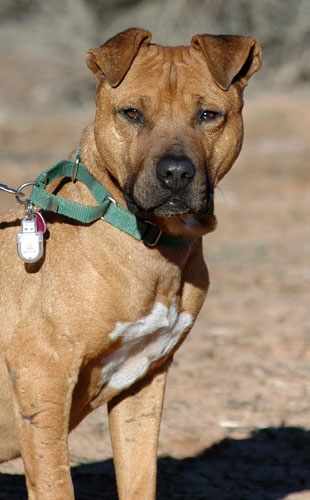 the
final exam. The big day arrives. But, right before the instructor
tells you to pick up your pencil, you sit down on a chair
full of thumbtacks while hundreds of fire ants come spilling
out of your desk to nibble on your arms. Think it'd be easy
to concentrate? Oscar the Vicktory dog didn't think so either.
Thank goodness he had another chance! the
final exam. The big day arrives. But, right before the instructor
tells you to pick up your pencil, you sit down on a chair
full of thumbtacks while hundreds of fire ants come spilling
out of your desk to nibble on your arms. Think it'd be easy
to concentrate? Oscar the Vicktory dog didn't think so either.
Thank goodness he had another chance!
Oscar has been going through the Canine Good Citizen (CGC)
classes at Best Friends. These classes teach dogs good manners,
which helps them find homes and stay there. For Oscar, though,
the stakes were higher. He is one of the 22 dogs who came
to Best Friends after being seized from the property of former
NFL quarterback Michael Vick.
The courts had very specific requirements regarding these
dogs, one of which dealt directly with Oscar's big day. Nine
out of the 22, Oscar included, were required to pass their
CGC tests with a perfect score before they could ever live
in a foster home. One of Oscar's caregivers, Carissa Hendricks,
was determined to help him succeed. She attended the classes
every week and then worked with him on the behaviors as often
as possible. Oscar's biggest issues were loose-leash walking,
becoming too afraid at loud noises, and being confident around
strangers.
Over the weeks, Carissa watched Oscar overcome his problem
areas one by one. She felt sure he would pass his test with
flying colors. Then he hit one little setback. Right before
the big test, they plowed an area of land for the testing
ground. In doing so, they unearthed a whole bunch of goatheads,
nasty little weeds sharp enough to puncture car tires.
During his final practice, Oscar stepped on a bunch of those
nasty little things. No fun! But that really wasn't the worst
of it. When he had to sit and stay for that part of the routine,
he sat unknowingly on a pile of red ants. Ouch! The poor guy,
he was squirming and twisting in a hurry.
Safe to say, that wasn't exactly his shining moment. He took
a week to heal up and regain his focus before the big day
(which they held at a different location). But once the main
test came, boy was he ready. And guess what? He passed! A
perfect score! Oscar is the first of all the Vicktory dogs
to pass his CGC exam and he couldn't be more proud.
This big loveable lug is officially now eligible to join a
foster home once the right person comes along. Congrats, Oscar
and Carissa! Glad that even the ants couldn't slow you down.
Photo
by Molly Wald
|
 California:
Dogfighting Arrests
California:
Dogfighting Arrests
By THE ASSOCIATED PRESS
Published:
December 2, 2008
The
police in Los Angeles said they made two arrests and rescued
17 dogs in the breakup of a dogfighting operation. They said
the outfit was a major player in the illegal training and breeding
of dogs for fighting. Of the 17 dogs, many were scarred and
injured, and all were suffering from severe dermatitis.
|

Fox, Meet Your Enemy (But No Need to Worry)
November
28, 2008
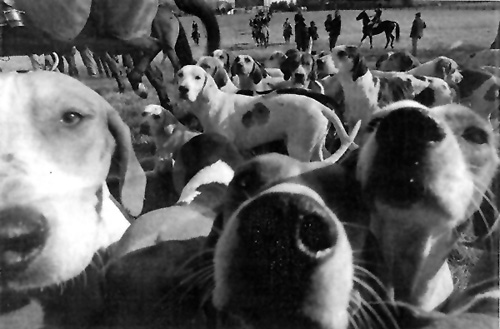
In
northern Maryland, Thanksgiving means it' time for the annualGreenspring
Valley Hunt Club outing. It is described as a fox chase, not
a fox hunt, but otherwise is in keeping with traditions going
back for generations.
The
day began with the blesing of the houndsthat drew more than
125 Dogs and more than 50 horses. Then te hunt -- er chase
-- was on.
Photo:
Mycah Albert for The
New York Times
|
 Beagle
Proves to Be Dog Show’s Best Friend
Beagle
Proves to Be Dog Show’s Best Friend
By RICHARD SANDOMIR
Published:
November 26, 2008
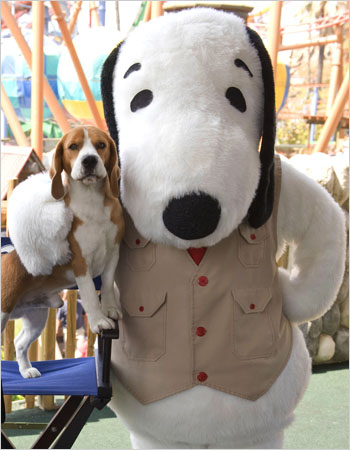 Nine months into his reign as the first beagle to win the
Westminster Kennel Club Show, 3-year-old Uno is not fading
away.
Nine months into his reign as the first beagle to win the
Westminster Kennel Club Show, 3-year-old Uno is not fading
away.He
is the show’s busiest-ever Best in Show titlist.
He was the first one to be celebrated as a champion by President
Bush in the White House Rose Garden last May and still wears
the red, white and blue collar that Laura Bush gave him.
He has thrown out — O.K., he fetched — the first
pitch before major league games at Busch Stadium in St. Louis
and Miller Park in Milwaukee.
His home state of Illinois declared a March day 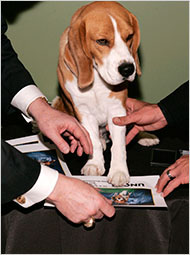 in
his honor (and the lieutenant governor connected Uno to Abe
Lincoln’s dog). in
his honor (and the lieutenant governor connected Uno to Abe
Lincoln’s dog).
Shari Belafonte swept him off a table and walked him on the
red carpet at a Hollywood fund-raiser. He has met the family
of Charles M. Schulz, the “Peanuts” creator who
sired Snoopy, Uno’s ink-on-paper beagle forebear.
About all he has not done since winning the Westminster at
Madison Square Garden and retiring from competition is to
sire any puppies.
PHOTO CREDITS
Top left - Lisa Rose/Associated Press:
Uno, the first beagle to win best in show at Westminster,
with Snoopy at Knott’s Berry Farm in California in March.
Bottom right - Donna Ward/Getty Images: Uno
“signing” autographs.
Click
√ on Snoopy image for full story
|

Weird
but True
Lukas I. Alpert
November
27, 2008
This
guy picked the wrong species to mess with.
An
Ohio K-9 cop chased dow and bit a suspectwanted on dogfighting
charges. As the man ran, the police pooch grabbed him by the
wrist and dragged him to the ground, where two-legged officers
finished making the arrest.
November
26, 2008
Sometimes
man's best friend is not so friendly.
An
Oregon man was shot in the behindwhen his pet pooch jumped
into his boat and accidentally triggered his 12-gauge shotgun.
Matthew
Marcum said Drake is a good Dog and he's not angry over the
pain in his butt.
|

Baggage-sniffing federal beagle retires in style at LAX
By Bob Pool
November
26, 2008
SHILOH,
who has worked for U.S. Customs and Border Protection for eight
years and is responsible 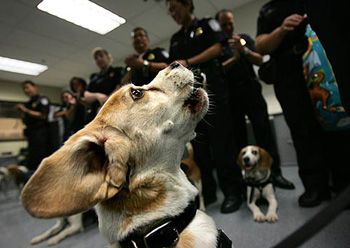 for
about 20,000 interceptions, is applauded by K-9 enforcement
officers during his retirement party in the Customs area at
the Tom Bradley International Terminal at LAX. for
about 20,000 interceptions, is applauded by K-9 enforcement
officers during his retirement party in the Customs area at
the Tom Bradley International Terminal at LAX.
Customs officials, officers and four-legged colleagues turn
out for Shiloh's retirement party. The dog reaches the mandatory
federal retirement age of 9 next week.
The khat dog sniffed out his final smuggler at LAX on Tuesday.
After that, Shiloh the beagle high-tailed it home to Long Beach
to live the high life with his handler, U.S. Customs and Border
Protection Canine Enforcement Officer Donna Kercher.
For nearly eight years Shiloh's keen sense of smell uncovered
fruits, vegetables and other foods possibly infested with dangerous
insects that were carried illegally into the United States by
international travelers. He also scored drugs for customs inspectors.
Last month he intercepted 70 pounds of khat, an east African
and Middle Eastern plant that contains a stimulant called cathinone.
It wasn't the first time he had zeroed in on khat being sneaked
in.
His nose for naughtiness made him top dog at the Bradley International
Terminal, where LAX first employed beagles as sniffer dogs in
1984.
But as a government employee, Shiloh always faced a mandatory
retirement age - in his case 9. On Tuesday, he padded through
the terminal arrival area one last time, giving bulging bags
rolling off the huge luggage carousel the sniff test. When he
found something suspicious, he sat down, alerting Kercher that
something was amiss.
Sometimes it's a false alarm. Food or fruit brought onto the
plane as an in-flight snack was eaten en route, but left its
scent behind. Other times, apples or bananas tucked into carry-on
luggage in Addis Ababa or Bangkok went uneaten and forgotten.
But the threat to U.S. agriculture from pests such as Medflies
and guava flies, or of diseases carried in meats, is significant
enough that incoming food and plants must be seized and destroyed,
officials say.
Over the years, Shiloh has detected more than 20,000 prohibited
agriculture items, said Kercher, 40. With his friendly tail-wagging,
he's managed to do it in a non-threatening way too.
Kercher will continue as an agricultural enforcement officer
working solo, checking bags by unzipping each of them and poking
around corners and into containers with her gloved hands. What
a trained agriculture dog can do in seconds takes 15 or 20 minutes
for a human officer to do fully.
"I'll miss the passenger interaction, parents teaching
children about working dogs. That's really been fun," she
said. "I'm so attached to Shiloh. I don't know if I could
get another dog like him."
During his final rounds Tuesday, Shiloh wore buttons stating
"It's my last day -- 'Bye" and "I'm retiring"
pinned to his uniform -- a blue vest that bore the Homeland
Security emblem and the motto "Protecting American Agriculture."
Attached to his collar was a tiny gold U.S. Customs and Border
Protection badge with the number 58.
A new plant sniffer is joining LAX's 10-dog beagle brigade starting
today. But on Tuesday, seven members of the canine corps lined
up with their handlers to say goodbye to Shiloh. About 25 other
agriculture officers and border protection agency Port Director
Carlos Martel joined them.
Supervising inspector Diana Verity laughed as she recalled how
Shiloh once alerted Kercher to a luggage cart piled with numerous
bags. Kercher "asked which bags? And he put his nose on
two different bags. Turns out there was fruit in both bags."
"Another time he found a sausage hidden in a concealed
place in a bag. He's awesome," said Verity, herself a former
canine officer.
Shiloh and other baggage beagles never get to eat what they
find. Instead, they are rewarded with doggy treats from their
officer-handlers.
But on Tuesday a canine cake was served in Shiloh's honor at
his retirement party. Another agriculture dog handler-officer,
Leticia Hale, baked it with peanut butter, carrots, flour and
honey.
"He's allowed to eat it. He's a civilian," joked U.S.
Customs and Border Protection inspector Michael Fleming.
As the other beagles watched with tongue-dripping envy, Shiloh
eyed the cake and then looked at Kercher for approval. She said
yes.
Shiloh didn't turn up his nose at his one last airport treat.
Photo:
Bob Chamberlin / Los Angeles Times |

Motive in Japanese Stabbings: A Dead Dog
By MARTIN FACKLER
Published:
November 24, 2008
TOKYO — The Japanese police say the motive in last week’s
stabbing deaths of a former health
On
Monday, the police arrested a 46-year-old unemployed man,
Takeshi Koizumi, after he turned himself in for the killings.
He was carrying a blood-stained knife.
 The
police had been investigating whether the killings, which
shocked this low-crime nation, were motivated by recent scandals
involving tens of millions of lost pension records, which
are administered by the ministry. The
police had been investigating whether the killings, which
shocked this low-crime nation, were motivated by recent scandals
involving tens of millions of lost pension records, which
are administered by the ministry.
But Mr. Koizumi told police that he was angry at the ministry
because, decades ago, animal control agents had put to sleep
a stray dog that he had befriended as a child.
Takeshi Koizumi, seen on November 23 while in police custody.
Koizumi who admitted murdering a former top bureaucrat has
said he planned to attack as many as 10 people because of
the
death of his dog, officials said Tuesday.
|
 Ex-NFL
player Vick allowed dogs to savage family pets: report Ex-NFL
player Vick allowed dogs to savage family pets: report
November
22, 2008
RICHMOND, Virginia — Jailed ex-National
Football League star Michael Vick 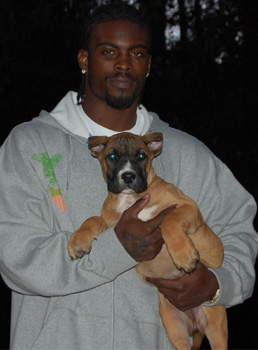 allowed
his fighting dogs to savage family pets, a federal
government agency has said in a report. allowed
his fighting dogs to savage family pets, a federal
government agency has said in a report.
Vick drowned dogs that did not perform well in a five-gallon
pail of water, according to a report released by US Department
of Agriculture on Friday.
The 17-page report also said Vick and his three partners,
Quanis Phillips, Purnell Peace and Tony Taylor, "thought
it was funny" to watch their trained pitbulls kill family
pets and other dogs.
"They drowned approximately three dogs by putting the
dogs' heads in a five-gallon bucket of water."
Vick is back in the state of Virginia to answer state dogfighting
charges, and is being held in protective custody at a Richmond,
Virginia area jail until a hearing on Tuesday.
The former all-star quarterback with the Atlanta Falcons arrived
on Thursday from Kansas, where he is serving a two-year sentence
for a dogfighting conspiracy conviction.
Vick, who was once the highest paid player in the NFL, is
scheduled to be released in July 2009.
------------------------------------------------

In Virginia facing state dogfighting charges, Vick's involvement
revealed
By Kelly Naqi
November 22, 2008
Suspended Atlanta Falcons quarterback Michael
Vick placed family pet dogs into a ring and his trained pit
bulls "caused major injuries" to the pets at Bad
Newz Kennels, according to a U.S. Department of Agriculture
report released on Friday.
The 17-page report, prepared by the USDA's inspector general-investigations
division, provided some new details on Vick's participation
in Bad Newz Kennels, the dogfighting operation financed by
Vick and formed along with his friends Tony Taylor, Purnell
Peace and Quanis Phillips.
Michael Vick is isolated at the Riverside Regional Jail in
Virginia to avoid disruptions.
The report, dated Aug. 28, 2008, says "Vick,
Peace and Phillips thought it was funny to watch the pit bull
dogs belonging to Bad Newz Kennels injure or kill the other
dogs." The report has names and phrases redacted
in order to protect the anonymity of certain individuals who
cooperated with investigators.The report also states in mid-April
of 2007, Vick,
Peace and Phillips hung approximately three dogs that did
not perform well in a "rolling session,"
which indicates the readiness of a dog to fight. According
to the report, the
three men hung the dogs "by placing a nylon cord over
a 2 X 4 that was nailed to two trees located next to the big
shed. They also drowned approximately three dogs by putting
the dogs' heads in a five gallon bucket of water."
Vick initially told authorities "while he assisted Phillips
and Peace in the killing of the dogs, he did not actually
kill the dogs" but "helped Phillips toss several
dogs to the side," according to the report.
However, the report says Vick took back that statement when
he failed a polygraph test. "Vick failed the examination
as it related to the killing of the dogs in April 2007. Ultimately,
Vick recanted his previous statement wherein he said he was
not actually involved in the killing of six to eight dogs.
... Vick admitted taking part in the actual hanging of the
dogs." Vick, the report says, paid someone whose name
was redacted $100 to dig two graves for the dog carcasses.
"Based on past circumstances," the report says,
"Phillips and Peace did not like [Vick] to do any type
of work that could injure him and jeopardize his NFL contract."
When the person who dug the graves refused to bury the animals,
the report says, Vick, Peace and Phillips buried the dogs
themselves.
Vick is serving a 23 month sentence in a minimum security
federal prison camp in Leavenworth, Kan., on a conspiracy
charge relating to the interstate dogfighting operation he
helped run on a property he owned in Surry County, Virginia.
Vick is scheduled to be released on July 20, 2009.
Vick is currently being held in protective custody at Riverside
Regional Jail in Hopewell, Va., until his hearing on Tuesday
in Surry County Circuit Court to plead guilty to two state
charges related to dogfighting. The state charges -- one count
of torturing and killing dogs and one count of promoting dogfighting
-- each carry a maximum prison term of five years. But under
the terms of his plea agreement, Vick is expected to receive
a three-year suspended prison term and a $2,500 fine (which
would be suspended if he pays court costs and maintains good
behavior for four years).
By resolving the pending state charges, Vick would qualify
to participate in the Federal Bureau of Prisons re-entry program,
which could enable him to serve part of the remainder of his
federal sentence in a halfway house.
According to the Bureau of Prisons, in 2007, for inmates who
qualified, the average length of their time served at a halfway
house was three months.
Vick, who was once the NFL's highest paid player, has been
washing pots and pans for 12 cents an hour, according to Falcons
owner Arthur Blank, who has said he's kept in touch with Vick
through written correspondence. Blank said Vick also told
him he's passing the time and staying in shape by playing
quarterback for both sides during prison football games. Vick,
28, is still under contract with the Falcons.
National Football League Commissioner Roger Goodell suspended
Vick indefinitely without pay on Aug. 24, 2007, and has said
he will review the status of Vick's suspension following the
conclusion of Vick's legal proceedings.
Vick's lawyers, the NFL and the Falcons were not immediately
available for comment.
|

Dog
Drives Van into L.I. Coffee House
Thursday,
20 November 2008
ST. JAMES, N.Y. (AP) -- A dog left inside a running
van put the vehicle in drive, causing it to crash into  a
Long Island coffee house. a
Long Island coffee house.
Suffolk County police say no one was injured in the incident,
which damaged the glass window and some patio furniture at
Cool Beanz coffee shop in St. James.
Police say a 60-year-old Port Jefferson resident left the
van running while he went into the shop. His dog, Bentley,
somehow knocked the controls and it rolled into the building,
smashing some patio furniture and damaging the storefront
window, police said.
No one was hurt.
It's not immediately clear if cops ticketed Bentley for driving
without a license.
==================================
Conn.
Woman Will Go to Trial in Death of Starved Dog
Thursday,
20 November 2008
BRISTOL, Conn. (AP) -- After being denied probation,
a Plymouth woman accused of starving her 4-year-old dog to
death is headed to trial. 
Thirty-one-year-old Jessica Watson, who lives in the Terryville
section of Plymouth, faces one count of animal cruelty after
allegedly refusing food and water over a three-week span to
the dog, Gizmo, a pit bull.
Watson was arrested on Feb. 17.
A Bristol Superior Court judge has denied her application
for accelerated rehabilitation, which would have led to erasing
the charge from her record.
Watson's former neighbors discovered the dog on Jan. 17 in
the back of a garage bay attached to the apartment Watson
was living in at the time.
Officials confirmed that the pit bull died of starvation.
|

Banker
Pleads Guilty To Killing Landlord's Terrier
Thursday,
20 November 2008
NEW YORK (AP) -- A banker who was accused of stomping
and beating his landlord's Boston terrier to death pleaded
guilty Wednesday to misdemeanor animal cruelty charges.
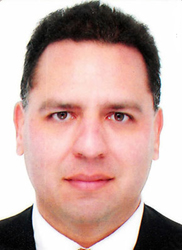 Tafik Habib,
40, pleaded guilty to ``overdriving, torturing and injuring''
an animal, a violation of the state's agricultural law. He
admitted to the court he kicked the 15-pound, nearly 3-year-old
dog and beat her with an umbrella.
Tafik Habib,
40, pleaded guilty to ``overdriving, torturing and injuring''
an animal, a violation of the state's agricultural law. He
admitted to the court he kicked the 15-pound, nearly 3-year-old
dog and beat her with an umbrella.
The terrier, named Sasha,
had a litter of 7-week-old puppies. Her owner, Elefterios
Bonaros, wept profusely as Habib pleaded guilty to killing
the dog on Jan. 10 in Bonaros' Upper West Side Manhattan apartment.
Habib's plea deal requires him to do 175 hours of community
service at an AIDS hospice, pay $160 court costs, and spend
six days in jail.
State Supreme Court Justice Carol Berkman told Habib, ``I
happen to be an animal lover myself,'' and warned that she
would give him more jail time if he does not successfully
complete the community service.
Habib faced up to a year in jail if he had been convicted
after trial.
Earl Ward, Habib's lawyer, said his client moved temporarily
from an unidentified city in Florida to Manhattan for job-related
reasons and rented a room in Bonaros' apartment.
Bonaros said his tenant let him know quickly that he did not
like dogs.
``He said they were useless and served no purpose,'' the distraught
Bonaros said.
Bonaros, 51, said he left home for 20 minutes while Habib
was out. ``When I got back I knew something was wrong because the dogs didn't come to meet me,'' he said
in the courthouse lobby.
was wrong because the dogs didn't come to meet me,'' he said
in the courthouse lobby.
Bonaros said he found Sasha inside, covered with a towel.
``He had smashed her head and face with his foot,'' he said
as he began sobbing again.
He said Sasha's mate, Rocky, died months later of a broken
heart.
A large, burly man and retired travel agency owner, Bonaros
said he considered attacking Habib but didn't do it.
The puppies were not injured. Two of them, Sashita named for
her mother and Gizmo, still live with Bonaros; siblings Snowball
and Sparky were adopted.
Bonaros also has two of Sasha's offspring from a previous
litter, Petey and Bam Bam.
|

More
than a 100 animals perish in pet shop fire
BY DORIAN BLOCK AND LEO STANDORA
Thursday,
November 20th 2008
More than 100 frantic birds, reptiles and small animals died
trapped in their cages Wednesday when fire  raged
through a Bronx pet shop. raged
through a Bronx pet shop.
The blazing end to Stephanie and Amanda's Pet Center on Southern
Blvd., a favorite attraction for kids in their Morrisania
neighborhood, sent its owner home in tears when he realized
almost all was lost.
"He couldn't take it. He just couldn't stay and watch
what was happening," said 52-year-old Joel Rivera, who
manages the shop for his cousin, David Rivera.
"He's been here 30 years and all of a sudden, it's all
gone. His business, the animals, all gone. Maybe we can start
all over again," he said, wiping away tears with the
back of his hand.
A dry cleaner and a photo shop next to the pet shop also burned
down, and a nearby five-story apartment building was evacuated
but sustained only minor damage. No one in the buildings was
injured.
Rivera said many of the 140 firefighters summoned to the three-alarm
blaze risked their lives to save as many of the doomed creatures
- parrots, parakeets, rabbits, guinea pigs, lizards and other
reptiles, at least two cats and a pair of guard dogs - as
they could.
"I got the lizards and they got two of our three macaws,"
which were worth $2,000 each, he said. "They tried to
get other animals out, but they couldn't. There were too many
cages, maybe 50 to 60, and too much fire."
"I'll miss them, all of them," Rivera said. "I
used to play with the parrots. I'd put them on my shoulder.
I was with them all the time. And the rabbits, all the kids
around here loved them. They used to come in and take their
pictures."
Fire officials said the blaze erupted in Urrego Alba Cleaners
at 1105 Southern Blvd. about 4:15 p.m. and quickly spread
to the other buildings. The cause was under investigation.
During the height of the fire, which wasn't brought under
control until about 7 p.m., several blocks of Southern Blvd.
were cordoned off in both directions. Service on the elevated
No. 2 and 5 subway lines was suspended between E. 149th and
E. 180th Sts. Transit officials said thick smoke billowing
from the buildings was near the tracks and creating an unsafe
situation.
|

Weird
but True
David K. Li, Wire Services
November
18, 2008
British
veterinarians want big Dogs and fat cats to shed their girth.
Seven
Dogs and a Cat --all at least 30% over their desired weight
-- will be put on a 100 day diet and exercise regimen as part
of a study to see if they can drop 162 collective pounds.
"Owners
often show their affection by giving unhealthy human treats
[to pets] .... Theu don't realize they are actually killing
their pets with kindness," said vet Sean Wensley.
|
 Dogfighting
Ring Is Broken Up in Texas
Dogfighting
Ring Is Broken Up in Texas
By JAMES C. McKINLEY Jr.
Published:
November 16, 2008
HOUSTON — State officials said late Friday that they had
begun dismantling one of the largest dogfighting rings in the
country that night, arresting eight people and seizing 187 dogs
used by a sophisticated network of bettors throughout eastern
Texas . Investigators continued to search for suspects Saturday.
In all, 55 people were indicted after an undercover investigation
that lasted 17 months. Officials said the network’s matches
drew crowds of up to 100 people, who placed tens of thousands
of dollars in wagers on a single fight.
“This was a large-scale, highly organized operation,”
said Lisa Block, a spokeswoman for the Texas Department of Public
Safety.
It was not uncommon for a gambler to put $500 to $1,000 down
on the matches, which took place weekly or twice a month at
eight sites in secluded parts of Harris County, where Houston
is the largest city, law enforcement officials said.
The events were by invitation only. “They didn’t
go out in the street and advertise it,” Ms. Block said.
“They would spread the news among themselves.”
Because the ring members invited only people they knew to the
fights, undercover agents from the state police infiltrated
the group to gather evidence and even managed to videotape some
of the matches, officials said. The investigation started after
troopers received a tip from someone in another state about
the fights, Ms. Block said.
Many of the participants in the ring bred the dogs themselves,
buying and selling animals back and forth with other members.
Most of the dogs seized were pit bull mixes bred and trained
to fight. They were kept in large kennels in rural areas northeast
of Houston. Some of the dogs had been injured in fights and
were being cared for by the Houston Humane Society.
During raids to seize the animals, state troopers also found
firearms, marijuana, cocaine and stolen property, the authorities
said. But the indictments charged the defendants only with engaging
in dogfights, a felony that carries up to two years in prison,
or misdemeanor charges of being a spectator at a dogfight, which
carries up to a year in jail. |
 Cell
Phone Sniffing Dogs Added to N.J. Prisons
Posted: Sunday,
16 November
Cell
Phone Sniffing Dogs Added to N.J. Prisons
Posted: Sunday,
16 November
NEWARK, N.J. (AP) -- New Jersey prison officials
are trying a new approach to detect illegal cell phones among
the inmate population: cell phone-sniffing Dogs.
New Jersey Department of Corrections Spokesman Matt Schuman
tells The Press of Atlantic City that other methods prisons
use to detect illegal cell phones, such as metal detectors or
machines that track usage, require the phones to be turned on.
He says the Dogs are trained to detect the scent of the phone
itself.
Schuman says 217 cell phones were confiscated in New Jersey
prisons since October of last year.
Prison officials say cell phones are sought-after contraband
because they can be used to transmit pictures or sensitive information
about a facility's layout, or conduct drug deals or other illicit
activities. |

W. ATTACK DOG A SERIAL BITER
AP
November
15, 2008
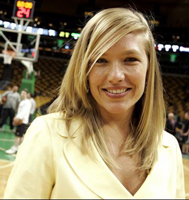 Turns
out that when it comes to biting White House visitors, First
Dog Barney is a repeat offender. Turns
out that when it comes to biting White House visitors, First
Dog Barney is a repeat offender.
Boston Celtics public-relations director Heather Walker said
yesterday that Barney bit her wrist and drew blood as she
tried to pet the Scottish terrier in September after a White
House ceremony honoring the team's 17th NBA championship.

"It was very strange. I didn't expect him to bite me,"
Walker said. She added that the White House staff "was
very nice" and asked if she needed help, but all she
needed were some Band-Aids from the Celtics' team physician.
Sally McDonough, a spokeswoman for First Lady Laura Bush,
said she was unaware of the incident.
Last week, Barney bit Reuters reporter Jon Decker's index
finger when he reached down to pet the seemingly docile dog. |
 Animal
relief reaches Cuba
Animal
relief reaches Cuba
World Society for the Protection of Animals
Fri, November
14, 2008
WSPA's
historic disaster relief work for animals in Cuba begins.
WSPA's relief efforts for animal victims of recent hurricanes
in Cuba - the first ever intervention of its kind in the country
- is rapidly getting underway. The final shipment of our $100,000
relief program arrived this week, and our team aims to treat
at least 42,000 companion and working animals in the areas
affected by the hurricanes.
The team is headed by animal welfare experts from our office
in Costa Rica and will provide vital vaccinations and veterinary
care that will help animal as well as the people who depend
on them.
This will make WSPA the first animal welfare organization
in history to conduct an animal welfare disaster relief operation
in Cuba. We have the full support of the Cuban government,
who has welcomed our mission and offered the entire nation's
veterinarians to work with us in this unprecedented large-scale
operation. |

Well: Dogs and Autism
November
14, 2008
A legal battle in New York City highlights the healing power
of Dogs for children with autism and Asperger’s syndrome.
Manhattan federal prosecutors have accused the owners of an
Upper East Side residence of discriminating against 11-year-old
Aaron Schein by preventing him from having a Dog, The New
York Daily News reports . Aaron has been diagnosed with Asperger’s
syndrome, often considered a high-functioning form of autism,
and his doctors believe a Service Dog will relieve anxiety
and help him cope with the disorder. People with Asperger’s
usually have average or above-average intelligence, but they
lack the intuitive ability to read social cues and find it
difficult to make friends and form relationships.
According to the newspaper, a lawsuit claims the building
owners violated the Fair Housing Act by imposing unreasonable
demands on Aaron’s parents before allowing a Dog.
“It is not right or legal for landlords to dictate the
unreasonable terms and conditions by which persons with disabilities
should live their lives,” said Kim Kendrick, an assistant
secretary for the federal Housing and Urban Development Department,
to the newspaper.
After Aaron’s parents asked the co-op board to make
an exception to the building’s strict no-pets rule,
the building placed stringent conditions on the family. Among
the restrictions reportedly imposed by the building: the Dog
couldn’t be left alone for more than two hours, it would
have to be taken in and out of the building on a service elevator,
monitoring of Dog walkers who might take it for a stroll,
and $1 million in liability insurance for any injury or property
damage caused by theDog. A company-hired doctor reportedly
agreed the Dog was medically necessary.
The family is asking a judge to allow them to bring the Dog
home and award monetary damages because Aaron was discriminated
against under the Americans With Disabilities Act, The Daily
News reports. |

Dog
on mend from fatal fire
Owner died after refusing to leave home without
pet
BY DAN ROZEK
November
14, 2008
CICERO
-- Regis is on the
road to recovery, but he's not there yet, said the veterinarian
treating the  13-year-old
mixed-breed Dog that survived a Cicero house fire after
his owner refused to flee the burning home without him. 13-year-old
mixed-breed Dog that survived a Cicero house fire after
his owner refused to flee the burning home without him.
Regis' owner, 68-year-old John Petrik died of heart disease
and smoke inhalation after being removed from his home early
Wednesday by firefighters. Regis is being treated for injuries
at the A American Veterinary Hospital in Oak Park.
Petrik initially refused to leave without his beloved Dog,
which was rescued later by firefighters -- though the 55-pound
German Shepherd mix suffered smoke inhalation and a burned
tail.
On Thursday, Regis showed signs of improvement -- including
resuming eating -- but he was still having difficulty walking,
possibly because of the smoke he inhaled, said Cesar Agustin,
the Oak Park veterinarian treating him for his injuries.
"He's much better, but he's not 100 percent yet,"
said Agustin, who added he was "highly optimistic"
the Dog would recover.
The dog was given oxygen treatment and antibiotics, along
with a salve for his burned tail, though Agustin is still
awaiting the results of blood tests to see if he suffered
internal injuries. Regis also was treated for fleas.
"He's more comfortable today than he was before,"
Agustin said. "But we're taking it day by day. We don't
want to release him too soon."
(Photo:
Richard A. Chapman/Sun-Times)
|

Weird
but True
Lukas I. Alpert
November
12, 2008
There's
nothing holy about this.
A
man imprting bottles labeled "holy water" from
Canada at the Niagara Falls border crossing was busted when
a federal drug-sniffing Caninegot a whiff of the stuff.
It
turned out the liquid was ketamine, a tranquilizer
sometimesused illegally as a club drug.
|

CINDY
ADAMS
Nov.
11, 2008
 THE
first family-elect wants a Dog, right? Let it be known Elton
John once went for nearly $20 grand to buy Tiffany diamond-encrusted
collars for the resident hounds at Leatherne Bottel, the
pub near his Oxfordshire home . . . Mariah Carey's love
for Jack, her Jack Russell, was such that she had him flown
first class - $2,850 at the time - to her in LA . . . THE
first family-elect wants a Dog, right? Let it be known Elton
John once went for nearly $20 grand to buy Tiffany diamond-encrusted
collars for the resident hounds at Leatherne Bottel, the
pub near his Oxfordshire home . . . Mariah Carey's love
for Jack, her Jack Russell, was such that she had him flown
first class - $2,850 at the time - to her in LA . . .
Brandy's puppy traveled in a $1,000 Louis Vuitton carrier
. . . Anne Heche's Papillon has $550 cashmere blankets .
. . Jim Carrey's Chocolate Lab, Hazel, calls a $20,000 three-room
doghouse complete with sofa, home . . .
At a photo shoot for a winter 2001 issue of Wendy Diamond's
Animal Fair Magazine, Kim Cattrall didn't want her Dogs
in a measly sedan. They required a limo . . . While she
was prepping her Fisher Island, Fla., home, Janet Jackson's
Rottweiler, Riley, stayed in his own $200-a-night room at
the Waldorf Towers in South Beach.
Neil Diamond hires a private jet to fly his pets with him
. . . Julia Roberts' Diego had a few Dog days at Citizen
Canine Bed and Breakfast, a cageless facility where "guests"
dip in the pool and hop onto a
human-style bed . . . Vince Vaughn named his three Vero,
Viking and Vladimir . . . At her wedding, Sissy Spacek's
Dog acted as her witness. The paw print appears on the marriage
certificate . . . Alan Alda's
father, Robert, had his Cocker Spaniel, Rhapsody, stuffed
when he died . . .
Ashley Judd dyed her Dog's fur blue and white, the basketball
team colors of her University of Kentucky alma mater . .
. And there's the time Sigourney Weaver staged an elaborate
wedding for her Italian Greyhound complete with prenuptial
agreement . . .
So,
might the future First Dog be called Bark
Obama?
|

G.O.P.
Dog Days?
By
William Kristol
Published:
November 10, 2008
Just before midnight on Nov. 4, I wasn’t that worried.
Sure, the election results had been bad — but they
weren’t devastating.
• • •
...this was a good Democratic year, but it is still a center-right
country. Conservatives and the Republican Party will have
a real chance for a comeback — unless the skills of
the new president turn what was primarily an anti-Bush vote
into the basis for a new liberal governing era.
Those
were my thoughts when, a few minutes into his victory speech,
just after midnight, Obama told his daughters, “And
you have earned the new puppy that’s coming with us
to the new White House.”
I gulped.
Not
out of my deep affection for dogs, fond of them though I
am. But because while we’ve all known that Obama is
a very skillful politician, he hasn’t until now been
a particularly empathetic one. Competence plus warmth is
a pretty potent combination. Suddenly visions of the two
great modern realigning presidents — Franklin Roosevelt
(with his Scottish terrier Fala) and Ronald Reagan (with
his Cavalier King Charles spaniel Rex) — flashed before
my eyes. Maybe a realignment could be coming.
Obama was, naturally, asked about the promised-but-not-yet-purchased
puppy at his press conference Friday. (If one were being
churlish, one might say that it was typical of a liberal
to promise the Dog before delivering it. A results-oriented
conservative would simply have shown up with the puppy without
the advance hype.)
Obama commented wryly that the canine question had “generated
more interest on our Web site than just about anything.”
He continued:
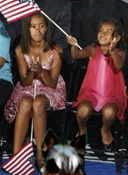 “We
have two criteria that have to be reconciled. One is that
Malia is allergic, so it has to be hypoallergenic. There
are a number of breeds that are hypoallergenic. On the other
hand, our preference would be to get a shelter dog, but,
obviously, a lot of shelter dogs are mutts like me. So —
so whether we’re going to be able to balance those
two things, I think, is a pressing issue on the Obama household.” “We
have two criteria that have to be reconciled. One is that
Malia is allergic, so it has to be hypoallergenic. There
are a number of breeds that are hypoallergenic. On the other
hand, our preference would be to get a shelter dog, but,
obviously, a lot of shelter dogs are mutts like me. So —
so whether we’re going to be able to balance those
two things, I think, is a pressing issue on the Obama household.”
Here, in a few sentences, Obama did the following: He deepened
his bond with every dog lover in America. He identified
with every household that’s tried to figure out what
kind of dog to get. He touched every parent with a kid allergic
to pets. He showed compassion by preferring a dog from a
shelter. And he demonstrated a dry and slightly politically
incorrect wit by commenting that “a lot of shelter
dogs are mutts like me.”
Not bad. It could be a tough four or eight years for conservatives.
• • •
So
Obama will be formidable. But conservatives should welcome
the challenge. It’s good for conservatism that conservatives
will have to develop refreshed ideas and regenerated political
skills to succeed in the age of Obama.
And
it wouldn’t hurt for Governors Sarah Palin, Mitch
Daniels, Bobby Jindal and the other possible 2012 G.O.P.
nominees to begin bringing some puppies home for their kids.
|

 Dogs
nail dumb-ashes Dogs
nail dumb-ashes
Erik Shilling
November
8, 2008
Tobacco sniffing Dogs have been deployed to the former Deutsche
Bank building to ensure nicotine-addicted workers don’t
light up on the job and spark another deadly fire.
For
the past month, the Lower Manhattan Development Corporation
has resorted to deploying “tobacco detection Canine”
teams at the building.
Careless smoking by workers inside the condemned building
is blamed for the August 18, 2007, fire that killed two
firefighters. One year later, investigators found beer cans
and empty cigarette packs inside the building left behind
by workers.
“This is just one part of the project team’s
multifaceted approach to ensuring that all site regulations
are strictly followed and enforced,” said LMDC spokesman
Mike Murphy.
Photo:
Gregory P. Mango
|

Weird
but True
Lukas I. Alpert
November
8, 2008
Give
this Dog a license.
A
pooch left in a car at a carwash slipped the vehicle into
gear and drove it out unto an Oklahoma highway and then
back into the parking lot. -- and no one got hurt.
Police
impounded the car because the dogged driver could not provide
proof of insurance.
|

Election
day brings two critical victories for animals in the United
States: Elections go to the dogs (and pigs, cows, and chickens)
November
7, 2008
On November 4th voters across the United States turned up
in record numbers to make their voices heard for the Presidential
election as well as for many crucial state and local initiatives.
We're thrilled to report that among these, voters passed
two historic ballot initiatives that will greatly improve
the lives of animals.
Massachusetts:
The Greyhound Protection Act
 Fifty-six
percent of Massachusetts voters spoke up for greyhounds
by voting “Yes” for a ballot initiative that
will phase out commercial dog racing in the state by 2010.
Despite a major advertising campaign launched by the opposition,
over 1.6 million people voted in favor of the initiative.
This is a huge victory for the many animal welfare groups
and volunteers who worked hard to get this measure passed
and will have a direct impact on the over 1,000 greyhounds
at Massachusetts's two racing tracks. These dogs will
no longer have to spend twenty hours a day confined in small
stacked cages and risk injuries associated with racing including
broken bones, paralysis, seizure, head trauma and death. Fifty-six
percent of Massachusetts voters spoke up for greyhounds
by voting “Yes” for a ballot initiative that
will phase out commercial dog racing in the state by 2010.
Despite a major advertising campaign launched by the opposition,
over 1.6 million people voted in favor of the initiative.
This is a huge victory for the many animal welfare groups
and volunteers who worked hard to get this measure passed
and will have a direct impact on the over 1,000 greyhounds
at Massachusetts's two racing tracks. These dogs will
no longer have to spend twenty hours a day confined in small
stacked cages and risk injuries associated with racing including
broken bones, paralysis, seizure, head trauma and death.
WSPA's USA office in Boston is especially thrilled that
Massachusetts will no longer be one of only 10 states where
commercial dog racing is still legal and operational, and
we hope this measure will inspire other states to take similar
actions.
California: the
Prevention of Farm Animal Cruelty Act
In California a wide majority of voters - 63% - approved
Proposition 2, an initiative to pass the  Prevention
of Farm Animal Cruelty Act. This landmark victory
will improve the lives of nearly 20 million farm animals
who are currently confined and crammed into cages on factory
farms throughout California. By phasing out the use
of battery cages, gestation crates, and veal crates, the
law not only benefits animals in California, but also sends
a strong message that these confinement methods are cruel
and should be banned. Prevention
of Farm Animal Cruelty Act. This landmark victory
will improve the lives of nearly 20 million farm animals
who are currently confined and crammed into cages on factory
farms throughout California. By phasing out the use
of battery cages, gestation crates, and veal crates, the
law not only benefits animals in California, but also sends
a strong message that these confinement methods are cruel
and should be banned.
Congratulations
to California for joining a growing number of states, as
well as several countries across the world, who have voted
to ban these cruel confinement systems.
|
 POOCH
MOOCH RAPPED
POOCH
MOOCH RAPPED
WALKER ON SHORT
LEASH
By DAREH GREGORIAN and ERIK SHILLING
November
7, 2008
Bad Dog walker! Bad!
A Manhattan judge has curbed a Dog walker who was allegedly
poaching customers from a TriBeCa kennel, ordering him not
to walk pooches within a 10-mile radius of lower Manhattan.
State Supreme Court Justice Debra James signed off on the
no-Dogs-allowed temporary restraining order after finding
that Brian Mestre, of Queens, had signed a non-compete agreement
while working for the Paw Stop on Murray Street.
Despite the agreement, Mestre, 27, quietly set up his own
company and was siphoning customers from the upscale kennel
while working as its employee, court papers charge.
"He was nice, young kid who worked hard and had an excellent
demeanor, but sometimes nice people f- - - you over,"
said Paw Stop owner Dan Rubenstein, 37.
He estimated that Mestre's alleged two-timing cost his business
at least five customers and $130,000.
Mestre's lawyer, Lawrence Goodman, however blasted the judge's
ruling and said his client was considering an appeal.
"The court has prevented my client from earning a livelihood
based on its reasoning that walking a Dog is somehow unique
or extraordinary," Goodman said.
Mestre had been hired in January 2007 "as a front-desk
receptionist, kennel manager, driver and assistant Dog trainer,"
court papers say.
Rubenstein said that by July, Mestre had earned a raise and
a promotion.
It was then, the Paw Stop suit says, that he signed the non-compete
agreement and gained access to "confidential information,
specifically the client database, which he used to create
his own independent dog-service company."
Rubenstein said he found out that Mestre had been throwing
himself a few bones this past May, when he was out for a jog
and saw Mestre walking a former client's Dog by the West Side
Highway. When Rubenstein asked him about it the next day,
Mestre admitted he had started his own company, and his customers
were Paw Stop customers, his suit says.
Mestre was fired - "Don't come into my business and be
a corporate raider," Rubenstein said - but allegedly
kept busy with Paw Stop customers after he was let go.
Rubenstein's suit seeks unspecified money damages, as well
as enforcement of the non-compete clause, which bars Mestre
from operating Dog-related services within a 10-mile radius
of the Paw Stop. |
 Readers’
Responses: 4 Paws, So Many Choices
Readers’
Responses: 4 Paws, So Many Choices
By Katharine Q. Seelye
November
6, 2008
The blogosphere has gone Dog crazy since President-elect Barack
Obama announced Tuesday night that he intended to fulfill
a campaign promise to his daughters, who, he said, had “earned”
a puppy.
But purebred or Mutt? From a shelter or a breeder? Puppy or
adult?
The big decision has galvanized dog lovers around the country,
who have inundated Web sites with their recommendations, and
readers of nytimes.com joined the hunt . Many said they hoped
Mr. Obama’s daughters, Malia, 10, and Sasha, 7, could
get whatever kind of Dog they wanted, without political consideration.
“Those two little girls are about to walk into what
is most likely the strangest family experience on the planet,”
one reader wrote. “That family should select their Dog
without worrying about who their choice might offend, and
whatever puppy they get, his or her job will be to bring some
kind of normalcy to those kids.”
Most advised going to a shelter, as the Obamas have said they
intend to do. “As a volunteer at the local shelter,
I think it would be a great message to the country about the
benefits of adopting a Dog, and I like the political spin
that in America, any Dog can make it to the White House,”
one wrote.
Several readers said the discussion was frivolous for these
somber times — before going on to give a plug for the
breed of their own Dogs. Scores of breeds were recommended
— again, usually the breed owned by the reader. Some
were mindful that Malia has allergies. “Half-Labrador/half-Poodles
are hypo-allergenic, smart and loving,” one reader wrote.
“Our Scout is the most amazing pup around.”
A few readers went rogue. “In the interest of reaching
across the aisle,” one wrote, “they should seriously
consider also getting a kitten.”
At least one reader expressed a vested interest. “As
the editor and publisher of the Scottish Terrier and Dog News,
I am understandably sad to see the Scotties leaving the White
House,” he wrote, referring to President Bush’s
Dogs, Barney and Miss Beazley, above. “There goes a
regular source of news.” |

The Huffington Post, The Washington Post
White House Stalwart Attacks Reporter; Blood Drawn,
Physician Consulted
by
Matt Haber
Nov.
6th, 2008
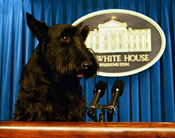 The
White House The Washington Post 's Al Kamen reports that
Barney,
President George W. Bush and First Lady Laura Bush's Dog,
tried to bite a reporter from Reuters . (This comes via
The Huffington Post's Media vertical .) The
White House The Washington Post 's Al Kamen reports that
Barney,
President George W. Bush and First Lady Laura Bush's Dog,
tried to bite a reporter from Reuters . (This comes via
The Huffington Post's Media vertical .) 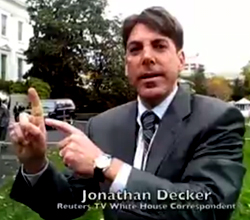
Writes Mr. Kamen:
Reuters television White House correspondent Jon Decker
reports that President Bush's Dog Barney, going on a walk
this morning on the North Lawn, let his reaction to the
news show.
He 'bit my right index finger this morning—as I reached
down to pet him,' Decker said. The bite broke skin and the
wound was bleeding enough to prompt White House physician
Dr. Richard Tubb to treat Decker with antibiotics. He will
also be getting a tetanus shot.
A Presidential pardon may be in order.
View
http://www.youtube.com/watch%3Fv%3D9myqGe_B2vE
|
 DNA
testing kit offers peek-a-poo into dog's family tree
BY
MARIE MCGOVERN
DNA
testing kit offers peek-a-poo into dog's family tree
BY
MARIE MCGOVERN
Tuesday,
November 4th 2008
Sure,
you know your Dog's a Mutt - but
what exactly is he?
Well, that's why there's a doggie DNA test kit on the market
called the Canine Heritage XL Breed Test that claims it can
identify more than 100 breeds.
"Most people are simply curious about their Dog's background,"
said Theresa Brady of MetaMorphix, Inc., the company that
pioneered DNA testing in Dogs more than a decade ago. "Behavior
and health issues are other reasons people buy the kit."
Be it a Chorkie (Chihuahua/Yorkshire terrier), Peek-a-poo
(Pekingese/poodle), Sheprador (German Shepherd/Labrador retriever)
or Bagel hound (Beagle/Basset Hound), Brady says her crew
can figure it out.
"If your Dog is a digger, then there's probably some
Terrier in him," Brady said. "Knowing what kind
of breeds you're dealing with will help in training."
Doggie DNA testing is not cheap: This kit will run you about
$120.
A simple swab of your Dog's cheek is all that's needed. Mail
the pouch to a testing lab in California, and six weeks later
you've got your results.
The test could only identify 38 breeds when the kit was originally
released last year.
"The extraordinarily positive response to our first product
prompted us to continue our [research and development] efforts
and to add more breeds," said Dr. Edwin Qualltebaum,
CEO of MetaMorphix, Inc.
The company's most famous client may be "Today"
show host Meredith Vieira, who found out her Mutt Jasper was
not part Poodle like she thought - but a combination of Collie,
Shetland Sheepdog and Borzoi. |

Blog
Posts
Dog Risks Life for Kittens
Posted by: Neatorama
Monday,
October 27, 2008
A Dog named Leo stayed behind in a burning home in Melbourne,
Australia, to  guard
a box of kittens! Four family members and one Dog escaped the
fire. guard
a box of kittens! Four family members and one Dog escaped the
fire.
“But Leo was still inside standing over the kittens, and
we were scared he would get burned,” she said. “We
couldn’t find Sabrina (mother of the kittens) and we thought
they would all die.”
The children sobbed with relief when firefighters rescued and
revived 11-month-old Leo.
“Then we were told there was a box of kittens still in there,
and firefighters returned to grab them too,” Cdr. Brown
said. He said Leo licked the kittens with joy when he saw them.
“It was a wonderful sight,” he said.
The kittens were unharmed because a cover on their box stopped
them suffering smoke inhalation.
Firefighters plan to nominate Leo for an honor to acknowledge
his bravery. |

Movie Review
Roadside Romeo
Yash Raj Films & Walt Disney Pictures
By RACHEL SALTZ
Published:
October 25, 2008
With the animated dog’s-life feature “Roadside
Romeo,” Bollywood continues its technological  juggernaut.
A co-production of Yash Raj Films and Walt Disney Pictures,
“Romeo” is something new under the Indian sun:
sophisticated computer-generated animation that uses stars
to voice the characters. But craftsmanship and Disney aside,
“Romeo” is very much a conventional Hindi movie
with a small-guys-versus-gangsters plot, song-and-dance sequences
and film references galore. juggernaut.
A co-production of Yash Raj Films and Walt Disney Pictures,
“Romeo” is something new under the Indian sun:
sophisticated computer-generated animation that uses stars
to voice the characters. But craftsmanship and Disney aside,
“Romeo” is very much a conventional Hindi movie
with a small-guys-versus-gangsters plot, song-and-dance sequences
and film references galore.
Romeo, a honey-colored pup living on the Mumbai streets, has
the voice of Saif Ali Khan, and he’s a typical Khan
character, a Westernized sweet-talker with a propensity to
start every sentence with “Dude” and “O.K.
guys.” His idea for financial uplift? Open a hair salon,
which he does with his crew of Bollywood-savvy mutts. (The
uninitiated needn’t worry; the subtitles let no reference
go unparsed, as in “Imitating Shah Rukh Khan”
after a line of dialogue.) Trouble occurs when the gang runs
afoul of Charlie Anna (Jaaved Jaaferi), the big don dog, who
loves Laila (Kareena Kapoor), the same fluffy white creature
with dreadful pink eye shadow that Romeo adores.
|

$coop that Poop
October
24, 2008
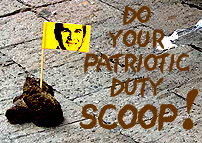 NEW
YORK ~AP NEW
YORK ~AP
Dog owners, take note: New York City's fine for failing to
pick up after Fido is now $250, more than double the $100
it had been since the pooper-scooperlaw passed in 1978.
Gov.
Paterson signed the increase into law in July but there was
a 90-day delay before it took effect yesterday, the Sanitation
Department announced.
|

Dog
lover steams 'milk'
October
24, 2008
BOULDER,
Co. ~AP
The owners of the "Got Milk?" slogan are geting
mean with a Dog loverwho sold memorabilia printed with the
words "Got Soy Milk?" and a photo of her Dog sporting
a soy-milk mustache.
Mary
Kenez, of Boulder, who sold the T-shirts and novelties though
her online business, was threatened with a lawsuit by the
California Milk Processors Board for trademark infringement.
"I
thought it was cute," said Kenez, whose Golden Retriever,
Cloe, died last summer. "To me it was just a parody."
|
 2
Dozen Poodles Rescued from Queens Home
2
Dozen Poodles Rescued from Queens Home
Thursday,
23 October 2008
NEW YORK ~AP
The ASPCA says it has
rescued about 25 poodles from a home in Queens.
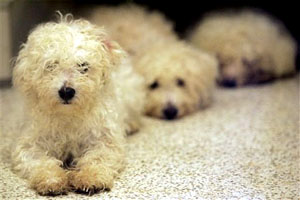 The
dogs, ranging in age from 2 months to 6 years, are relatively
healthy, but are not well socialized to strangers and new environments. The
dogs, ranging in age from 2 months to 6 years, are relatively
healthy, but are not well socialized to strangers and new environments.
The ASPCA said Thursday that residents of the house had a breeding
business. Sales became slow, resulting in too many poodles.
A social worker involved with the family notified the ASPCA.
The director of the agency's Manhattan adoption center says
the dogs will receive medical treatment and behavioral training
before they're put up for adoption. |

Vick plans plea in Va. dogfights
October
22, 2008
SURRY,
Va. (AP) - Former NFL
quarterback MICHAEL VICK plans to plead guilty to state dogfighting
charges, a step that could allow him toqualify for an early
release from federal prison and into a halfway house.
In court papers filed in Surry County Circuit Court, Vick's
attorneys say they are seeking to have him enter his plea
by video teleconference. The papers also note that the guilty
plea would save the government the considrable expense of
transporting Vick to Surry.
"I'm
not trying to make him suffer," Commonwealth's Attorney
Gerald Poindextersaid in a telephone interview. "I'm
just trying to make him account for what he's done."
|

Rush Limbark! Crazy Pet Names Unleashed
BY RICH SCHAPIRO
Wednesday,
October 15, 2008
Some
people give their pets unique names.
Sophie Touch & Pee is a golden retriever who struggles
to hold it in. Edward Scissorpaws , a grey feline, has claws
that she's not afraid to use. Rush Limbark's owner knows that
if she leaves her Hurricane Katrina rescue dog in a car with
commentator Rush Limbaugh 's show on the radio, he'll rest
easy.
"We joke about the fact that he is a conservative canine,"
Buena Silverman , of Holicong, PA, says.
These dogs and cats are among the 100 selected by staffers
at Veterinary Pet Insurance , a pet health insurance provider,
as having the most unusual names among its 465,000 pets insured
nationwide."
Gone are the days when only names like "Spike" and
"Fido" echoed across parks and dog runs. Now, pet
owners are far more likely to label their furry loved ones
names that demonstrate personal creativity or, simply, draw
laughs.
"The dog park would definitely be a more interesting
place if you heard people saying, 'Fetch, Rafikikadiki,' or,
"'Come here, Meatwad,'" said Curtis Steinhoff ,
the senior director of corporate communications for the pet
insurance company.
"I might be a little hesitant to introduce people to
Miss Fuzzbutt, or Sir Lix-a-lot, but I also can't think of
many better conversation starters."
Two New York canines made the list of the 50 most unusual
dog names. There's Mr. Poo, a mixed breed from Ridgewood,
Queens , and The Bean, a Corgi-Cardigan, who calls Sagaponack
, L.I. home. Among the names that round out the top ten most
outrageous dog monikers are: Sirius Lee Handsome, Low Jack,
Peanut Wigglebutt and Scuddles Unterfuss.
The most bizarre cat names include Snoop Kitty Kitty, Sparklemonkey
and Toot Uncommon.
|

'Walter Reed' for combat dogs opens at Texas base
By MICHELLE ROBERTS
Wed., Oct. 22, 2008
SAN ANTONIO – A new $15 million veterinary hospital
for four-legged military personnel opened  Tuesday
at Lackland Air Force Base , offering a long overdue facility
that gives advanced medical treatment for combat-wounded dogs. Tuesday
at Lackland Air Force Base , offering a long overdue facility
that gives advanced medical treatment for combat-wounded dogs.
Dogs working for all branches of the military and the Transportation
Safety Administration are trained at the base to find explosive
devices, drugs and land mines. Some 2,500 dogs are working
with military units.
Like soldiers and Marines in combat, military dogs suffer
from war wounds and routine health issues that need to be
treated to ensure they can continue working.
Dogs injured in Iraq or Afghanistan get emergency medical
treatment on the battlefield and are flown to Germany for
care. If necessary, they'll fly on to San Antonio for more
advanced treatment — much like wounded human personnel.
"We act as the Walter Reed of the veterinary world,"
said Army Col. Bob Vogelsang, hospital director, referring
to the Washington military medical center that treats troops
returning severely wounded from Iraq and Afghanistan.
The dogs can usually return to combat areas if they recover
at the Military Working Dog Center, he said.
Before the center opened, veterinarians treated and rehabilitated
dogs in a cramped building that opened in 1968, when the military
trained dogs for work in Vietnam .
The hospital was already overloaded by Sept. 11, 2001, but
since then, demand for military working dogs has jumped dramatically.
They're so short on dog breeds such as German shepherds ,
Labrador retrievers and Belgian Malinoises that Lackland officials
have begun breeding puppies at the base.
Lackland is training 750 dogs, which is nearly double the
number of dogs there before the Sept. 11 attacks , Vogelsang
said.
To treat the trainees and injured working dogs, the new hospital
has operating rooms, digital radiography ,CT scanning equipment
, an intensive care unit and rehab rooms with an underwater
treadmill and exercise balls, among other features. A behavioral
specialist has an office near the lobby.
"This investment made sense ... and somehow, we were
able to convince others," said retired Col. Larry Carpenter,
who first heard complaints about the poor facilities in 1994
and later helped to launch the project.
Training a military working dog takes about four months. With
demand outstripping the number of dogs available, hospital
and veterinary workers were trying to keep them healthy and
working as long as possible, Vogelsang said.
Working dogs usually enter training at 1 1/2- to 3-years-old,
and most can work until they're about 10, he said.
Then, the military tries to adopt them out and "station
them at Fort Living Room," Vogelsang said
Photo: AP – Dog handler James Stegmeyer works
with Kamilka at the new Military Working Dog Center at Lackland
Air
|

In Hard Times for Humans, Hardships for Pets, Too
With all the talk of bulls and bears lately,
what’s happening to cats and dogs?
By TINA KELLEY
Published:
October 17, 2008
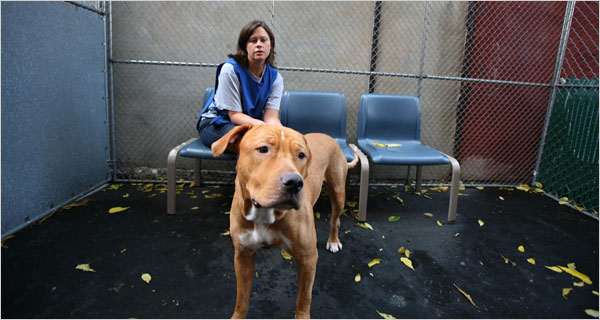
Jenny
Daniel, a volunteer at Animal Care and Control of New York
City, with Bricky, who was give up by ts owners this week.
At
New York City’s main animal shelter, monthly calls to
the volunteers who can help people keep their pets through tough
financial times doubled, to 225 from 115, between January and
September.
“We knew how valuable the program was, but now something
like this hits, and people can’t afford vet care,”
said Richard P. Gentles, the director of administration services
for the shelter, Animal Care and Control of New York City. “Some
can’t even afford food.”
Volunteers who work for the shelter’s four-year-old Safety
Net program provide struggling pet owners with low-cost boarding
or pet-training services, food donations, lists of apartment
buildings that allow pets, even legal help if a landlord is
trying to illegally evict a pet owner.
As the country’s financial crisis has deepened, more pet
owners are asking the shelter for help.
Sadie Judge, 50, has been living with friends and relatives
ever since she got sick and lost her teaching job at Brooklyn
College as well as her apartment.
“I kept saying, ‘At least I’ve got my kitty
cats,’ ” Ms. Judge said. But in early September,
without her permission, she said, her roommate’s boyfriend
took her four cats, Michael, Michelle, Molly and Gunzu, to Animal
Care and Control, on East 110th Street between First and Second
Avenues.
Ms. Judge said that after learning from her niece where her
cats had been taken, she was told that she had 24 hours to get
them out or they would be put up for adoption. But she had nowhere
to take them. She was in tears when she happened to look up
and see the Safety Net poster. Within two days, her cats were
in two separate foster homes, and she hopes to get them back
when she finds permanent housing.
Animal Care and Control took in 9.4 percent more pets in the
first half of 2008 compared to the same months in 2007. However,
in the 12 months that ended in August, 168 fewer dogs were adopted
than in the previous 12 months.
“Probably because of the crisis, fewer people could make
a commitment to adopt,” Mr. Gentles said. “It will
be a huge problem for us if it continues.”
He said the agency needed to recruit three times the number
of new foster homes for pets to keep up with demand, in part
because many people who serve as foster petkeepers end up adopting
them and leaving the program.
The situation is much the same at shelters throughout the country.
Betsy Saul, founder of Petfinder.com, a national pet adoption
Web site, said that smaller shelters simply did not have enough
food, while donations were plummeting. A survey conducted by
her site found that 57 percent of shelters and rescue groups
were seeing a decrease in adoptions.
“We’re hearing that individuals who are caring for
feral cat populations with their own money or small rescue groups
are feeding them bread soaked in water now, because there’s
not enough cat food,” she said.
Veterinarians are concerned that pet owners may hold off on
medical treatments, like hip replacements, that were more common
during flush times, Ms. Saul said. And because research has
shown that a typical pet owner starts considering euthanasia
once the cost of treating an ill pet surpasses $500, they fear
that more owners will make that choice sooner than they have
in the past.
Kristen Levine, president of Fetching Communications, a public
relations firm based in Florida that works with the pet industry,
says veterinarians are finding that pet owners have become more
likely to skip annual checkups to save money, even though early
diagnoses can detect illnesses that get more costly over time.
“Some vets are offering special incentives for wellness
visits, like a free microchip or free nail trimming, for giving
something back to owners for recognizing the importance of preventative
health care,” Ms. Levine said.
In the worst case, pets become homeless. The number of strays
taken in by Animal Care and Control in September increased by
almost 300, to 2,902, from last year. As the city’s only
open-admissions shelter, Animal Care and Control has to euthanize
animals after all adoption and foster care resources have been
exhausted. Last year, it euthanized 15,768 animals, 55 percent
fewer than in 2000.
|
"No
man can be condemed for owning a Dog. As long as he has
a Dog, he has a friend; and the poorer he gets, the better
friend he has."
-
WILL ROGERS |
At
that shelter on Wednesday, two women — one of them crying
— were surrendering a dog together. They declined to speak
to a reporter because they said they were too upset. Nearby,
another man was surrendering a stray cat, explaining that someone
had dumped it in an alley near his apartment on the Lower East
Side.
“If I could keep him I would, but I have three at home,”
said the man, Ted Sterns, the chief stage manager for Merkin
Concert Hall on West 67th Street, adding that the cat was trained
to use a litter box and seemed to have been a pet. “Somebody
dumped this poor baby out.”
But some people may find that as their savings evaporate, their
need for companionship may grow stronger. This weekend at Madison
Square Garden, the Mayor’s Alliance for NYC’s Animals
will be holding its annual Adopt-a-Cat day, with hundreds of
cats and kittens looking for new homes. Prospective owners can
fill out a survey that will color-code their personalities to
match with available animals.
On average, a cat costs $1,000 a year to maintain, compared
with about $1,500 a year for a dog, Ms. Levine said. Having
a pet can bring healthy returns, especially during bear markets.
“They comfort us; they don’t care if your 401(k)
lost money today,” Ms. Saul of Petfinder.com said. “They’re
one of the few people in the family who are not going to be
stressed out about what you did with your money.”
Adoptions
are down, and more abandoned pets are coming in. Some pet owners
“can’t even afford food,” an official said.
|
“There
is no man so poor but what he can afford to keep a Dog.”
-
JOSH
BILLINGS a.k.a. Henry Wheeler Shaw
|
Photo:
Suzanne DeChillo/The
New York Times |

Rescue group leaves Iraq without puppy
that was championed by thousands in petition campaign
By FREDERIC J. FROMMER
Associated Press Writer
October
15, 2008
WASHINGTON (AP) -- An animal rescue group left Baghdad on
Wednesday without a puppy whose cause has been championed
by thousands of people from around the world.
But the group said the U.S. military had cleared the dog to
leave and was hopeful to get it out of the country as soon
as Sunday.
The Society for the Prevention of Cruelty to Animals
International says the military finally agreed to
allow the dog, Ratchet, to leave the country, but only 30
minutes before the flight out, too late for the dog to make
it. SPCA's Operation Baghdad Pups flight left with six other
dogs bound for the U.S.
The military responded that it did not hold the dog or order
it to stay put at a U.S. military base.
 Army
Spc. Gwen Beberg, 28, of Minneapolis, adopted Ratchet
(left) after she and another soldier rescued the puppy from
a burning pile of trash in May. But Defense Department rules
prohibit U.S. troops who are deployed from caring for pets
in theater or taking them home. Army
Spc. Gwen Beberg, 28, of Minneapolis, adopted Ratchet
(left) after she and another soldier rescued the puppy from
a burning pile of trash in May. But Defense Department rules
prohibit U.S. troops who are deployed from caring for pets
in theater or taking them home.
Baghdad Pups tried to collect Ratchet two weeks ago, but said
a U.S. commander had intercepted a military convoy carrying
the dog to Baghdad and sent it back to Beberg's former base.
More than 45,000 people have signed an online petition urging
the Army to let the puppy come to the U.S.
Baghdad Pups has brought more than 50 cats and dogs to the
U.S. to be with their owners. The group says it is both rescuing
animals who face abuse in Iraq, as well as helping soldiers
who benefit from the bond developed with the animals.
Beberg, who plans to return to the U.S. next month, was ecstatic
about the news that her dog was cleared to leave.
"I am thrilled that Ratchet is going home!!" she
wrote in an e-mail to the SPCA and others Wednesday, adding
that she planned to do a "victory dance" on Sunday.
Maj. Daniel Elliott, a spokesman for U.S. forces south of
Baghdad, said in a statement Wednesday that the military had
no control of the dog.
"Our military working dogs carry rank and are afforded
many of the rights and privileges of their fellow soldiers,"
he said. "Ratchet is a wild dog indigenous to Iraq. A
stray, befriended by a soldier. As such, we do not control
him, nor can we 'order' him not to leave" the base.
Elliott added that there was nothing preventing SPCA from
picking up the dog.
Besides the thousands of petition signers, Ratchet had champions
such as Democratic Rep. Keith Ellison, as well as both of
the state's senators, Democrat Amy Klobuchar and Republican
Norm Coleman, all of whom wrote letters to the military asking
them to review the case.
To
sign Ratchet petition: http://www.thepetitionsite.com/2/clemency-for-ratchet
|

Army blocks soldier from bringing puppy back
By FREDERIC J. FROMMER
Associated Press Writer
Tue October 14,
2008
WASHINGTON – More than 10,000 people have signed an
online petition urging the Army to let an Iraqi puppy come
home with a Minnesota soldier, who fears that "Ratchet"
could be killed if left behind.
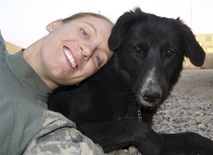 "I
just want my puppy home," Sgt. Gwen Beberg
of Minneapolis (left with Ratchet) wrote to her mother in
an e-mail Sunday from Iraq , soon after she was separated
from the dog following a transfer. "I miss my dog horribly."
Beberg, 28, is scheduled to return to the U.S. next month. "I
just want my puppy home," Sgt. Gwen Beberg
of Minneapolis (left with Ratchet) wrote to her mother in
an e-mail Sunday from Iraq , soon after she was separated
from the dog following a transfer. "I miss my dog horribly."
Beberg, 28, is scheduled to return to the U.S. next month.
Ratchet's defenders are ratcheting up their efforts to save
him. On Monday, the program coordinator for Operation Baghdad
Pups, which is run by Society for the Prevention of Cruelty
to Animals International , left for a trip to the Middle East
to try to get the puppy to the U.S.
And last week, Beberg's congressman, Democrat Keith Ellison
, wrote to the Army urging it to review the case.
Beberg and another soldier rescued the puppy from a burning
pile of trash back in May. Defense Department rules prohibit
soldiers in the U.S. Central Command , which includes Iraq,
from adopting pets , but exceptions have been made. Operation
Baghdad Pups says it has gotten 50 dogs and six cats transferred
to the U.S. in the last eight months.
"I'm coping reasonably well because I refuse to believe
that Ratchet has been hurt," Beberg wrote in the e-mail
to her mother, Patricia Beberg. "If I find out that he
was killed though — well, we just won't entertain that
possibility."
The mother said her daughter sent another e-mail saying that
she confirmed that the dog was still alive and doing OK.
Operation Baghdad Pups' program coordinator, Terri Crisp,
is scheduled to arrive in Baghdad on Wednesday. Crisp said
the adopted dogs left behind face death on Iraqi streets.
She said Iraqis view dogs and cats as nuisances and carriers
of disease, and U.S. soldiers have rescued many of them from
abuse.
Photo
provided by the Society for the Prevention of Cruelty to Animals
|

Thu, October 9, 2008
 |
EXTRA
Michelle
Obama announced on TV this week that her family will adopt
– not buy – a dog after the
elections.
That’s
an example we hope other Americans will follow. Then rescue
pets everywhere will be the real winners! Over 50,000
signed the Best
Friends successful petition. |

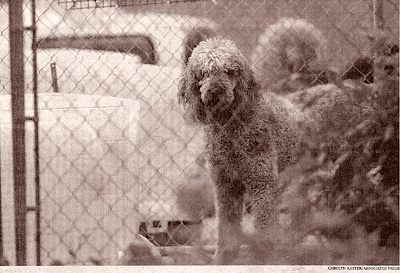
A Kennel Belies Its Name
October 3,
2008
Agents raided the Almost Heaven
Kennel in Emmaus, Pa., on Thursday and
found hundreds of animals crowded into a filthy compound and
dozens of puppy carcasses in a freezer. The owner, Derbe
Eckhart, was charged with animal cruelty.
|

Agency
to Reconsider Taking Gray Wolves Off Endangered
Species List
By JIM ROBBINS
September
24, 2008
HELENA, Mont. — The federal agency that removed the
gray wolf from the endangered species list in March has changed
its mind and is asking a federal judge to vacate the decision.
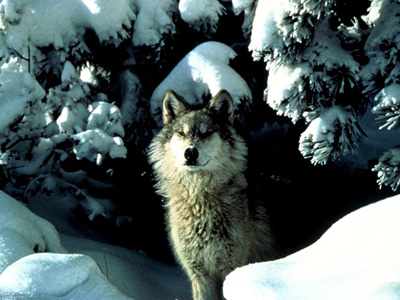 The
request, by the United States Fish and Wildlife Service, follows
a temporary order by Judge Donald Molloy of Federal District
Court in Missoula, Mont., against the service’s decision
in March to remove the wolf from the list. The agency said
then that the wolf population in the Northern Rockies had
fully recovered. The
request, by the United States Fish and Wildlife Service, follows
a temporary order by Judge Donald Molloy of Federal District
Court in Missoula, Mont., against the service’s decision
in March to remove the wolf from the list. The agency said
then that the wolf population in the Northern Rockies had
fully recovered.
The order stopped a plan to allow hunting of the wolves in
Montana, Idaho and Wyoming until a lawsuit by environmentalists
challenging the wolves’ removal from the endangered
species list could be heard.
On Monday the Fish and Wildlife Service asked Judge Molloy
to vacate the delisting and allow officials to reconsider
their finding and further study the issue. “We are going
to take a look at everything again and address the concerns
expressed to us by the judge and everyone else,” said
Sharon Rose of the service’s Mountain Prairie Office.
Environmentalists were pleased by the agency’s action.
“We’re delighted by the request to redo the plan,”
said Louisa Wilcox, of the Natural Resources Defense Council.
“It clearly reflects the fact that there were problems
with the plan.”
The environmentalists’ lawsuit, filed in July, said
among other things that a plan to control the wolf population
relied too heavily on killing the animals, rather than on
nonlethal means of control. They also said the wolves’
genetics, which dictate their long-term survivability, were
not well understood.
The reconsideration of the listing was not related to a recently
announced decline in the wolf population in the Rockies. Wildlife
officials counted 1,455 animals this summer, down from 1,545
a year ago. It was the first drop in more than 10 years and
officials said they were not sure why.
The first wolf hunting season, scheduled for this fall, was
delayed after Judge Molloy’s order. If the judge grants
the Fish and Wildlife Service’s request, it will be
further delayed until the re-evaluation is complete.
But state and federal agents in Montana, Idaho and Wyoming
will still be allowed to kill problem wolves that threaten
livestock. Since wolves returned to the West in the 1990s
federal agents have killed more than 1,000 wolves, and last
year 186 problem wolves were killed in the three states.
• • •
Long
Live the Gray Wolf
Editorial
September 24, 2008
The
federal Fish and Wildlife Service has rescinded an earlier
decision to remove the gray wolf in the Northern Rockies from
the endangered species list. The wolves need the protection,
so this is wonderful news. It will be even better if it results
in a secure, long-term future for the wolves instead of the
threadbare state protections that have been in place since
the wolf was delisted last winter.
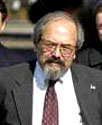 Judge
Donald Molloy (left) of Federal District Court has had much
to do with this outcome. In July, in response to a lawsuit
from environmental groups, he found that the government had
failed to meet its own standards for delisting the wolves.
Crucially, the service had provided no evidence of interbreeding
among the scattered populations of wolves. Interbreeding is
an important sign of adequate, stable numbers. Judge
Donald Molloy (left) of Federal District Court has had much
to do with this outcome. In July, in response to a lawsuit
from environmental groups, he found that the government had
failed to meet its own standards for delisting the wolves.
Crucially, the service had provided no evidence of interbreeding
among the scattered populations of wolves. Interbreeding is
an important sign of adequate, stable numbers.
Nor did Judge Molloy think much of the protection plans in
Wyoming, Montana and Idaho. After it delisted the wolves,
the Fish and Wildlife Service entrusted the job of managing
wolf populations to the states. He was especially critical
of Wyoming’s program, which is really more of a wolf-killing
plan since it allows wolves to be hunted for sport or shot
as predators in most of the state.
Federal biologists will almost certainly try to rewrite the
wolf recovery plan to meet Judge Molloy’s objections.
In doing so, and before proposing any new delisting scheme,
they must insist that the states demonstrate not only the
capacity but, especially in Wyoming’s case, the political
will to manage wild populations responsibly. More than 100
wolves have already been needlessly killed since the ill-advised
delisting.
Judge Molloy has reminded us of one other thing. That is the
importance of the Endangered Species Act, which the Bush administration
has repeatedly tried to weaken. There have been few biological
reintroductions as successful as the restoration of the gray
wolf to the Rockies. The wolves would never have survived
without the act’s legal shelter.
|

Dog Owner Sent to Prison for Murder in ’01 Mauling
By JESSE MCKINLEY
September
22, 2008
SAN FRANCISCO — A San Francisco Superior Court
judge sentenced a woman to 15 years to life in 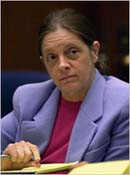 prison
on Monday for her role in an infamous fatal dog mauling. Marjorie
Knoller, whose dogs attacked a neighbor, was sentenced to 15
years to life. prison
on Monday for her role in an infamous fatal dog mauling. Marjorie
Knoller, whose dogs attacked a neighbor, was sentenced to 15
years to life.
The sentence came a month after the judge,
Charlotte W. Woolard, reinstated a second-degree murder conviction
against the woman, Marjorie Knoller, stemming from the 2001
attack that killed Ms. Knoller’s neighbor Diane Whipple.
Ms. Whipple, a 33-year-old lacrosse coach, was attacked in
the hallway of her building in January 2001 by Ms. Knoller’s
two 120-pound dogs and bitten more than 75 times.
A second-degree murder conviction against Ms. Knoller was
thrown out in 2002 by the original trial judge, who said the
evidence did not support the charge. She was sentenced instead
to four years in prison for involuntary manslaughter and released
on parole in 2004.
But on Monday, Judge Woolard, who took over the case earlier
this year, imposed the new sentence, which was hailed by Kamala
D. Harris, the San Francisco district attorney. “This
defendant is now facing the appropriate punishment,”
Ms. Harris said.
The mauling attracted widespread attention and was moved to
Los Angeles in search of an unbiased jury.
 Ms.
Knoller asserted that she had tried to protect her neighbor
from the dogs, a powerful breed called Presa Canario.
But prosecutors convinced a jury that Ms. Knoller was both
aware of the dogs’ violent potential and blithe to other
people’s safety. Ms. Knoller’s husband, Robert
Noel, who was not present at the attack, was also convicted
of involuntary manslaughter. Ms.
Knoller asserted that she had tried to protect her neighbor
from the dogs, a powerful breed called Presa Canario.
But prosecutors convinced a jury that Ms. Knoller was both
aware of the dogs’ violent potential and blithe to other
people’s safety. Ms. Knoller’s husband, Robert
Noel, who was not present at the attack, was also convicted
of involuntary manslaughter.
Dennis Riordan, a lawyer for Ms. Knoller, said she would appeal
the reinstated murder conviction. “In our view,”
Mr. Riordan said, “the notion that she said, ‘Rather
than staying home and cooking dinner, I’ll go out and
possibly kill somebody,’ is unsupported by the evidence.”
Pool photo
of Ms Knoller by Nick Ut
|

Bronx Man Arrested after Dog Dies of Massive
Injuries
Friday, 19
September 2008
NEW YORK (AP) -- Animal welfare agents
have arrested a Bronx man on a felony cruelty charge after his
dog suffered massive injuries. The terrier, named J.J., has been
euthanized.
The ASPCA says J.J. suffered a collapsed lung, renal failure and
eight broken ribs, as well as a fractured pelvis and broken leg.
Some of the injuries were old.
If Daniel Coy is convicted, he could face up to 2 years in prison.
The name of his lawyer was not yet on the record Friday as he
awaited arraignment.
On Thursday, the ASPCA arrested a Brooklyn woman whose Chihuahua
was starving and dehydrated. Marley will be available for adoption.
It also arrested a Bronx woman for neglect; her Lhasa Apso's hair
was so matted that it couldn't walk. |

Man Arrested for Allegedly Throwing Canine
to Her Death
September
19, 2008
Thanks to the diligence of the ASPCA Humane
Law Enforcement (HLE) department, justice will finally be served
to the man who allegedly threw his ex-girlfriend’s small
dog to her death. The incident occurred on September 14, 2007—a
year ago this week.
On that day, Farah Benoit returned to the Brooklyn apartment
she had shared with former boyfriend Sherman Haynes to collect
her belongings, including her three-year-old shih tzu, Zahara.
Haynes would not allow Benoit into the building and began tossing
her possessions—including clothing and a heavy cabinet—out
of his third-floor window. Witnesses stated that Haynes grabbed
Zahara by the throat and then threw the canine to the
sidewalk below.
Benoit rushed Zahara to Manhattan’s Animal Medical Center,
but with multiple broken legs, collapsed lungs and internal
bleeding from the impact, the 15-pound dog soon succumbed to
her injuries.
Haynes fled, and for a year avoided both the NYPD and HLE investigators
seeking to question him. However, HLE continued to work the
case, striving to pinpoint Haynes’s location. His use
of a social networking website, plus information from the U.S.
Postal Inspection Service and the New York State Department
of Motor Vehicles, ultimately led ASPCA Special Agent Peter
Rivas to the door of Haynes’s new Manhattan apartment,
where he was arrested on September 5, 2008.
Haynes was arraigned the following Friday and charged with aggravated
animal cruelty, a felony. He also was charged with reckless
endangerment, reckless endangerment of property, menacing, criminal
possession of a weapon and criminal mischief. The NYPD slapped
him with an additional charge of aggravated harassment for an
unrelated incident. Haynes, 27, faces up to seven years in prison
for the combined charges.
“This case is another sad example of a pet being used
as a pawn for revenge in a domestic violence situation,”
says Joseph Pentangelo, Assistant Director, ASPCA Humane Law
Enforcement. “We see this all too often. I urge anyone
leaving an abusive relationship to take their pets with them
or place them, at least temporarily, with family or friends.
Do not leave them behind, where they become easy targets.”
In an effort to address the high incidence of pets being harmed
in domestic violence disputes, about a dozen states—including
New York—have passed laws allowing pets to be included
in orders of protection.
|

First group of rescues gets vet treatment, shelter
by
Cathy Scott
September 18, 2008
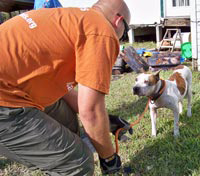 For
more in-depth coverage of our rescue efforts in Galveston
County, please check out our Rapid Response community on the
Network. For
more in-depth coverage of our rescue efforts in Galveston
County, please check out our Rapid Response community on the
Network.
Day two of the Best Friends rapid response team effort on
the Texas Gulf Coast was a day of rescues.
The team, out on the grasslands and in rural sections of Galveston
Bay, went street by street, scouring and assessing bay area
communities for survivors. By the end of the day, they had
rescued a warthog, a lone kitten and four dogs.
One of the dogs, a mix named Rosie, was surrendered to the
team by her people. According to team leader Rich Crook, the
group came upon a couple on a street with an emaciated, sick-looking
dog. After speaking with Rich and two animal control officers
accompanying the team, the couple handed over the dog so she
could get immediate medical care, and a new home could be
found for her.
A three-month-old gray cat the team named Shadow was found
hiding behind a sofa inside a home. Three dogs, including
a puppy, who were in the home didn't survive, but Rich says
the kitten was in pretty good shape, considering she had gone,
at that point, five-plus days without food or water.
In another yard, the team arrived just in time to save a dog
who was on a chain and caught under the fence. The team was
able to unravel the chain, free the dog and take him and a
second dog to safety.
Two more dogs -- a female black Lab and a male American Staffordshire
terrier mix -- were rescued after someone in the area reported
to animal control about two dogs alone in a yard. Because
the female was lactating, the team searched the yard for puppies,
but they didn't find any signs of a litter. The male dog,
who appeared to have an eye infection, and the Lab were taken
to the shelter for treatment.
But it was the warthog who made the biggest commotion when
he was rescued. The wild pig put up quite a fuss, according
to Rich, and the only way to get him was with a catch-pole.
It turns out he's a healthy warthog, and animal control officers
plan to release him soon to an uninhabited area on the island
where wild warthogs congregate.
Despite finding animals left behind who didn't survive, it
was a good rescue day for those who did. All were taken to
the Galveston County Health District Animal Control shelter
in Texas City, which services the county. And all will be
examined and treated as required by a veterinarian. The county
shelter is working with a rescue group that's taking in and
fostering many of the animals, to help reunite them with their
people and, in some cases, find them new homes.
As for the warthog rescue, "We are hog-happy that he
will be re-released to the wild," says Best Friends chief
executive officer Paul Berry.
And as for those pets left behind, Paul says, "Our team
will stay on until we're sure they're all safe and secure.
And going forward, we'll work with area officials to ensure
proper compliance on evacuation of pets next storm."
Photo
by Pam Crook
|

ASPCA Emergency Grant Funding Tops $75,000 Following Hurricanes
Ike & Gustav
Pre-Assessment Funding for Ike
Aftermath Already at $25,000
September
17, 2008
The
ASPCA (The American Society for the Prevention of Cruelty
to Animals) has dispersed and pledged more than $75,000 in
grant funding to organizations in Texas and Louisiana following
Hurricanes Ike and Gustav, in addition to deploying a team
of disaster response experts to assist both states in dealing
with the aftermath of animal and animal agency casualties.
The grant funding covers recovery costs, as well as transportation
assistance, distribution of food and supplies, and other needs.
“Thanks to the kindness and generosity of our supporters,
the ASPCA is able to offer grants and emergency funds to assist
organization affected by both Hurricanes Ike and Gustav,”
said ASPCA President and CEO Ed Sayres. “Over the years,
these organizations have shown exceptional commitment and
dedication the animals in their care, and we are happy to
be able to provide assistance during their time of need.”
In the aftermath of Hurricane Ike, the ASPCA has already pledged
more than $25,000 in pre-assessment grants to the following
organizations:
• Animal Aid of Vermillion Parish in Louisiana, for
recovery and supplies;
• Walter Ernst Foundation of the Louisiana Veterinary
Medical Association, for equine hay drops in southwest Louisiana;
• Habitat for Horses Inc. in Hitchcock, Texas, for emergency
hay after destruction of a new barn and sheds, and for 60
horses on site and another 300 in foster care across several
states;
• Hopeful Haven Equine Rescue Organization in Shreveport,
Louisiana for assistance with removal of hoof stock from flooded
areas in Vermillion Parish, as well as hay.
The ASPCA is working closely with the Texas State Animal Resource
Team (TXSART) and other credentialed animal care agencies
to assist and provide resources. ASPCA disaster team members
are stationed at the Area Command Center at the Texas Animal
Health Commission in Austin, Texas, and are currently providing
assessments in Liberty County, just north of Galveston, one
of the hardest-hit areas
For
full article √ click here >
|

National
Briefing | Rockies
Montana: Gray Wolves May Get Government
Reprieve
By THE ASSOCIATED PRESS
September
16, 2008
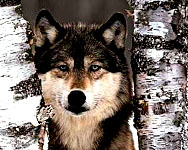 A
federal wildlife official in Billings said the government
planned to retreat for now from its attempt to take gray wolves
in the Northern Rockies off the endangered species list. A
federal wildlife official in Billings said the government
planned to retreat for now from its attempt to take gray wolves
in the Northern Rockies off the endangered species list.
The official,
Ed Bangs of the Fish and Wildlife Service, said the government
in the next week planned to withdraw a rule issued this spring.
The rule was based on the assertion that the region’s
approximately 1,500 wolves were recovered fully, opening the
way for public hunting of wolves to begin this fall in Montana,
Idaho and Wyoming. Those hunts had been in doubt since July,
when Judge Donald Molloy of Federal District Court blocked
them pending resolution of a lawsuit by environmentalists.
|
Atlanta
Journal-Constitution
CLASSIFIEDS
Received
- August 31, 2008
SINGLE
BLACK FEMALE seeks male companionship, ethnicity unimportant.
I'm a very good girl who LOVES to play. I love long walks
in the woods, riding in your pickup truck, hunting, camping
and fishing trips, cozy winter nights lying by the fire. Candlelight
dinners will have me eating out of your hand. I'll be at the
front door when you get home from work, wearing only what
nature gave me. Call (404) XXX-XXXX and ask for Daisy,
I'll be waiting....
Over 150 men found themselves talking to the Atlanta
Humane Society.

|

Bear-kill
Dog's Owner Charged
AP
August
29, 2008
The owner
of a Ruttweiler that authorities say killed a bear cub this
week will face charges brought by the New Jersey Society for
the Prevention of Cruelty to Animals.
Matt
Stanton, an NJSPCA spokesman, said Wednesday that Teri Daubner
of Jefferson Township faces two counts of failure to provide
proper shelter for her Dog and two counts of causing an animal's
death.
The first
counts are criminal charges and the second charges are civil
charges filed on behalf of the animal. The charges carry a
term of up to six months in jail and a maximum fine of $2000.
Daubner's
Dog, Max, was in an outdoor kennel but got out when the cub
wandered onto the property Tuesday. Daubner had built the
pen after the 5-year-old Ruttweiler caused the death of a
neighborhood Dog.
|

Hotel Chains Open Their Doors to Dogs
By Phyllis DeGioia for The Dog Daily
August
28, 2008
Imagine that the following happens during your next vacation:
You enter the lobby of a luxury hotel with your accompanying
children, colleagues or friends, and your eyes wide open.
Your companions gasp while you stare, jaw agape, at the finery
and expensive furnishings. You’re so taken aback by
the splendor that you almost drop your dog’s leash.
This scenario might not just be a daydream -- especially the
part about your dog. That’s because many hotels now
cater to dog owners like you. Now you can stay at hotels ranging
from luxury chains, where you can expect royal rover treatment,
to reasonably priced hotels, which place more emphasis on
functionality rather than flash.
Full
Article @ http://dogs.myfoxny.com/Happy/hotel_chains_open_doors/index.html
|

A
New Top Dog for Obama Family?
By Gina K. Callaghan
27 August
2008
Forget about beating John McCain, presumptive Democratic presidential
nominee Barack Obama has another daunting task ahead -- getting
his daughters a dog.
Obama and his wife, Michelle, reportedly promised the kids
that -- win or lose -- they will have a canine companion after
the election.
During the last seven weeks, The American Kennel Club asked
people to vote for the potential First Pet. The results will
be announced Thursday, August 28, at the AKC's headquarters
in New York City. Both Obama daughter have allergies so the
AKC narrowed the choices to hypoallergenic breeds.
More than 42,000 people cast their vote for top dog, and AKC
officials said it was a close race – with
the winning breed edging out the runner-up by a (dog) hair.
The Canine Candidates are:
The Bichon Frise
The Chinese Crested
The Miniature Schnauzer
The Poodle
The Soft Coated Wheaten Terrier
By the way, we're not giving short shrift to the McCain pets.
The Associated Press reported that John and Cindy McCain have
24 pets, including four dog. Their breeds of choice: the English
Springer spaniel and Yorkshire terrier.
EDITORIAL
COMENT
We don't
care what breed as long as it's a rescue!
|

BEARS
FEAR PLUCKY PUP
By AUSTIN FENNER and CLEMENTE LISI
August
26, 2008
 If
only Goldilocks had a feisty dog. If
only Goldilocks had a feisty dog.
A pint-sized, pugnacious pooch used his loud bark to scare
off a trio of bears in New Jersey after they strayed into
his back yard.
Pawlee, a 15-pound, black and gray cockapoo, ran out of his
home in the town of Wyckoff on Sunday after he spotted a mother
bear and her two cubs wandering in his direction.
"He has a pretty loud bark," owner Fran Osiason
told The Post yesterday. "Sometimes he's a crazy little
puppy."
Osiason said she and her son Jacob, 9, scurried out of the
house, just off Route 208 about 20 miles northwest of Manhattan,
at 8:30 a.m. to see what the hubbub was all about.
"I scooped up the dog, and the bears turned around and
went back into the woods," Osiason recalled. The brave
pup had been about 20 feet away from the bears, the family
said.
The two cubs were so startled by Pawlee's barking, they climbed
a tree. The bruins eventually climbed down and followed their
mom over a 4-foot fence before scattering into the woods.
The Osiason family called police, but by the time they showed
up, the bears had gone.
Alicia Price, 18, a college student who dog-sits Pawlee, said
she's not surprised by his actions. "He's crazy. He has
a lot of energy," she said. "He's always barking
at things."
Osiason said bears are not uncommon in the woods behind her
home - although she had not seen any until last weekend. "We're
very close to the woods," said Osiason, noting that deer
are a more common sight. "We sometimes feel like we're
in their territory."
Osiason said they've had Pawlee - a mix between a cocker spaniel
and a poodle - for the past six months.
|

Weird
But True
By Tim Perone
August
24, 2008
A Dog
in Nevada went against his instincts and saved six cats.
Angel was being walked in Renowhen he became obsessed with
something in the bushes. When the Dog's owner investigated,
he noticed a box of abandoned kittens.
When one of the kittens tried to run, Angel tracked it down
and brought it back.
|

K-9
CAMPAIGNERS
DEMO DOGS
HAVE PLENTY TO BAR(ac)K ABOUT IN DENVER
August
24, 2008
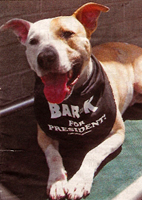 Tomorrow
is Day One of the Democratic National Convention in Denver,
Colo. Tomorrow
is Day One of the Democratic National Convention in Denver,
Colo.
As political animals await the party's official nomination
of Sen. Barack
Obama, dog lovers are hoping their candidate will name a mixed-breed
shelter mutt as his choice for first family dog.
Here's a brief list of things to do in Denver if you're a
Democratic dog.
Get a copy of The Colorado Dog magazine, a luxury lifestyle
K9 publication
that's sold at newsstands and in PetSmart, Petco and Whole
Foods stores
(to subscribe, visit thecoloradodog.com). The glossy quarterly
is owned by
serious dog lovers Jamie Downey and Heather Green, both of
whom own three
large dogs. The magazine's pages offer excellent information
on regional
safety, health, nutrition, training and shelter pet adoption
- plus plenty
of stylin' fashion for haute dogs.
Just as the Mile High City is playing a big role on the national
stage by
hosting the DNC, The Colorado Dog is going national, too,
gearing up for a
relaunch under its new banner, The American Dog. The new,
revamped glossy
will go on sale in October at 4,000 locations nationwide,
including Barnes
& Noble and Borders.
Denver happens to be one of America's most dog-friendly cities,
boasting
five off-leash areas within city limits, plus breathtaking
Cherry Creek
State Park in nearby Aurora, which offers dog-friendly hiking
trails.
Visitors looking to bring home an adopted Denver dog as a
souvenir should
check out the excellent Misha May Foundation (mishamayfoundation.org).
Meanwhile, shopping hounds will love Denver's Mouthfuls Pet
Boutique,
which carries an impressive selection of gourmet pet foods,
home-baked
treats and toys, collars and other items for dogs, cats and
people who
love spending money on them.
The store currently features a head-turning window display
that would do
Barney's creative director Simon Doonan proud: Targeting political
animals, the tableau features a Sen. Obama mannequin alongside
canine
constituents sporting "Bark for Barack" bandannas
(to order one, visit
mouthfuls.net). js@pet-reporter.com
|

End
of the line for puppy mill in West Virginia
by John Polis
August
24, 2008
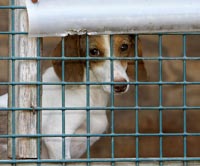 More
than 1,000 puppies have a new lease on life following their
discovery Saturday in a large puppy mill breeding facility
tucked away in the backwoods of West Virginia, just outside
of city of Parkersburg. More
than 1,000 puppies have a new lease on life following their
discovery Saturday in a large puppy mill breeding facility
tucked away in the backwoods of West Virginia, just outside
of city of Parkersburg.
Best Friends Animal Society is on site working with local
Wood County law enforcement officials, the Humane Society
of Parkersburg and the Humane Society of the United States,
and, late Saturday began rescuing scores of dogs from the
Whispering Oaks Kennels.
“Right now, we are concentrating on removing the newborns,
the pregnant mothers, and any dogs who need immediate medical
attention,” said Rich Crook, rapid response manager
for Best Friends Animal Society.
“The dogs, most of them dachshunds, Chihuahuas, poodles
and other small breed dogs, were confined sometimes four or
five to a cage measuring just two feet by three feet,”
Crook said. “Many cages had feces in them. All had poor
ventilation. The sheer number of animals was overwhelming,
and the odor of urine in 90-plus degree heat was stifling.”
By the end of the day Saturday, Crook said as many as 200
animals might be removed from Whispering Oaks and transported
to a local emergency shelter set up by the local group, the
Humane Society of Parkersburg. The remaining dogs will be
transported over the next two days, he said.
Best Friends has been working with the Parkersburg Humane
Society since last May, when the agency called for assistance
in the case. Best Friends also advised the Wood County prosecutor’s
office in the case, and recently requested assistance from
HSUS and other agencies to help with coordination of the operations
at the local emergency shelter.
The fight against puppy mills, mass breeding operations that
supply pet stores and fuel internet sales throughout the United
States, is a priority initiative for Best Friends, which in
the past two years led several other puppy mill busts. Puppy
mills produce an estimated four million dogs in the U.S. each
year for the pet sales market; and, sadly, an estimated six
million homeless dogs and cats are killed in the U.S. each
year.
“It’s a national travesty that the puppy mill
industry is allowed to flood the market every year with so
many dogs being killed each year in animal shelters,”
said Julie Castle, director of community programs at Best
Friends.
Best Friends’ Community Programs group works with local
organizations across the United States on a wide variety of
animal welfare issues related to pet overpopulation, including
puppy mills and management of feral cat populations.
Photo by
Clay Myers
Inside
A West Virginia Puppy Mill Rescue
Hard work,
collaboration, cooperation: all for the dogs
http://network.bestfriends.org/Blogs/Detail.aspx?b=2145&g=ce572b98588b4a7590bc003c7438b4df
|

Forensic Veterinarian Aids in Latest Dog Fighting Raid in Georgia
NEW YORK,
August 22, 2008
The ASPCA ®(The American Society for the Prevention of Cruelty
to Animals ®) today announced that it was again part of
a team of animal welfare agencies, led by the Humane Society
of the United States (HSUS), as well as the Appalachian Judicial
Circuit District Attorney’s office and Gilmer County Sheriff
Stacy Nicholson, which participated in yesterday’s planned
raid of an alleged dogfighting operation in Georgia. Gerald
Holcomb, who has reportedly been involved in dogfighting since
the 1960s, was arrested and charged with felony dogfighting,
possession of a firearm and possession of marijuana.
“The ASPCA is proud to assist HSUS in the raid of yet
another illegal dogfighting ring,” said ASPCA President
& CEO Ed Sayres. “We are sending a clear message to
dogfighters that by combining both our thorough investigative
work and advanced veterinary forensics capabilities, they will
eventually run out of places to hide.”
The raid took place near Ellijay, Ga. and resulted in 11 dogs
being seized along with suspected dogfighting paraphernalia.
Several dogs had scars consistent with dogfighting according
to the investigators on the scene. Dr. Melinda Merck, ASPCA’s
senior director of Veterinary Forensics, and Felicia Earley,
an anti-cruelty veterinary assistant with the ASPCA, were part
of the elite team of animal welfare professionals involved.
The ASPCA’s Mobile Animal Crime Scene Investigation (CSI)
Unit, was also on-site to allow Dr. Merck to examine and care
for any victims immediately, as well as gather and process all
of the forensic evidence right at the scene. A “forensics
first,” the mobile unit is specially-designed vehicle
outfitted with state-of-the-art forensics tools as well as medical
equipment tailored for animal patients.
“I am glad to be able to lend my expertise in processing
the forensic evidence in this case and examining the animal
victims,” said Dr. Merck. “The mistreatment that
these dogs are experiencing is so horrific and while it is a
long process if we want to eradicate animal cruelty, we need
to continue bringing down these offenders one by one.”
Today’s raid marks the fourth Ga. dogfighting bust since
the May 10 passage of new legislation signed by Governor Sonny
Purdue, which strengthened the state's dogfighting law, making
it a felony to own, possess, train, transport or sell a dog
for the purpose of dogfighting. Holcomb could receive one to
five years in prison and a minimum fine of $5,000 or both if
convicted. |
WalesOnline.co.uk
Dogs audition for musical tribute
August 19,
2008
Up to a dozen dogs are being selected to take part in A Song
For Jack, a musical tribute to a life-saving dog.
Swansea Jack was a flat-coated retriever awarded medals in the
1930s for rescuing people drowning in the docks in Swansea,
south Wales.
Thirty hopefuls have now taken part in an audition to discover
which of them has the ’Rex Factor’ to take part
in the tribute.
The one-off recording will be transcribed and published as a
memorial to the famous rescue dog, and the choir will give a
special performance at Swansea’s National Waterfront Museum
on October 5.
Grace Davies, who is helping organise the project, said some
of the auditioning dogs were natural performers while others
were hit by stage fright.
She said: “Their ’voices’ were triggered by
a variety of sounds and encouragements, ranging from a mobile
phone ringtone to the Coronation Street theme tune and a Pavarotti
rendition of Puccini’s Nessun Dorma.
“A Bassett Hound named Edward proved an accomplished bass
baritone capable of howling continuously, and Zac the Border
Collie’s sing-along style was noted by the judges.”
Zac responded “incredibly well” to Happy Birthday,
she said, and a Jack Russell called Angus responded to Bob Dylan.
The project has been commissioned by Swansea arts charity Locws
International, which works with artists to create temporary
arts projects across the city of Swansea.
This particular project is the brainchild of Cardiff artist
Richard Higlett, who said: “Dogs instinctively howl as
part of the pack, which goes back to their origins as wild dogs
and wolves. Dogs are part of the fabric of the city, as much
as anyone else.
“The idea was to celebrate the life of Swansea Jack and
the chosen dogs will be part of that.
“It’s been melodic and chaotic and spontaneous,
a real bit of fun.
“I now have the difficult task of selecting up to a dozen
dogs to perform and decide where they will fit into the piece
we will be recording.
“We will be making the recording at the Metropolitan University
studios on September 8, and the dogs will be prompted to howl
or sing at particular moments during the music.”
Legend has it that Swansea Jack saved 27 people from the docks
in his home town. His first rescue in 1931, of a 12-year-old
boy, went unreported. But he appeared in a local paper a few
weeks later when a crowd witnessed him rescuing a swimmer in
distress. In 1936 he had the Bravest Dog of the Year award bestowed
on him by the London Star newspaper.
He received a silver cup from the Lord Mayor of London and is
still the only dog to have been awarded two bronze medals by
the National Canine Defence League. |
The
Local: Germany's news in English
Dogs to sniff out endangered species trade in Frankfurt
19 August
2008
The newest members of the special German customs force combating
the illegal trade in endangered species are just three years
old, with bright brown eyes and noses that can sniff out a smuggled
frog through two layers of plastic.
Frankfurt Airport welcomed its first dogs trained to sniff out
endangered species on Tuesday. Uno, a chocolate labrador, and
Amy, a German shepherd, will help airport customs officers combat
a trade worth an estimated €13 billion ($19 million) last
year.
Ten weeks of training taught the dogs to detect 15 different
endangered species, including turtles, crocodile skin handbags,
ivory, snakes and even tins packed with caviar from threatened
fish. Customs officers hope the dogs will also help them find
live animals crammed inside travelers' suitcases, including
lizards packed in video cassettes and parrots stuffed into narrow
plastic pipes.
Europe is the most important market in the €13-billion
endangered species trade, World Wide Fund for Nature expert
Volker Homes told German press agency DPA. Customs officials
in Frankfurt, which handles 54 million passengers each year,
found nearly 112,000 protected plants and animals in luggage
last year, including some 5,600 living animals.
Smuggling is the biggest threat to numerous endangered species,
including South American parrots and tropical reptiles, coral
and orchids.
"In Europe right now there's a trend toward keeping reptiles,"
Homes said, calling the airport's introduction of Uno and Amy
a milestone in the fight against smuggling.
Officials aim to introduce similar dogs at all of Europe's main
airports. Pilot projects are already active at the smaller airports
in Stuttgart, Vienna and Nuremberg.
For Uno and Amy, the hunt looks like play. At a press demonstration
on Tuesday, the chocolate Lab gamboled happily after finding
a turtle inside a grey plastic suitcase - and getting a treat
from his handler, 38-year-old Guido Nickel.
But the search for endangered species is actually hard work,
trainer Dieter Keller told reporters. While tracking, the dogs
breathe in 50 to 100 times before breathing out.
"They can do 15 minutes at a time, at most," Keller
said. "This is a huge physical challenge."
|
NYC:
ASPCA Arrests Brooklyn Heights
Woman for Starving Her Dog
On August 11, ASPCA Special Agent Kristi Adams arrested Brooklynite
Francesca Sullivan, 21, on one count of misdemeanor animal cruelty
for starving Ditto, her two-year-old puggle (pug/beagle mix).
In early May, Sullivan’s ex-boyfriend returned to the
Brooklyn Heights apartment they once shared and was alarmed
by Ditto’s physical deterioration following the couple’s
breakup. When he brought Ditto to a nearby animal hospital for
treatment, the dog weighed a mere 6.6 pounds—the average
weight range for an adult puggle is 15 to 30 pounds. The Brooklyn
hospital called ASPCA Humane Law Enforcement, which began an
investigation.
When contacted by the hospital, Sullivan relinquished ownership
of the dog. After three weeks in hospital custody, Ditto had
more than doubled his weight to 13.5 pounds. “This is
a pretty remarkable weight gain,” says Dr. Robert Reisman,
ASPCA Medical Coordinator of Animal Cruelty Cases. “In
the absence of any underlying medical problem that would contribute
to the fluctuation, such significant growth in a short time
period proved that Ditto had been starved in his previous home.”
Ditto has been adopted through the Brooklyn hospital and is
recovering well, while his former owner faces up to one year
in jail and a $2,000 fine.
If you know of an animal whose health is being compromised by
neglect, please report it to the authorities. In New York City,
contact the ASPCA's anonymous tip line at (877) THE-ASPCA. To
learn how to report cruelty elsewhere, visit our Report
Cruelty section . |

Hotel Chains Open Their Doors to Dogs
By Phyllis DeGioia for The Dog Daily
August
28, 2008
Imagine that the following happens during your next vacation:
You enter the lobby of a luxury hotel with your accompanying
children, colleagues or friends, and your eyes wide open.
Your companions gasp while you stare, jaw agape, at the finery
and expensive furnishings. You’re so taken aback by
the splendor that you almost drop your dog’s leash.
This scenario might not just be a daydream -- especially the
part about your dog. That’s because many hotels now
cater to dog owners like you. Now you can stay at hotels ranging
from luxury chains, where you can expect royal rover treatment,
to reasonably priced hotels, which place more emphasis on
functionality rather than flash.
Full
Article @ http://dogs.myfoxny.com/Happy/hotel_chains_open_doors/index.html
|

A New Top Dog for Obama Family?
By Gina K. Callaghan
27 August
2008
Forget about beating John McCain, presumptive Democratic presidential
nominee Barack Obama has another daunting task ahead -- getting
his daughters a dog.
Obama and his wife, Michelle, reportedly promised the kids
that -- win or lose -- they will have a canine companion after
the election.
During the last seven weeks, The American Kennel Club asked
people to vote for the potential First Pet. The results will
be announced Thursday, August 28, at the AKC's headquarters
in New York City. Both Obama daughter have allergies so the
AKC narrowed the choices to hypoallergenic breeds.
More than 42,000 people cast their vote for top dog, and AKC
officials said it was a close race – with
the winning breed edging out the runner-up by a (dog) hair.
The Canine Candidates are:
The Bichon Frise
The Chinese Crested
The Miniature Schnauzer
The Poodle
The Soft Coated Wheaten Terrier
By the way, we're not giving short shrift to the McCain pets.
The Associated Press reported that John and Cindy McCain have
24 pets, including four dog. Their breeds of choice: the English
Springer spaniel and Yorkshire terrier.
EDITORIAL
COMENT
We don't
care what breed as long as it's a rescue!
|

BEARS
FEAR PLUCKY PUP
By AUSTIN FENNER and CLEMENTE LISI
August 26, 2008
 If
only Goldilocks had a feisty dog. If
only Goldilocks had a feisty dog.
A pint-sized, pugnacious pooch used his loud bark to scare
off a trio of bears in New Jersey after they strayed into
his back yard.
Pawlee, a 15-pound, black and gray cockapoo, ran out of his
home in the town of Wyckoff on Sunday after he spotted a mother
bear and her two cubs wandering in his direction.
"He has a pretty loud bark," owner Fran Osiason
told The Post yesterday. "Sometimes he's a crazy little
puppy."
Osiason said she and her son Jacob, 9, scurried out of the
house, just off Route 208 about 20 miles northwest of Manhattan,
at 8:30 a.m. to see what the hubbub was all about.
"I scooped up the dog, and the bears turned around and
went back into the woods," Osiason recalled. The brave
pup had been about 20 feet away from the bears, the family
said.
The two cubs were so startled by Pawlee's barking, they climbed
a tree. The bruins eventually climbed down and followed their
mom over a 4-foot fence before scattering into the woods.
The Osiason family called police, but by the time they showed
up, the bears had gone.
Alicia Price, 18, a college student who dog-sits Pawlee, said
she's not surprised by his actions. "He's crazy. He has
a lot of energy," she said. "He's always barking
at things."
Osiason said bears are not uncommon in the woods behind her
home - although she had not seen any until last weekend. "We're
very close to the woods," said Osiason, noting that deer
are a more common sight. "We sometimes feel like we're
in their territory."
Osiason said they've had Pawlee - a mix between a cocker spaniel
and a poodle - for the past six months.
|

Weird
But True
By Tim Perone
August
24, 2008
A Dog
in Nevada went against his instincts and saved six cats.
Angel was being walked in Renowhen he became obsessed with
something in the bushes. When the Dog's owner investigated,
he noticed a box of abandoned kittens.
When one of the kittens tried to run, Angel tracked it down
and brought it back.
|

K-9
CAMPAIGNERS
DEMO DOGS
HAVE PLENTY TO BAR(ac)K ABOUT IN DENVER
August
24, 2008
 Tomorrow
is Day One of the Democratic National Convention in Denver,
Colo. Tomorrow
is Day One of the Democratic National Convention in Denver,
Colo.
As political animals await the party's official nomination
of Sen. Barack
Obama, dog lovers are hoping their candidate will name a mixed-breed
shelter mutt as his choice for first family dog.
Here's a brief list of things to do in Denver if you're a
Democratic dog.
Get a copy of The Colorado Dog magazine, a luxury lifestyle
K9 publication
that's sold at newsstands and in PetSmart, Petco and Whole
Foods stores
(to subscribe, visit thecoloradodog.com). The glossy quarterly
is owned by
serious dog lovers Jamie Downey and Heather Green, both of
whom own three
large dogs. The magazine's pages offer excellent information
on regional
safety, health, nutrition, training and shelter pet adoption
- plus plenty
of stylin' fashion for haute dogs.
Just as the Mile High City is playing a big role on the national
stage by
hosting the DNC, The Colorado Dog is going national, too,
gearing up for a
relaunch under its new banner, The American Dog. The new,
revamped glossy
will go on sale in October at 4,000 locations nationwide,
including Barnes
& Noble and Borders.
Denver happens to be one of America's most dog-friendly cities,
boasting
five off-leash areas within city limits, plus breathtaking
Cherry Creek
State Park in nearby Aurora, which offers dog-friendly hiking
trails.
Visitors looking to bring home an adopted Denver dog as a
souvenir should
check out the excellent Misha May Foundation (mishamayfoundation.org).
Meanwhile, shopping hounds will love Denver's Mouthfuls Pet
Boutique,
which carries an impressive selection of gourmet pet foods,
home-baked
treats and toys, collars and other items for dogs, cats and
people who
love spending money on them.
The store currently features a head-turning window display
that would do
Barney's creative director Simon Doonan proud: Targeting political
animals, the tableau features a Sen. Obama mannequin alongside
canine
constituents sporting "Bark for Barack" bandannas
(to order one, visit
mouthfuls.net). js@pet-reporter.com
|

End
of the line for puppy mill in West Virginia
by John Polis
August
24, 2008
 More
than 1,000 puppies have a new lease on life following their
discovery Saturday in a large puppy mill breeding facility
tucked away in the backwoods of West Virginia, just outside
of city of Parkersburg. More
than 1,000 puppies have a new lease on life following their
discovery Saturday in a large puppy mill breeding facility
tucked away in the backwoods of West Virginia, just outside
of city of Parkersburg.
Best Friends Animal Society is on site working with local
Wood County law enforcement officials, the Humane Society
of Parkersburg and the Humane Society of the United States,
and, late Saturday began rescuing scores of dogs from the
Whispering Oaks Kennels.
“Right now, we are concentrating on removing the newborns,
the pregnant mothers, and any dogs who need immediate medical
attention,” said Rich Crook, rapid response manager
for Best Friends Animal Society.
“The dogs, most of them dachshunds, Chihuahuas, poodles
and other small breed dogs, were confined sometimes four or
five to a cage measuring just two feet by three feet,”
Crook said. “Many cages had feces in them. All had poor
ventilation. The sheer number of animals was overwhelming,
and the odor of urine in 90-plus degree heat was stifling.”
By the end of the day Saturday, Crook said as many as 200
animals might be removed from Whispering Oaks and transported
to a local emergency shelter set up by the local group, the
Humane Society of Parkersburg. The remaining dogs will be
transported over the next two days, he said.
Best Friends has been working with the Parkersburg Humane
Society since last May, when the agency called for assistance
in the case. Best Friends also advised the Wood County prosecutor’s
office in the case, and recently requested assistance from
HSUS and other agencies to help with coordination of the operations
at the local emergency shelter.
The fight against puppy mills, mass breeding operations that
supply pet stores and fuel internet sales throughout the United
States, is a priority initiative for Best Friends, which in
the past two years led several other puppy mill busts. Puppy
mills produce an estimated four million dogs in the U.S. each
year for the pet sales market; and, sadly, an estimated six
million homeless dogs and cats are killed in the U.S. each
year.
“It’s a national travesty that the puppy mill
industry is allowed to flood the market every year with so
many dogs being killed each year in animal shelters,”
said Julie Castle, director of community programs at Best
Friends.
Best Friends’ Community Programs group works with local
organizations across the United States on a wide variety of
animal welfare issues related to pet overpopulation, including
puppy mills and management of feral cat populations.
Photo by
Clay Myers
Inside
A West Virginia Puppy Mill Rescue
Hard work, collaboration,
cooperation: all for the dogs
http://network.bestfriends.org/Blogs/Detail.aspx?b=2145&g=ce572b98588b4a7590bc003c7438b4df
|
WalesOnline.co.uk
Dogs audition for musical tribute
August 19,
2008
Up to a dozen dogs are being selected to take part in A Song
For Jack, a musical tribute to a life-saving dog.
Swansea Jack was a flat-coated retriever awarded medals in the
1930s for rescuing people drowning in the docks in Swansea,
south Wales.
Thirty hopefuls have now taken part in an audition to discover
which of them has the ’Rex Factor’ to take part
in the tribute.
The one-off recording will be transcribed and published as a
memorial to the famous rescue dog, and the choir will give a
special performance at Swansea’s National Waterfront Museum
on October 5.
Grace Davies, who is helping organise the project, said some
of the auditioning dogs were natural performers while others
were hit by stage fright.
She said: “Their ’voices’ were triggered by
a variety of sounds and encouragements, ranging from a mobile
phone ringtone to the Coronation Street theme tune and a Pavarotti
rendition of Puccini’s Nessun Dorma.
“A Bassett Hound named Edward proved an accomplished bass
baritone capable of howling continuously, and Zac the Border
Collie’s sing-along style was noted by the judges.”
Zac responded “incredibly well” to Happy Birthday,
she said, and a Jack Russell called Angus responded to Bob Dylan.
The project has been commissioned by Swansea arts charity Locws
International, which works with artists to create temporary
arts projects across the city of Swansea.
This particular project is the brainchild of Cardiff artist
Richard Higlett, who said: “Dogs instinctively howl as
part of the pack, which goes back to their origins as wild dogs
and wolves. Dogs are part of the fabric of the city, as much
as anyone else.
“The idea was to celebrate the life of Swansea Jack and
the chosen dogs will be part of that.
“It’s been melodic and chaotic and spontaneous,
a real bit of fun.
“I now have the difficult task of selecting up to a dozen
dogs to perform and decide where they will fit into the piece
we will be recording.
“We will be making the recording at the Metropolitan University
studios on September 8, and the dogs will be prompted to howl
or sing at particular moments during the music.”
Legend has it that Swansea Jack saved 27 people from the docks
in his home town. His first rescue in 1931, of a 12-year-old
boy, went unreported. But he appeared in a local paper a few
weeks later when a crowd witnessed him rescuing a swimmer in
distress. In 1936 he had the Bravest Dog of the Year award bestowed
on him by the London Star newspaper.
He received a silver cup from the Lord Mayor of London and is
still the only dog to have been awarded two bronze medals by
the National Canine Defence League. |
The
Local: Germany's news in English
Dogs to sniff out endangered species trade in Frankfurt
19 August
2008
The newest members of the special German customs force combating
the illegal trade in endangered species are just three years
old, with bright brown eyes and noses that can sniff out a smuggled
frog through two layers of plastic.
Frankfurt Airport welcomed its first dogs trained to sniff out
endangered species on Tuesday. Uno, a chocolate labrador, and
Amy, a German shepherd, will help airport customs officers combat
a trade worth an estimated €13 billion ($19 million) last
year.
Ten weeks of training taught the dogs to detect 15 different
endangered species, including turtles, crocodile skin handbags,
ivory, snakes and even tins packed with caviar from threatened
fish. Customs officers hope the dogs will also help them find
live animals crammed inside travelers' suitcases, including
lizards packed in video cassettes and parrots stuffed into narrow
plastic pipes.
Europe is the most important market in the €13-billion
endangered species trade, World Wide Fund for Nature expert
Volker Homes told German press agency DPA. Customs officials
in Frankfurt, which handles 54 million passengers each year,
found nearly 112,000 protected plants and animals in luggage
last year, including some 5,600 living animals.
Smuggling is the biggest threat to numerous endangered species,
including South American parrots and tropical reptiles, coral
and orchids.
"In Europe right now there's a trend toward keeping reptiles,"
Homes said, calling the airport's introduction of Uno and Amy
a milestone in the fight against smuggling.
Officials aim to introduce similar dogs at all of Europe's main
airports. Pilot projects are already active at the smaller airports
in Stuttgart, Vienna and Nuremberg.
For Uno and Amy, the hunt looks like play. At a press demonstration
on Tuesday, the chocolate Lab gamboled happily after finding
a turtle inside a grey plastic suitcase - and getting a treat
from his handler, 38-year-old Guido Nickel.
But the search for endangered species is actually hard work,
trainer Dieter Keller told reporters. While tracking, the dogs
breathe in 50 to 100 times before breathing out.
"They can do 15 minutes at a time, at most," Keller
said. "This is a huge physical challenge."
|

Cindy
Adams
People, Know Your Rights
August
18, 2008
Attorney
Karen Copeland just stayed evictionof a 90-year-old womanwhose
apartment also housed a fellow senior citizen, a Poodle,
age 13. The Fair Housing Act provides that you may have accommodation
for whatever easesyour physical or mental limitations. This
includes non-enforcement of the "no pet" clause.
People, know your rights. Copeland believes many are unaware
they may keep a Dog under such circumstances.
|
Winnipeg
Free Press
Landlords may be allowed to charge a pet deposit
By: Geoff Kirbyson
August 17, 2008
The Doer government plans to introduce legislation, possibly
before the end of the year, to encourage landlords to let tenants
bring pets into their apartments.
Among several proposed changes to the Landlord Tenant Act is
a provision enabling landlords to charge a "pet deposit,"
similar to a damage deposit, to cover replacement costs if Rover
chews up the carpeting.
Greg Selinger, minister of consumer and corporate affairs, said
a government advisory department has been participating in discussions
between landlord and tenant groups and the consensus is people
should be able to have pets in their apartments. Landlords will
not be forced to let pets in, he warned, and the ultimate decision
is still up to the discretion of individual landlords.
"Before (landlords) had no way to cover their risk because
there was no allowance for a pet deposit. If the legislation
is changed, the government hopes that would allow more landlords
to consider pets in apartments," he said.
Peter and Margaret Tyndale are crossing their fingers the legislation
passes so it can pave the way for a full-time reunion with their
corgi-basset hound mix, Sandy. They were recently forced to
find a new home for her when they sold their house and moved
into an apartment. Luckily, a relative was willing to take Sandy
in so the Tyndales are still able to see her and take her for
a walk every day.
"We weren't in a position where we could afford $1,000
a month in rent. If people have money, they can get into places
where pets are allowed. When you don't have much money, you
do what (the landlords) say," Peter Tyndale said.
"The dog is very close to me, I take her everywhere I go
normally. I miss her, she's been my companion. My wife misses
her, too. We're always happy when she's with us."
Tyndale said he would have no problem putting up a pet deposit
if it meant a member of his family could come home.
"She's just a little dog. She's not going to ruin anything,"
he said.
Ron Jefferies, the Toronto-based lawyer that successfully took
on the Ontario government nearly two decades ago over pets in
apartments, a case that resulted in the passing of the so-called
Fluffy Law, said he was stunned to hear Manitoba had not followed
suit after so many years.
"It caused a huge media sensation in Ontario and it snowballed.
Tenants were being thrown out (of their apartments) left and
right because they had pets. My client had a 19-year-old blind
cat," he said.
The Fluffy Law, named after that cat, was spearheaded by a group
of concerned pet lovers that convinced an Ontario court it was
discriminatory for landlords to advertise "no pets allowed."
There are a couple of exceptions, such as if an animal has behavioural
problems that interfere with the enjoyment or safety of other
tenants or if its presence causes "serious allergic reactions"
among tenants or the landlord.
The Winnipeg Humane Society is also pushing the government to
make it easier for pets to live in apartments. It took in 5,640
cats and nearly 2,000 dogs last year, many of which were family
pets that weren't allowed into apartment buildings.
Selinger echoed some of the society's assertions that the companionship
of dogs and cats can be extremely beneficial to people, particularly
the elderly. |
NEWS
FIRST
5/30
Zoya and Sam: an unlikely friendship
Story By: Andy Koen
Source: KOAA
August 17,
2008
Colorado Springs -- Seeing a baby tiger cub cuddled next to
the family dog, while cute, may seem a little unusual. But
don’t tell that to Zoya, the 8 week old Amur tiger cub
at the Cheyenne Mountain Zoo . During the earliest weeks
of her life, Zoya became close friends with an Australian Shepard
named Sam.
 When
she was just hours old, Zoya’s mother Helga lost interest
in her cub and zookeepers realized they would have to intervene
to save her. As part of the hand-rearing process, one of
the keepers took Zoya home to meet Sam. The two hit it
off well. In fact, Sam surprised the keepers by showing
a nurturing and attentive attitude to the little tiger. When
she was just hours old, Zoya’s mother Helga lost interest
in her cub and zookeepers realized they would have to intervene
to save her. As part of the hand-rearing process, one of
the keepers took Zoya home to meet Sam. The two hit it
off well. In fact, Sam surprised the keepers by showing
a nurturing and attentive attitude to the little tiger.
Zoya’s canine upbringing may explain her fondness for
dog chew toys. Tracy Leeds, director of animal collections
for the zoo says Zoya enjoys pawing at and chewing on the hard
rubber toys.
"Mostly she plays with dog toys, you know that you can
go and get at Petsmart or whatever, the really tough ones, and
she got some new ones this morning that she's really enjoying,"
Leeds Said.
Thanks to steady diet of six bottles kitten milk replacement,
Zoya has grown to a healthy 14 pounds. She is now big enough
to spend limited amounts of time in the public eye. She
can be seen from 10:00 a.m. – 12:00 p.m. and from 2:00
p.m. to 4:00 p.m. weather permitting, in a temporary home at
the zoo’s Monkey Pavilion. |
|
NaturalNews.com
Certain Pets
Targeted for Euthanization Because of Breed Profiling
by: Susan
Thixton
August 17, 2008.
A recent article in the Leaf Chronicle, Clarksville, TN newspaper
has got the fur flying. The Leaf Chronicle reported on euthanizing
procedures for the county Animal Control. Horrendous standard
procedures flatly euthanize particular breeds regardless of
the dog's history or circumstances. Simply because of their
breed they are issued a death sentence without any chance of
redemption. The shelter reports that 40% of pure bred dogs are
euthanized. My guess is those numbers are greatly under reported.
|

August
15, 2008
Amanda Beard Poses Nude to Help Save Animals on Fur Farms
 Swimmer
Amanda Beard might be the sexiest and most compassionate U.S.
Olympic athlete of all time. Need proof? Check out the anti-fur
ad that she did—naked—for PETA. Swimmer
Amanda Beard might be the sexiest and most compassionate U.S.
Olympic athlete of all time. Need proof? Check out the anti-fur
ad that she did—naked—for PETA.
Even with her busy and demanding training schedule, Amanda took
the time to bare her skin to help save animals' skins. With
the tagline "Be Comfortable in Your Own Skin. Don't Wear
Fur," Amanda posed nude to help raise awareness of the
cruelty inherent in the fur industry.
With Beijing hosting the 2008 Olympic Summer Games, Amanda's
ad couldn't have come at a better time. An investigation into
the fur industry in China —which is where most fur originates—revealed
that minks, foxes, dogs, cats, and other animals are kept in
tiny wire cages in all weather extremes. In the video footage,
animals were strangled or bludgeoned, and they were often still
alive and struggling when workers flipped them onto their backs
or hung them by their legs or tails to skin them.
The cruelty of the fur industry does not end at the borders
of China. Every dog, fox, rabbit, mink, and baby seal suffers
immensely, whether they are killed in China, Europe, or North
America. "I have seen a lot of the videos, and [it] brings
me to tears," Amanda says. "What [some people] think
is pretty is actually something that's very gruesome and gross."
The origin of a particular fur product can't be traced, so anyone
who wears any fur at all shares the blame for the horrific conditions
on fur farms. The only way to prevent such unimaginable cruelty
is never to wear any fur. |
ACTION
3 NEWS
Omaha Won't Ban Pit Bulls
by Joe Jordan
August 15,
2008
Omaha, NE - Mayor Mike Fahey has decided not to ban pit bulls.
Instead the city is planning to go after what are known
as "potentially dangerous animals" trying to stop
dog attacks before they start.
Potentially dangerous animals include all pit bulls, and
any breed that injures, chases, or acts menacing. Judy Varner
is the Executive Director of the Humane Society, "These
are dogs who haven't bit yet, these are dogs who are showing
the propensity to bite."
Any dog labeled as potentially dangerous wouldn't be allowed
out, unless it's on a short leash and muzzled.
According to Fahey bans don't work very well. "Council
Bluffs has the same thing, they still have bites."
But in Council Bluffs, where pit bulls were banned in 2005,
the numbers are down. In 2006 there were six pit bull attacks.
In 2007 two attacks. So far this year, none.
Omaha's new plan, which must still be approved by the City Council is
costly, up to half a million dollars, for more manpower
and equipment.
The money coming from pet owners who will be facing higher fees.
The pit bull debate was sparked by an attack on 15 month old
Charlotte Blevins in June. The toddler's scalp was ripped off
in South Omaha by a pit bull named Duke.
|
PHILADELPHIA
WEEKLY PRESS
Humane
Society Says: Dog Shooting was a Tragic End to Lives Marred
by Constant Neglect
Aug. 15,
2008
The killing of 80 dogs by two Pennsylvania puppy mill operators
sheds further light on an industry that forces thousands of
dogs to exist in a state of constant neglect and suffering,
only to be destroyed when they can no longer turn a profit
for their keepers.
Dogs were shot and killed at A&J Kennel
and E&A Kennel in late July after a state
dog warden inspected the facilities and ordered veterinary
treatment be provided to a portion of the dogs at both kennels.
A&J Kennel had been licensed by the state to keep up to
100 dogs and E&A Kennel up to 250 dogs. Following the
shootings, A&J Kennel was closed voluntarily by the owner,
and E&A Kennel was closed for enforcement reasons, according
to
The shooting of these 80 dogs is a tragedy,said Stephanie
Shain, The Humane Society of the United States' Stop
Puppy Mills campaign director. And it brings to light
the greater and constant tragedy that thousands of animals
are routinely suffering in a state of neglect at puppy mills
in Pennsylvania and across the United States.
Current laws allow dogs in Pennsylvania's commercial kennels
to be killed by gunshot when they are no longer profitable
to kennel owners. A bill under consideration in Harrisburg
would mandate that animals in commercial kennels be euthanized
only by a licensed veterinarian. The legislation (H.B. 2525)
would increase the size of cages dogs are housed in, eliminate
stacking of cages on top of each other while housing animals,
and require annual veterinary care for dogs kept for breeding
in commercial kennels.
The Humane Society of the United States is working in conjunction
with The American Society for the Prevention of Cruelty to
Animals and Pennsylvania Legislative Animal Network to pursue
this important legislative effort in Pennsylvania.
Elmer Zimmerman's comment that he shot his dogs because they
were old and he wanted to get rid of them demonstrates an
attitude toward breeding dogs that is, sadly, more the norm
than the exception in the puppy mill industry. Dogs who are
sick or too old to breed are routinely destroyed or abandoned.
This shooting highlights the rampant problems with commercial
breeding in Pennsylvania, Shain said. This industry is in
desperate need of reform and oversight. Treating dogs like
they are agricultural crops has been the norm in the large-scale
puppy breeding industry for far too long.
Facts:
The Humane Society of the United States estimates there are
almost 2,000 puppy mills in Pennsylvania and more than 10,000
puppy mills in the United States.
Puppies from Pennsylvania puppy mills can be found across
the country. They are sold through brokers to pet stores and
over the Internet, as well as directly to the public through
classified ads.
Most commercial breeding kennels in Pennsylvania are not federally
licensed and inspected under the Animal Welfare Act because
their owners claim to sell puppies directly to the public,
which would exempt them under a loophole in the law.
The HSUS is advancing legislation that will close the loophole
that allows breeders who sell directly to the public to escape
federal licensing and inspection guidelines.
Consumers can help stop puppy mills by refusing to purchase
a puppy from a pet store or from a website, or from any breeder
who has not been carefully screened, including an in-person
meeting.
The Humane Society of the United States is the nation's largest
animal protection organization backed by 10.5 million Americans,
or one of every 30. For more than a half-century, The HSUS
has been fighting for the protection of all animals through
advocacy, education and hands-on programs. Celebrating animals
and confronting cruelty On the web at humanesociety.org
|

Saudi police to enforce pet curbs
August 14,
2008
Dog walking is a fairly rare pursuit in the Saudi Arabian capital.
 The Saudi religious police have reportedly vowed to strictly
enforce a ban on the sale of pet cats and dogs in Riyadh and
walking animals in public.
The Saudi religious police have reportedly vowed to strictly
enforce a ban on the sale of pet cats and dogs in Riyadh and
walking animals in public.
A senior official said it was to stop a rising trend of people
trying to evade strict rules on sex segregation.
The claim is that men were using their pets as an excuse to
meet women, which is banned in places like restaurants and cafes
between non-married people.
Previous bans in other cities have been widely ignored, correspondents
say.
The penalty for people found walking pets in the Saudi capital
is confiscation of the animal, according to reports in the local
press this week.
The religious police - known officially as the Commission for
the Promotion of Virtue and Prevention of Vice - has the job
of enforcing Saudi Arabia's strict interpretation of Islam.
In the past they have targeted things like western pop music,
fast food or the exchanging of gifts on St Valentine's Day.
However, correspondents say someone walking a dog is an extremely
rare sight in Riyadh, much less walking cats. |

Weird
But True
By Lukas I. Alpert
August
14, 2008
A giant inflatable Dog poop blew away from an outdoor Art
exhibition in Switzerland, tearing down power lines and damaging
homes in its path.
The house-sized replica turd was ultimately corralled and
brought back to the exhibition.
|
Kalamazoo
Gazette
Rare
Dog Disease Is Noted in Van Buren County
by Roberto Acosta
August 14, 2008
KALAMAZOO -- Dog owners and buyers are being warned about a
rare disease that has resulted in the death of two dogs in Van
Buren County and been reported in dogs in three other Michigan
counties.
Dr. Kenneth Main, a veterinarian at the Allegan Animal Clinic,
said two dogs he was treating for canine brucellosis, a bacterial
disease passed through breeding, were euthanized a month ago.
The Michigan Department of Agriculture issued a warning Wednesday
after cases of the disease were found in three dog-breeding
facilities in Missaukee, Osceola and Wexford counties.
People who have bought dogs from breeders and pet stores in
the past few months should get the animals tested for brucellosis,
Main said. The tests typically cost $20 to $30, he said.
"We were totally surprised by the results (of testing),"
Main said of positive tests in the two dogs brought to his clinic.
"This is the first time in my 36 years I have seen a case
of it."
Symptoms of the disease in dogs are arthritis, eye problems
and general malaise, Main said. He added, though, that the symptoms
are not always prominent. "It could take a couple of years
before you notice anything," he said.
More serious side effects of the disease include sterility in
male dogs and aborted puppies in females. While transmission
of the disease to humans is rare, it is possible, Mann said.
The disease is generally passed to humans through fluids infecting
an open sore or cut, he said.
Some warning signs of the disease in humans include flu-like
symptoms and enlarged lymph nodes.
Main said that the recent cases are a "reminder that it's
(brucellosis) out there" and people need to get their dogs
tested for the disease |
The Villages
DAILY SUN
Lost Canine Reunited with Owner Thanks
to Diligent Villagers
By RACHEL KATZ
August 14,2008
THE VILLAGES — A flash of white caught Karen Tynes’
eye Aug. 6 as she drove along County Road 466.
A small dog ran along the side of the road, panting from the
heat. Immediately, Karen and her husband Gordon, Village of
Woodbury residents, turned the car around to retrieve the
animal.
“By the time we turned around, about five cars had stopped
in the road and the dog had started to cross in traffic,”
Karen said. “He was in the median.”
Tynes, president of the Responsible Dog Owner’s Group,
opened her van door and welcomed the canine into her arms.
After checking with the Sumter County Sheriff’s Office
to see if anyone reported a lost dog, Tynes headed to Petco.
“They thought they recognized him from the way his face
(fur) was cut,” she said. “We left the dog with
them in safekeeping.”
Then Tynes sprang into action.
Full
Story @ http://www.thevillagesdailysun.com/articles/2008/08/14/villages/villages01.txt
|

Autopsies: Parvovirus killed pups
Digby woman insists they were healthy when she sold
them
By MARY ELLEN MacINTYRE Truro Bureau
Aug 14, 2008
Digby, Nova Scotia - Gail Benoit sold four
puppies last month that died not long after the new owners
taking possession of them.
Autopsies on four puppies who died shortly
after being sold by a Digby puppy broker last month show three
died of parvovirus. The cause of the fourth puppy’s
death was undetermined.
"The investigation into this case is certainly continuing,"
Darrell Smith, chairman of the SPCA’s investigations
committee, said Wednesday in a telephone interview.
Mr. Smith confirmed the results of the autopsies that were
performed on the animals. Parvovirus is a highly contagious
canine illness that is often fatal in young dogs.
Alarms were raised late last month after four separate individuals
paid between $500 and $650 to Gail Benoit of Digby County
in return for the puppies. The little dogs died within days,
and in some cases, hours after they were purchased.
Full
Story @ http://thechronicleherald.ca/NovaScotia/1072925.html
|

FAITHFUL
POOCH
Scripps Howard
August 13, 2008
In an
amazing display of loyalty, a German Shepherd stayed at his
master's side for six weeks after the man killed himself out
on the prairie in northeastern Colorado, authorities said.
The Dog,
Cash, was found alive Sunday at Pawnee National Grassland
next to the body of his owner, Jake Baysinger, 25, a resident
of La Salle, Colorado.
The Dog
survived on mice and rabbits.
|
|
DesMoinesRegister
At-home attempt to neuter dog leads to
charges
TOM ALEX
August 11, 2008
An amateur veterinarian’s failed attempt to neuter a friend’s
schnauzer became a police matter when the owner took the dog
in for emergency treatment.
Hung Doc Vu, 49, of Des Moines, was issued a misdemeanor citation
Monday for improper care and treatment of animals. The charge
carries a fine of up to $500.
Police said Vu attempted the sterilization procedure Aug. 2
on Shelly Shannon’s dog “Pooper.” It was reported
to police two days later and animal control officers were brought
in. They said one testicle had been removed with a razor blade
during the home procedure but the other could not.
Shannon, 7907 S.W. 10th St., determined that the dog needed
professional help, so she took him to the Animal Emergency and
Referral Center of Iowa, 6110 Creston Ave., where Pooper was
treated and later released. Vu admitted that he attempted to
neuter the dog and had not used pain medication, officials said.
Officials said Vu told them he had been taught the procedure
by his father and grandfather.
Officers noted that Vu has no veterinary license or training.
“His intentions may have been good but how he went about
it wasn’t,” Sgt. Scott Raudabaugh said. “We
had no indication that he was trying to be malicious.”
State Veterinarian David Schmitt said Iowa law allows home castration
of livestock but not household pets. He said such reports are
rare. |

Bronx Man Arrested for Abandoning Dying Puppy
August
8, 2008
ASPCA Humane Law Enforcement has caught a 32-year-old man
who tried to shirk responsibility by dumping his sick dog
in another borough. On July 25, ASPCA Special Agent Peter
Rivas arrested a Bronx man, Russell Hobbs, for animal cruelty.
He has been charged with one count of misdemeanor animal cruelty,
and faces up to one year in jail and a $2,000 fine.
Hobbs allegedly abandoned his eight-month-old pit bull puppy,
Lucy, on July 3, leaving her tethered outside an apartment
building on 91st Street in Manhattan. A concerned passerby
brought the puppy to the ASPCA’s Bergh Memorial Animal
Hospital , where veterinarians discovered that she was critically
ill with parvovirus . Despite attempts to save her, Lucy died
four days later.
Under New York State law, abandoning an animal is a misdemeanor
crime punishable by a year in jail, a $1,000 fine, or both.
If
you need to relinquish a pet, do not abandon her—instead,
please contact your local shelter .
|

August
4, 2008
by DAVID DICKSON
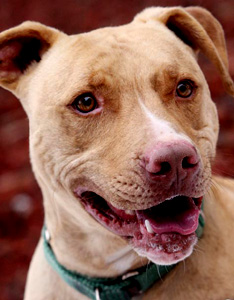 Zander
the dog has become a real fan of the old saying "If at
first you don’t succeed.…" It took more than
one try to help the poor guy feel better. Zander
the dog has become a real fan of the old saying "If at
first you don’t succeed.…" It took more than
one try to help the poor guy feel better.
As a young dog, he was found alongside the road in the middle
of nowhere. He’d apparently just been hit by a car and
couldn’t walk. He was rushed to Best Friends for some
urgent care.
In the accident, Zander had broken his pelvis and femur. At
Best Friends, he received all the emergency medical care he
needed, but then he threw everybody a curveball. After healing
up, his hip bones realigned over time and left him with a
new, false hip joint. Meanwhile, the original hip joint was
more or less stuck in place because some leftover bone was
trapped there. Zander got to where he couldn’t move
the hip much. For an active guy like him, that was really
cramping his style!
The Best Friends vets decided to operate. Their plan was to
remove the old piece of bone stuck in the original hip socket,
which would let the joint move freely again. Only problem
was, they couldn’t get the femur ball out of the pelvis
socket to begin with. Yikes! Zander’s anatomy had changed
after the accident and it was really wedged in there.
Because they couldn’t get the ball out of the socket,
the vets couldn’t remove the offending piece of bone.
They had hit a dead end. Still, they weren’t ready to
give up. They wanted to try again.
The second time around, however, they brought in some extra
help. Best Friends vet Dr. Patti asked her pal Dr. Patricia
(Trish) Kupanoff of Phoenix, Arizona, to come and assist in
round two. Dr. Trish has helped out at Best Friends with tricky
surgeries before, one of them being Pepper the pig’s
groundbreaking, never-before-attempted and ultimately successful
shoulder surgery. Dr. Trish, a board-certified surgical specialist,
agreed to help with Zander.
Using Dr. Trish’s expertise, the vets were able to better
expose the joint and remove the offending bone piece by piece.
In the end, they pulled off what they set out to do and Zander’s
joint is moving so much better. (Thanks, Dr. Trish!)
What’s next for Zander? Well, once his skin heals, he’ll
be off to do hydrotherapy and other physical therapy. The
vets have high hopes for a great recovery. One leg is now
shorter than the other, though, so according to Dr. Patti,
"There may always be a little hitch in his getalong."
Still, at long last he should be able to burn through all
that pent-up energy. After all, there’s nothing more
frustrating than wanting to bounce off the walls and having
an old injury hold you back. Congrats, Zander
Photo
by Sarah Ause
|

Weird
But True
By Jeremy Olsham
August 8, 2008
A deep
throated canine managed to swallow a 2-foo-long stick whole.
Hector,
a Great Dane puppy, got a coniferbranch lodged between his
neck and his stomach while playing in his family's garden
in Britain.
The stick
was removed wit a forceps by a veterinarianwho presented Hector's
owner with a $4,000 bill.
|

TRUE CLASSIFIEDS
From Marge Escalet
August
7, 2008
FREE
YORKSHIRE TERRIER.
8 years old. Hateful little bastard. Bites!
FREE PUPPIES: 1/2 Cocker Spaniel, 1/2 sneaky
neighbor's dog.
FREE PUPPIES.. Mother, AKC German Shepherd.
Father, Super Dog...able to leap tall fences in a single bound.
FOUND DIRTY WHITE DOG. Looks like a rat. Been out a
while. Better be a big reward.
|

Op-Ed Contributor
It’s Too Hot for Dog on the Menu
By FUCHSIA DUNLOP
Published:
August 4, 2008
London
 THOSE
who hope to taste dog meat when they visit Beijing
for this summer’s Olympics may be disappointed. The
Beijing Catering Trade Association has ordered all 112 designated
Olympic restaurants to take dog off the menu, and has strongly
advised other establishments to stop serving it until September.
Waiters have been urged to “patiently” suggest
alternative dishes to customers who ask for dog. It’s
all part of a wider campaign to avoid offending foreigners
during the Games. (Beijingers have also been told to line
up nicely, to stop spitting and even to avoid asking tourists
questions about their ages, salaries and love lives.) THOSE
who hope to taste dog meat when they visit Beijing
for this summer’s Olympics may be disappointed. The
Beijing Catering Trade Association has ordered all 112 designated
Olympic restaurants to take dog off the menu, and has strongly
advised other establishments to stop serving it until September.
Waiters have been urged to “patiently” suggest
alternative dishes to customers who ask for dog. It’s
all part of a wider campaign to avoid offending foreigners
during the Games. (Beijingers have also been told to line
up nicely, to stop spitting and even to avoid asking tourists
questions about their ages, salaries and love lives.)
The order is not likely to bother many residents. Though dogs
have been raised for food in China for thousands of years,
you have to hunt around to find the meat on modern menus.
Certain regions, like Hunan and Guizhou Provinces, are known
for their canine predilections — but even in these places,
dog is a relative rarity. And in Beijing itself, you hardly
find it except in a few Korean and regional Chinese restaurants.
Dog eating, in any case, tends to be a seasonal pursuit. According
to Chinese folk dietetics, which classify every food according
to its heating and cooling properties, dog is one of the “hottest”
meats around, best eaten in midwinter, when you need warmth
and vital energy, not in sultry August.
That eating dog is seen as an issue says more about Western
preoccupations than Chinese habits. Since time immemorial,
Westerners have had a morbid fascination with the weird fringes
of the Chinese diet. Marco Polo noted with distaste that the
Chinese liked eating snake and dog; modern Western journalists
just love to get their teeth into a juicy story about some
revolting delicacy like the assorted animal penises served
at the Guolizhuang restaurant in Beijing. And for gung-ho
foreign tourists, a skewerful of deep-fried scorpions in the
night market in central Beijing has become a rite of passage.
In case you’re wondering, there is nothing alarming
about the taste of dog: smothered in chilies and aromatic
spices in a Hunanese winter stew, it might remind you of lamb.
For a Westerner, eating it can feel a little strange, but
is it morally different from eating, say, pork? The dogs brought
to table in China are not people’s pets, but are raised
as food, like pigs. And pigs, of course, are also intelligent
and friendly.
So what has induced the Chinese government to ban the serving
of dog meat during the Olympics? One might observe that when
it comes to important issues like human rights in Tibet, Chinese
leaders don’t seem to care what the rest of the world
thinks, yet when it comes to dietary niceties, they kowtow
to the most irrational foreign prejudice.
It’s partly because the “issue” of dog-eating
seems to be a magnet for animal rights activists. Many Westerners
are genuinely shocked and offended at the idea of eating an
animal they consider to be “man’s best friend.”
Other morally questionable food practices — such as
eating shark’s fin and cutting up live turtles —
don’t appear to bother them so much. And after the Tibet
riots and the Olympic torch debacle earlier this year, Beijing
is keen to minimize the chance of more public relations disasters.
South Korea likewise banned dog from menus during the 1988
Seoul Olympics in the hope of avoiding bad publicity.
Opinions about dog-eating are changing in China, too, as more
people come to see dogs as adorable pets. A message board
on sohu.com, one of the most popular Chinese-language Internet
news sites, was peppered with posts supporting the ban. “The
barbaric custom of eating dog should be illegal,” said
one writer. Another wrote, “Thanks to the Olympics for
bringing an advance in social civilization.”
Perhaps the key reason for the ban is a pervasive Chinese
embarrassment about behavior that Westerners might consider
“backward” (luo hou), like spitting, shoving your
way onto a crowded bus — or eating dog. Despite their
country’s meteoric rise as an international player,
many Chinese, still smarting from the historical humiliation
of the 19th-century opium wars against Britain, are acutely
sensitive to foreign criticism. They share their government’s
desire to present a clean, modern image to the world.
The irony is that many of the things the Chinese increasingly
see as “backward” are those most attractive to
foreigners: street traders, wet markets selling fresh produce,
narrow hutong alleyways and higgledy-piggledly houses. Why
go to Beijing if all you see is skyscrapers and Starbucks?
Westerners commenting on the dog ban on the Web have been
divided between approving dog-lovers and people outraged at
Beijing’s failure to stick up for Chinese culture and
tradition. In the end, those most likely to lament the ban
are tourists hoping to shock their friends back home with
wild tales of eating doggy hotpot.
Fuchsia Dunlop is the author of “Shark’s Fin and
Sichuan Pepper: A Sweet-Sour Memoir of Eating in China.”

Illustration:
Sophia Martineck
|
OF
GENERAL INTEREST

Op-Ed Columnist
A Farm Boy Reflects
By NICHOLAS D. KRISTOF
Published:
July 31, 2008
YAMHILL, Ore.
In a
world in which animal rights are gaining ground, barbecue
season should make me feel guilty. My hunch is that in a century
or two, our descendants will look back on our factory farms
with uncomprehending revulsion. But in the meantime, I love
a good burger.
This comes up because the most important election this November
that you’ve never heard of is a referendum on animal
rights in California, the vanguard state for social movements.
Proposition 2 would ban factory farms from raising chickens,
calves or hogs in small pens or cages.
Livestock rights are already enshrined in the law in Florida,
Arizona, Colorado and here in Oregon, but California’s
referendum would go further and would be a major gain for
the animal rights movement. And it’s part of a broader
trend. Burger King announced last year that it would give
preference to suppliers that treat animals better, and when
a hamburger empire expostulates tenderly about the living
conditions of cattle, you know public attitudes are changing.
Harvard Law School now offers a course on animal rights. Spain’s
Parliament has taken a first step in granting rights to apes,
and Austrian activists are campaigning to have a chimpanzee
declared a person. Among philosophers, a sophisticated literature
of animals rights has emerged.
I’m a farm boy who grew up here in the hills outside
Yamhill, Ore., raising sheep for my F.F.A. and 4-H projects.
At various times, my family also raised modest numbers of
pigs, cattle, goats, chickens and geese, although they were
never tightly confined.
Our cattle, sheep, chickens and goats certainly had individual
personalities, but not such interesting ones that it bothered
me that they might end up in a stew. Pigs were more troubling
because of their unforgettable characters and obvious intelligence.
To this day, when tucking into a pork chop, I always feel
as if it is my intellectual equal.
Then there were the geese, the most admirable creatures I’ve
ever met. We raised Chinese white geese, a common breed, and
they have distinctive personalities. They mate for life and
adhere to family values that would shame most of those who
dine on them.
While one of our geese was sitting on her eggs, her gander
would go out foraging for food — and if he found some
delicacy, he would rush back to give it to his mate. Sometimes
I would offer males a dish of corn to fatten them up —
but it was impossible, for they would take it all home to
their true loves.
Once a month or so, we would slaughter the geese. When I was
10 years old, my job was to lock the geese in the barn and
then rush and grab one. Then I would take it out and hold
it by its wings on the chopping block while my Dad or someone
else swung the ax.
The 150 geese knew that something dreadful was happening and
would cower in a far corner of the barn, and run away in terror
as I approached. Then I would grab one and carry it away as
it screeched and struggled in my arms.
Very often, one goose would bravely step away from the panicked
flock and walk tremulously toward me. It would be the mate
of the one I had caught, male or female, and it would step
right up to me, protesting pitifully. It would be frightened
out of its wits, but still determined to stand with and comfort
its lover.
We eventually grew so impressed with our geese — they
had virtually become family friends — that we gave the
remaining ones to a local park. (Unfortunately, some entrepreneurial
thief took advantage of their friendliness by kidnapping them
all — just before the next Thanksgiving.)
So, yes, I eat meat (even, hesitantly, goose). But I draw
the line at animals being raised in cruel conditions. The
law punishes teenage boys who tie up and abuse a stray cat.
So why allow industrialists to run factory farms that keep
pigs almost all their lives in tiny pens that are barely bigger
than they are?
Defining what is cruel is, of course, extraordinarily difficult.
But penning pigs or veal calves so tightly that they cannot
turn around seems to cross that line.
More broadly, the tide of history is moving toward the protection
of animal rights, and the brutal conditions in which they
are sometimes now raised will eventually be banned. Someday,
vegetarianism may even be the norm.
Perhaps it seems like soggy sentimentality as well as hypocrisy
to stand up for animal rights, particularly when I enjoy dining
on these same animals. But my view was shaped by those days
in the barn as a kid, scrambling after geese I gradually came
to admire.
So I’ll enjoy the barbecues this summer, but I’ll
also know that every hamburger patty has a back story, and
that every tin of goose liver pâté could tell
its own rich tale of love and loyalty.
I invite you to comment on this column on my blog,
http://kristof.blogs.nytimes.com/2008/07/30/your-comments-on-my-animals-column/
RESPONSE
Comment
#405.
July 31st, 2008, 3:29 pm
Not original but applicable:
“The greatness of a nation and its moral progress
can be judged by the way its animals are treated.”
- MOHANDAS GHANDI
or
“Beware the beast Man, for he is the Devil’s
pawn. Alone among god’s primates, he kills for
sport or lust or greed. Yea, he will murder his brother
to possess his brother’s land. Let him not breed
in great numbers, for he will make a desert of his
home and yours. Shun him; drive him back into his
jungle lair, for he is the harbinger of death.”
THE PLANET OF THE APES — ROD SERLING & MICHAEL
WILSON
or
“The human race had yet to render itself extinct;
perhaps the animals were just a dry run. Once you
believed animals were insensate things, disposable,
of utilitarian value only, it wasn’t hard to
move on to people.” — NICHOLAS CHRISTOPHER
in “The Bestiary”
ROBERT COANE
http://From-The-DOGHOUSE.com
— Posted by Robert Coane
>>>>>>>>>>>
Comment #663.
August 2nd, 2008 10:41 am
To comment #594 posted by
Jane Cain (In full at bottom)
August 1st, 2008, 1:39 pm
“I had just read the enclosed before reading
your piece. I think God is more important than animals.
I hope someone will write in defense of Him too.
‘Desecration of Host Not Seen as Free Speech’
”
The comment above, #594, clamors for a response.
It is totally “off-topic” so I have no
idea why your “moderators” decided to
post it in the first place. This is not a “free
speach” issue. It injects a particular brand
of religious belief and topic where it deffinitely
doesn’t belong.
I have twice been blocked from responding. Faithfully
following all the rules of your “Comments FAQ”,
I will try a third time:
God is indefensible. “In his own image”,
he created Man to wreak havoc on all Creation.
“The higher power is lower to the ground and
walks on four feet.” - Elena Sigman
— Posted by Robert Coane
>>>>>>>>>>>
Comment #594
August 1st, 2008
1:39 pm
I had just read the enclosed before reading your piece.
I think God is more important than animals.
I hope someone will write in defense of Him too.
Thanks
Jane
Desecration of Host Not Seen as Free Speech
-- Confraternity Proposes Prayer Day in Reparation
HARRISBURG, Pennsylvania, JULY 30, 2008 (Zenit.org).-
The Confraternity of Catholic Clergy is proposing
Friday as a national day of prayer and fasting in
the wake of the desecration of the Eucharist by a
Minnesota professor.
Father John Trigilio, Jr., the president of the confraternity,
a U.S. association of 600 priests and deacons, sent
a statement this week asking Catholics “to join
in a day of prayer and fasting that such offenses
never happen again.”
Paul Myers, a professor of biology at the University
of Minnesota at Morris, says he desecrated the Eucharist
by piercing it with a rusty nail, then he threw it
into the trash.
The self-professed atheist wrote about the incident
on his blog and posted a photo of the desecrated host.
The statement of the Confraternity of Catholic Clergy
said it found the actions of Myers “reprehensible,
inexcusable, and unconstitutional. His flagrant display
of irreverence by profaning a consecrated Host from
a Catholic Church goes beyond the limit of academic
freedom and free speech.”
“Attacking the most sacred elements of a religion
is not free speech anymore than would be perjury in
a court or libel in a newspaper,” added the
text.
Father Trigilio told ZENIT that the congregation is
asking the faithful to make a holy hour before the
Eucharist on Aug. 1, the feast of St. Alphonsus Ligouri,
and to fast in “reparation for the sacrilegious
desecration of the Holy Eucharist.”
— Posted by Jane Cain
|
|

Top Dog Model
Episode
04: July 30, 2008
While the dogs continue to bond, jealousy drives a stake into
the heart of the relationship of two of the owners. At the
Dog Bone Challenge some owners are shocked to find out they
don't know their dogs as well as they think they do. While
taking a dip in the pool, Tillman displays his very special
technique of water conservation. Each
dog/owner team spends time with a famous doggie photographer
to come up with a shot to impress the judges.

|

S#!* happened --
How New
York Convinced Dog Ownwers to Scoop Poop
By MICHAEL
BRANDOW
July 27,
2008
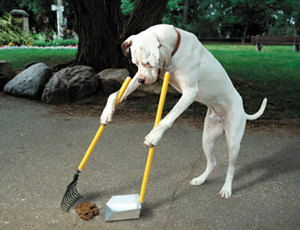 On this, the 30th anniversary birthday of our famous "poop
scoop" law, the first of its kind to work in a big city
and model for communities around the world, what are we celebrating
- besides the fact that we don't have to scrape something
off our shoes?
On this, the 30th anniversary birthday of our famous "poop
scoop" law, the first of its kind to work in a big city
and model for communities around the world, what are we celebrating
- besides the fact that we don't have to scrape something
off our shoes?
Probably the fact that Health Law 1310 happened at all. These
days, picking up after a dog is such a normal part of daily
life that many owners do it automatically. Dogged and dogless
New Yorkers alike don't want to remember a time, not long
ago, when a common-sense solution to a
mounting urban problem was neither popular nor the only answer.
They're still wincing over a civil war that divided people
cleanly into pro-dog and anti-dog lobbies - with nothing in
between.
But 1310 was also a new kind of law, a forebear of the sort
of initiatives - particularly popular under Mayor Bloomberg
- that, for good or ill, try to make us better people.
It was New York's decline in the early 1970s that allowed
the poop-scoop law to pass in the first place. More people
owned dogs for protection, and strays ran through the boroughs.
Alan Beck, the head of the Bureau of Animal Affairs, estimated
that by 1975, there were 300,000 to 500,000 pounds of dog
crap left on city pavements daily.
Had the city been, er, flush, it could have hired more sanitation
workers to handle the problem. But New York was in the midst
of a fiscal crisis, basic services were being scaled back,
and street cleaners refused to do more dirty work.
When
eyes turned to the owners, author Cleveland Amory and other
animal rights advocates, along with humane organizations and
shelters, united against a "pick it up yourself"
proposal they considered harsh and unfair.
In the long run, they predicted, the law would force people
to abandon their loved ones, and would lead to an eventual
ban on dogs. Sidewalks and public lawns weren't worth preserving
at any cost.
"Like the Jews of Nazi Germany," said the head of
New York's Dog Owners Guild with typical understatement, "we
citizens, including the old and the infirm, are being humiliated
by being forced to pick up excrement from the gutter."
A raucous hearing in 1972 led to a stalemate and citizens
started taking matters into their own hands. Town meetings
degenerated into shouting matches and the stuff didn't just
hit the fan - it was thrown at people.
On the pavement, walking a dog could be stressful and even
violent. The simple pleasures of canine companionship were
spoiled as paranoid pet owners looked over their shoulders
for vigilantes, not always sure that someone would rise to
their defense.
It took several years of bad community relations, and a no-nonsense
mayor like Ed Koch, who went to the state level for support,
before the fighting ended. But even in Albany there was strong
resistance to the scoop. Not all the "nays" were
given out of sympathy for people who'd gotten dogs for protection
and companionship in a dangerous and alienating urban environment
- though many leaders did think it was dehumanizing to force
anyone to handle feces. The main concern was that similar
laws had already
been tried and failed in other places, and those opposed feared
that yet another unenforceable decree would only encourage
more disrespect for authority in general.
The irony is that they were right, at least about the unenforceable
part. Health Law 1310, which eventually passed in August 1978,
was tough to police and erratically used. It succeeded not
because of fines (of which there weren't huge numbers), but
because the debate forced dog owners to take action.
Slowly but surely, owners learned that picking up wasn't so
bad. They started to believe that lending a helping hand would
get New York back on its feet. The vast majority of dogs owners
continue to comply, not because they have to - they never
really did - but because they want to.
Cleaning up a dog's mess had become, as Parks Commissioner
Henry Stern rejoiced, "a respectable and honorable act."
No doubt Bloomberg noted the poop-scoop law's achievement
when he proposed his smoking ban. Like 1310, the amazing success
of anti-smoking legislation has more to do with peer pressure
than police officers handing out tickets. But the simple act
of legislating antisocial behavior shamed people into compliance.
If there are downsides to 1310, it's when legislators take
the precedent too far. In the case of the poop-scoop law itself,
there are calls to increase the fines - proposed by of all
people Sen. Frank Pavadan, who
opposed the original legislation - and video surveillance
of dog walkers in Brooklyn and the Bronx.
These measures are insulting and a waste of taxpayers' money.
Picking up dog waste makes our lives better, but tracking
those who don't do it like terrorists is draconian.

Then there are the other laws to "make our lives better,"
to get us to eat less fat
and count our calories
and
maybe exercise a little. We can all perhaps agree on limiting
the amount of noise in our neighborhood, but should we ticket
a crying child? Air conditioners are wasteful, but can we
legislate people to limit their use? Is your stroller too
wide? Do you smell on the subway? There's a line between improving
our lives and meddling with them.
But as long as we're vigilant about that boundary, it's hard
to argue that Health 1310 wasn't a law that
changed New York for the better - and proved we're a little
nicer than people give us credit for. It cleared the air in
more ways than one.
|

Surgery
Will Put Dog With Amputated Leg Back On All Fours Again
July 27, 2008
A pioneering
North Carolina State University collaboration between a veterinary
surgeon and an engineer will give a deserving dog the ability
to walk on four legs again.
Cassidy, a male German shepherd mix, was born with a defect
in his right hind leg. His owner was referred to NC State's
College of Veterinary Medicine in 2005 in order to have the
defective limb removed. Three years later, Cassidy is back,
this time for surgery that will replace the lost leg with
an osseointegrated prosthetic limb.
Dr. Denis Marcellin-Little, associate professor of orthopedics,
and Dr. Ola Harrysson, associate professor of industrial and
systems engineering, are pioneers in the area of osseointegration,
a process that fuses a prosthetic limb with an animal's (or
human's) bones. The result is a custom-designed, limb-sparing
prosthesis that behaves more like a natural limb - and a technique
with implications for the future of human prosthetics.
Marcellin-Little and Harrysson began their work on osseointegrated
pet prosthetics in 2005 with a cat named George Bailey, who
had been born without the lower half of his hind legs. Harrysson
designed and built the limb in collaboration with his students
and Marcellin-Little, who performed the surgery. The procedure
involved inserting a titanium nail into one of the legs and
securing it with screws.
Since then, the collaborators have improved and strengthened
the design, and Cassidy's limb surgery will be the third of
its kind- and the first such surgery on a dog - performed
at NC State.
"This research collaboration, along with new technologies,
has made it possible for us to custom design and directly
fabricate metal prosthetic implants in a timely and economical
fashion," Harrysson says. "Ten years ago this process
would have taken much longer, cost much more and not been
as accurate. We see this process becoming even faster and
more cost-effective in the future."
The researchers hope that Cassidy won't be the sole beneficiary
of this surgery.
"The implications for this procedure are huge,"
Marcellin-Little says. "As we gain more experience with
the surgical technique and the design of the limbs, we see
the possible benefits for humans - implants that allow the
prosthetic limbs to attach without chafing or irritation,
and limbs with more natural ranges of motion. We believe that
this is the future of prosthetics."
|

Editorial
A Stay of Execution for the Wolves
Published:
July 26, 2008
 A
federal judge in Missoula, Mont., has given Rocky Mountain gray
wolves a well-deserved reprieve. In February, the federal Fish
and Wildlife Service had effectively sentenced hundreds of wolves
to death by lifting the protections provided by the Endangered
Species Act. Since then, because of far weaker state protections
in Wyoming, Montana and Idaho, more than 100 wolves out of a
total population of 1,500 have been killed. As many as 500 more
were doomed to die in state-authorized hunts this fall. A
federal judge in Missoula, Mont., has given Rocky Mountain gray
wolves a well-deserved reprieve. In February, the federal Fish
and Wildlife Service had effectively sentenced hundreds of wolves
to death by lifting the protections provided by the Endangered
Species Act. Since then, because of far weaker state protections
in Wyoming, Montana and Idaho, more than 100 wolves out of a
total population of 1,500 have been killed. As many as 500 more
were doomed to die in state-authorized hunts this fall.
Judge Donald Molloy issued a preliminary injunction last week
restoring federal protections. That ends the slaughter, at least
for now. And while the case is far from settled, the dozen conservation
groups that brought the suit are hopeful that his injunction
will survive further court tests and that the Fish and Wildlife
Service will be forced to provide a better plan to protect the
wolves.
The centerpiece of Judge Molloy’s decision was his finding
that the Fish and Wildlife Service had failed to meet its own
criteria for removing the wolf from the endangered species list.
Before stripping the wolves of federal protection, the agency
was required to show that wolf subpopulations across the area
were interbreeding — a genetic necessity for healthy,
sustainable numbers. The judge found that the agency had offered
no such evidence.
Judge Molloy also found that this fall’s hunts could irreparably
damage the species. He seemed particularly annoyed at the agency’s
failure to explain why it had “flip-flopped” on
Wyoming’s plan, which allows unregulated hunting on most
state lands. The agency had previously rejected it as insufficiently
protective.
All three states have weak plans — not one has made a
firm, enforceable commitment to maintain viable wolf populations
— but Wyoming’s is the worst. Under its management
plan, the wolf is treated as a predator — liable to be
shot on sight — in parts of the state and as a trophy
game animal in the rest.
This deep-set hostility has only a little to do with ranching.
It is really driven by the competition between human hunters
and wolves for the same game animals: elk and deer. And underneath
it all is a false myth — the wolf as a kind of ferocious
coward and an indiscriminate killer — that says less about
the true nature of wolves than it does |
 - URGENT -
- URGENT -
Health
Officials Warn of Dog Flu Outbreak in N.J. NEW
JERSEY
Posted: Wednesday,
23 July 2008
Health officials are urging New Jersey's vets and kennel owners to
be on the lookout for cases of dog flu.
Several hundred dogs have already become ill, State Vet Colin
Campbell said. They're the first reported cases since the
virus first hit the Garden State in 2005.
Canine Influenza is highly contagious and has no known cure.
It's most easily spread in places where dogs gather -- kennels,
dog shows, animal shelters, grooming salons and dog parks. It
can also be transmitted by humans.
Several confirmed cases lead to the voluntary shutdown of a
kennel in West Windsor two weeks ago.
"We have no idea where it started," kennel owner David
Horowitz told The Star Ledger. "It's something that every
facility is going to be dealing with because dogs have no natural
immunity to the disease."
Symptoms include a low-grade fever, nasal discharge, and
a persistent cough. Severe cases include a high fever,
breathing difficulties. |
 DNA
Study Unlocks Mystery To Diverse Traits In Dogs
DNA
Study Unlocks Mystery To Diverse Traits In Dogs
June 23, 2008
What makes a pointer point, a sheep dog herd, and a retriever
retrieve? Why do Yorkshire terriers live longer than Great Danes?
And how can a tiny Chihuahua possibly be related to a Great
Dane?
Dogs vary in size, shape, color, coat length and behavior more
than any other animal and until now, this variance has largely
been unexplained. Now, scientists have developed a method to
identify the genetic basis for this diversity that may have
far-reaching benefits for dogs and their owners.
In the cover story of tomorrow's edition of the science journal
Genetics, research reveals locations in a dog's DNA that contain
genes that scientists believe contribute to differences in body
and skull shape, weight, fur color and length -- and possibly
even behavior, trainability and longevity.
"This exciting breakthrough, made possible by working with
leaders in canine genetics, is helping us piece together the
canine genome puzzle which will ultimately translate into potential
benefit for dogs and their owners," said study co-author
Paul G. Jones, PhD, a Mars Veterinary™ genetics researcher
at the Waltham® Centre for Pet Nutrition -- part of Mars®
Incorporated, a world leader in pet care that has been studying
canine genetic science for the past eight years. "By applying
this research approach, we may be able to decipher how genes
contribute to physical or behavioral traits that affect many
breeds."
Dogs originally derived from the wolf more than 15,000 years
ago -- a blink of the eye in evolutionary terms. Selective breeding
produced dogs with physical and behavioral traits that were
well suited to the needs or desires of their human owners, such
as herding or hunting ability, coat color and body and skull
shape and size. This resulted in the massive variance seen among
the more than 350 distinct breeds that make up today's dog population.
Until now, the genetic drivers of this diversity have intrigued
scientists who have been trying to explain how and why the difference
in physical and behavioral traits in dogs changed so rapidly
from its wolf origins.
An international team of researchers, which included scientists
at the National Human Genome Research Institute, the University
of Utah, Sundowners Kennels in Gilroy, California and Mars'
Waltham Center for Pet Nutrition in the United Kingdom, studied
simple genetic markers known as Single Nucleotide Polymorphisms,
or SNPs, to find places in the dog genome that correlate with
breed traits. Because many traits are "stereotyped"
-- or fixed within breeds -- researchers can zero in on these
"hot spots" to see what specific genes are in the
area that might contribute to differences in traits.
The research used 13,000 dog DNA samples provided by Mars Veterinary,
which holds one of the most comprehensive canine DNA banks in
the world. This collection has been built up with the help of
pet owners who have consented to their pets providing cheek
swabs and blood samples for the database. Mars' DNA bank allowed
the study to cover most of the American Kennel Club recognized
breeds that span a wide variety of physical and behavioral traits
and differences in longevity.
"With further refinement and additional data, this method
could be used to tailor products that may benefit the health
of pets," Jones said. "Pet owners and veterinarians
may be able to develop better care regimes based on this knowledge.
In addition, genetic information about behavioral traits, such
as trainability and temperament, could also help veterinarians
identify the most lifestyle-appropriate pet for an owner."
This research may also have implications for human health, as
dogs suffer from many of the same diseases that we do.
Mars is continuing its commitment to canine genetic science
with ongoing investigations to better understand the makeup
of a dog's DNA to help benefit the lives of dogs and their owners.
The Wisdom Panel MX™ mixed breed analysis test is the
first product to use the knowledge gained through this research.
Learn more about the Wisdom Panel and this new study at http://www.wisdompanel.com.
|
 Yonkers
Police Fire Weapons 66 Times, 64 at Animals
Yonkers
Police Fire Weapons 66 Times, 64 at Animals
Posted:
Monday, 21 July 2008
YONKERS, N.Y. (AP) -- When police in one of the biggest
cities in New York City's northern suburbs fire their guns,
it's almost always at an animal.
Yonkers police records show officers have discharged their weapons
66 times in the last two years. Last year, the police fired
46 times: 45 were at animals including dogs and deer, one was
accidental. The year before, they fired 20 times: 19 were at
animals, one was at a person.
Yonkers released the data this month in response to a Freedom
of Information Law request by The Journal News. The newspaper
says it's investigating a man's claims that police shot him
when they executed a search warrant on his apartment and shot
his three pit bulls to death. |

Pit Bull Fighting for Life after Rattlesnake Bite
Posted: Monday, 21 July 2008
A pit bull is fighting for his life, after being bitten by a
rattlesnake in the Bronx Tuesday.
Miguel Mota, the dog's owner, was walking the male pit bull,
named "Stone," in a public park near the Bronx Zoo
at Boston Road and Bronx Park East when the dog went into the
bushes and yelped.
When he came out of the bushes, he was bleeding, and Mota rushed
Stone to the Bronx Zoo - and then to several vet hospitals that
couldn't deal with a snake bite until he got to the NYC Veterinary
Specialists at 55th Street and 9th Avenue in Manhattan.
Dr. Ben Davidson diagnosed the wounds and bites from a rattlesnake,
and immediately gave the dog anti-venom - in an effort to save
its life.
The dog is still being treated - but will need much more anti-venom,
something that is in very short supply in New York. Mota says
he can't afford the $4,000 bill racked up so far, and so for
now the doctors are paying out of their own pockets.
Mota says he knew it was a rattlesnake, because he saw one on
the Discovery Channel, and it's still out there somewhere near
the Bronx Zoo.
He says he fears if a child were to have been near the area
and gotten bitten.
|

LOST
& HOUND IN QUEENS
RETURNS 5 YRS., 850 MILES LATER
By JEREMY OLSHAN
July 15,
2008
NOW STAY, ROCCO! Rocco back in Queens with Natalie
Villacis yesterday.
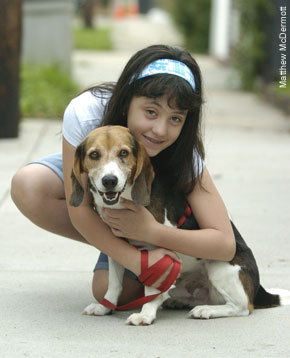 When
her beagle, Rocco, squeezed himself under the backyard gate
and disappeared into the streets of Queens, 5-year-old Natalie
Villacis refused to believe - as her parents reluctantly told
her - that she would When
her beagle, Rocco, squeezed himself under the backyard gate
and disappeared into the streets of Queens, 5-year-old Natalie
Villacis refused to believe - as her parents reluctantly told
her - that she would
never see the puppy again. That was in 2003.
Last weekend, Rocco came home - after being found in Georgia.
The prodigal pooch turned up in a shelter 850 miles away in
Hinesville, and by a combination of chance and chip - the
one embedded in his back - was reunited with Natalie, now
11, and her family.
"When my mom told me they found Rocco, I cried hysterically
- just like I did when they told me he was lost," Natalie
told The Post. "I felt like I was in a dream, like my
head was spinning."
Someone dropped Rocco off as a stray at the Liberty County
Animal Control in Hinseville on July 5, supervisor Randy Durrence
said.
|
After scanning the pooch's identity microchip, one of thousands
routinely implanted in the skin of many pets today, Durrence
traced Rocco to Queens. Rocco's disappearance had been traumatic
for both Natalie and her parents.
In the days after he vanished, the weeping child and her father,
Jorge, plastered their neighborhood with signs in search of
the dog. But it soon became clear Rocco would not return.
Even after the family later brought a poodle mix named Bonita
into the home, Natalie said she never stopped wondering "what
happened to Rocco, where he went, and if someone good found
him.
"Every time I would see a dog on the street, I would
say to my mom, 'Maybe
Rocco will come back,' " Natalie said. "She would
say that he probably isn't going to come back. I would say,
'I know, but maybe he will.' " She even refused to part
with his favorite toy, a stuffed cat.
"At night, I would wish, 'Please Rocco, come home.' And
now that wish came true," she said.
When Natalie's parents, Jorge and Cristina, listened to the
voice mail Durrence left for the family, they thought he or
the computer must have made a mistake.
"We didn't think it could possibly be him - Natalie never
stopped thinking about him, but we thought he was gone for
good," Jorge said.
Jorge flew down to Georgia, and though he didn't quite recognize
Rocco, was pleased to see that aside from a scratch on his
ear, he was in perfect health.
"We have reunited families with their dogs before but
never after so many years - this is unheard of," Durrence
said.
Durrence said he could not imagine how a dog could make this
journey but speculated that since the town is home to Fort
Stewart and the Army's Third Infantry Division, "perhaps
it was someone in the military."
Natalie said she was nervous about Rocco's return, in part
because she was unsure how Bonita, the poodle mix the family
got in 2004, would react. "I don't think he recognized
me, but I told him I loved him as much as
always," she said. "Rocco seemed a little confused,
but happy. He looked at me like, 'I don't know who you are,
but I love you, too.' "
One of the first things she did was give Rocco his toy back.
Bonita has not decided if there is room for a beagle in the
house, she said, "but at least she hasn't tried to bite
him. Rocco doesn't mind. He's
as calm as pie."
Embracing
Rocco, Natalie asked her mother, "Where do you think
he has been all this time?" "I don't know,"
her mother told her. "But if he could tell us, I'm sure
he has more than enough material for a novel."
|

Pill-Popping Pets
By JAMES VLAHOS
Published:
July 13, 2008
Americans
are spending millions on mood-altering drugs for their cats
and dogs.
Is it because we’ve driven them mad?
|
|
| Photo
Illustrations by Zachary Scott for The New York Times |
Max retrieves
Frisbees. He gobbles jelly beans. He chases deer. He is —
and this should be remembered when discussions of cases like
his blunder into the thickets of cognitive ethology, normative
psychology and intraspecies solipsism — a good dog. A
3-year-old German shepherd, all rangy limbs and skittering paws,
he patrols the hardwood floors and wall-to-wall carpets of a
cul-de-sac home in Lafayette, Calif., living with Michelle Spring,
a nurse, and her husband, Allan, a retired airline pilot. Max
fields tennis balls with his dexterous forelegs and can stand
on his hindquarters to open the front door. He loves car rides
and will leap inside any available auto, even ones belonging
to strangers. Housebroken, he did slip up once indoors, but
everybody knows that the Turducken Incident simply wasn’t
his fault. “He’s agile,” Allan says. “He’s
healthy. He’s a good-looking animal.” Michelle adds,
“We love him to death.” That is why they had no
choice, she says. The dog simply had to go on psychoactive drugs.
Full
Article http://www.nytimes.com/2008/07/13/magazine/13pets-t.html
|

TV Star in the Making
by David Dickson
July
11, 2008
Georgia, the Vicktory dog—one of the dogs rescued from
the property of former NFL quarterback Michael Vick—might
just have to get herself a talent agent pronto. She’s
a rising star! Georgia attended the Television Critics Association’s
press tour in Los Angeles earlier this week and had the crowds
scrambling over themselves to give her belly rubs and head
scratches. Who cares about new sitcoms or reality game shows
when you have a TV personality who rolls on her back for tummy
tickles?
 This
loveable goofball is one of four Vicktory dogs to be featured
in an upcoming two-hour National Geographic Channel special:
"Dogtown: Saving the Michael Vick Dogs." In order
to help put a face to the show, Georgia attended the press
tour so that the critics and other attendees could see up
close what the show was all about. The Best Friends team included
John Garcia, Michelle Besmehn, Dr. Michael Dix, Elissa Jones,
Juliette Watt as pilot, and of course Georgia… who racked
up quite a bit more than 15 minutes of fame. This
loveable goofball is one of four Vicktory dogs to be featured
in an upcoming two-hour National Geographic Channel special:
"Dogtown: Saving the Michael Vick Dogs." In order
to help put a face to the show, Georgia attended the press
tour so that the critics and other attendees could see up
close what the show was all about. The Best Friends team included
John Garcia, Michelle Besmehn, Dr. Michael Dix, Elissa Jones,
Juliette Watt as pilot, and of course Georgia… who racked
up quite a bit more than 15 minutes of fame.
There were some pretty impressive acts in the lineup from
the various programs to be showcased, but in the end it was
Georgia who hogged all the limelight—and she did it
without even trying! The Best Friends team chose Georgia to
attend because they felt confident she would do well. Turns
out they were right.
She blew everybody away, whether at the press tour, on walks
throughout L.A. or while cruising through her luxury hotel
where she stayed with Best Friends’ dog trainer John
Garcia (stay tuned, John and Michelle will start blogging
about Georgia’s adventures next week).
As one of the dogs rescued from Michael Vick’s estate,
Georgia was due for a little pampering. She’s certainly
had her run of bad luck in the past, and the scars to prove
it. She was a prized fighter at one time, though her teeth
have since all been pulled, possibly so that she could be
bred safely. Georgia was sent to live at Best Friends along
with 21 other dogs because she was deemed one of the roughest
of the bunch.
The upcoming National Geographic Channel special will be following
the progress of Georgia and three other Vicktory dogs since
they’ve come to Best Friends. Part of the two-hour special
looks at the question of whether fighting dogs can ever overcome
their past, which Best Friends has always believed, but which
others have claimed impossible. (Hmmm....wonder if Georgia,
who’s been busily giving kisses to every stranger in
LA has an opinion?)
Even though it was a short trip, if her talent for dazzling
the cameras is any indication, she might as well get started
on writing her Emmy acceptance speech. Way to go Georgia!
The world needs celebrities like you.
Original:
http://news.bestfriends.org
Photos
of Georgia, John Garcia, Michelle Besmehn, and Georgia's adoring
fans by Best Friends staff
|
 Press
Release
Press
Release
ASPCA Forensic Veterinarian Aids in Major
Dog Fighting Raid in Georgia
NEW YORK,
July 3, 2008
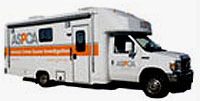 The
ASPCA ®(The American Society for the Prevention of Cruelty
to Animals ®) today announced that it was part of a team
of animal welfare agencies, led by the Humane Society of the
United States (HSUS), as well as the Madison County, Ga. Sheriff’s
Department and Madison County Animal Control, which participated
in a major planned raid of “Shake Down Kennels,”
an alleged dogfighting operation in Danielsville, Ga.
Johnny Johnson, the alleged owner, was arrested and
charged with felony dogfighting. The
ASPCA ®(The American Society for the Prevention of Cruelty
to Animals ®) today announced that it was part of a team
of animal welfare agencies, led by the Humane Society of the
United States (HSUS), as well as the Madison County, Ga. Sheriff’s
Department and Madison County Animal Control, which participated
in a major planned raid of “Shake Down Kennels,”
an alleged dogfighting operation in Danielsville, Ga.
Johnny Johnson, the alleged owner, was arrested and
charged with felony dogfighting.
“The ASPCA is proud to assist HSUS in their raid of this
illegal dogfighting ring,” said ASPCA President &
CEO Ed Sayres. “Dr. Merck is the nation’s premiere
“Animal CSI” and adding her invaluable knowledge
of veterinary forensics to the crucial investigation work done
by HSUS and participating agencies makes for a tremendous combination.”
The raid took place in Madison County, Ga. and resulted in seven
dogs being seized for examination and evidence, as well as dogfighting
paraphernalia. Dr. Melinda Merck, ASPCA’s senior director
of Veterinary Forensics, and Felicia Earley, an anti-cruelty
veterinary assistant with the ASPCA, were part of the elite
team of animal welfare professionals involved. The ASPCA’s
Mobile Animal Crime Scene Investigation (CSI) Unit, was also
on-site to allow Dr. Merck to examine and care for any victims
immediately, as well as gather and process all of the forensic
evidence right at the scene. A “forensics first,”
the mobile unit is specially-designed vehicle outfitted with
state-of-the-art forensics tools as well as medical equipment
tailored for animal patients.
“It was a privilege being able to be a part of this organized
and thorough investigation,” said Dr. Merck. “Dogfighting
cases are very complex and it sometimes takes multiple resources
in order to effectively bring them down. This collaborative
effort is a shining example of our ongoing fight against animal
cruelty.”
Today’s raid marks the first Ga. dogfighting bust since
the May 10 passage of new legislation signed by Governor Sonny
Purdue, which strengthened the state's dogfighting law, making
it a felony to own, possess, train, transport or sell a dog
for the purpose of dogfighting. Those involved in illegal dogfighting,
as Johnson is alleged, can receive one to five years in prison,
a minimum fine of $5,000 or both.
For more information about the ASPCA’s fight against animal
cruelty, visit http://www.fightcruelty.org/
. For more information about the ASPCA’s programs and
services, visit http://www.aspca.org/
|

Television
Who Let the Dogs On? You’d Be Surprised
By
LISA BERNHARD
Published:
July 6, 2008
IN the Oscar-nominated 1993 documentary “The War Room”
the producer R. J. Cutler helped chronicle the political maneuverings
of George Stephanopoulos and James Carville, the savvy architects
of Bill Clinton’s presidential run against President George
H. W. Bush. Fifteen years later Mr. Cutler finds his lens focused
on
|
Can
the skateboarding English bulldog Tillman outperform
the giant schnauzer Kenji and avoid expulsion from the
Canine Academy?
That Mr. Cutler has gone from the White House to the
Dog House with his coming CBS reality show, “Greatest
American Dog,” should not signal the decline of
his career.
A blend of “American Idol,” “Big Brother”
and “Survivor,” the series, which has its
premiere on Thursday, pits 12 dogs and their owners
against one another for a $250,000 reward. As it turns
out, competing presidential candidates and competing
dogs (or their caretakers) aren’t so different.
“What they have in common is the shared sense
that the prize should be theirs,” Mr. Cutler said.
Within the mansion and grounds outside Los Angeles that
have been turned into the Canine Academy for the show,
pet-and-human pairs showcase qualities like loyalty,
intelligence and teamwork before a jury of three dog
experts and the host, a zoologist named Jarod Miller.
|
Cliff
Lipson/CBS |
Elan
Hagens and the giant Schnauzer
Kenji |
Most
tasks are less about brawn than bond. In a personality challenge,
for instance, each owner picks a word out of a hat and then
takes a picture of the dog evoking the mood or thought that
word represents through props and expression.
As with children, working with animals can be dicey. In a
move that could help avoid a repeat of the controversy last
year surrounding “Kid Nation,” the CBS reality
series that drew questions about child neglect (though no
charges or lawsuits were filed), trainers, veterinarians and
representatives of the American Society for the Prevention
of Cruelty to Animals and the American Humane Association
were all on the set to ensure safety. And behind the scenes
a second set of so-called Dream Dogs, closely matching the
canine contestants in size, tested each stunt.
In any case, there is plenty of pet pampering. “Survivor”-esque
reward challenges mean that winning pairs get the elaborate
Dog Bone Suite, along with the power to banish another team
to the backyard Dog House. Naturally, it’s often the
humans who aren’t so well behaved.
“We’ve got our own Omarosa,” said Wendy
Diamond, a judge and the founder of Animal Fair magazine,
referring to one of the more controversial contestants on
“The Apprentice.” “If you look at this show
from a dog’s perspective, can you imagine having to
live with some of these owners? That’s what I was thinking:
Oh, that poor dog!”
In at least one case stage mother is a more fitting term than
dog owner. Beth Joy Knutsen, a New Yorker, employs four talent
agents for her little mixed-breed Bella Starlet, a veteran
dog actress.
“It’s really amazing to be recognized for her
achievements,” said Ms. Knutsen, who has a detailed
tattoo of Bella on her leg. “We’ve done so much,
and this is the next step in our journey of life together.”
On the show one of Ms. Knutsen’s rivals is David Best,
a New York doctor. His life of fancy restaurants and Broadway
theater was “all about me,” he said, until he
acquired Elvis, a Parson Russell terrier, and “fell
head over heels for this little dog.”
Calculating that Nov. 9 was Elvis’s 13th birthday (in
dog years), Dr. Best held a “bark mitzvah” last
year at Sammy’s Roumanian steak house on the Lower East
Side. About a hundred people attended, including the sex expert
Dr. Ruth Westheimer, a friend of Dr. Best’s. Video of
the event on the Web led to an invitation to take part in
“Greatest American Dog.”
Another 400 to 500 dogs and owners auditioned for the show,
with producers searching throughout the country for a cross
section of breeds and skills. The applicants ranged from house
pets to show-dog veterans, though Westminster champions were
not considered.
Mr. Cutler, who is an executive producer, said he had been
asked to develop a reality show about dogs by Ghen Maynard,
executive vice president for alternative programming at CBS,
after Stu Schreiberg, another of the show’s executive
producers, brought the idea to Mr. Maynard.
“My first reaction was, I can’t believe there
isn’t a competition show based around dogs on network
television,” said Mr. Cutler, whose reality credits
include “Flip That House” on TLC. “Although,
having spent many months on it, I can tell you there are a
lot of challenges in designing and filming it.” He cited
the difficulty in creating competitions that dogs of different
sizes, breeds and ages could all handle, adding, “I
can see how some might have been discouraged.”
But Ms. Diamond, a veteran of four failed dog-theme reality
pilots and two short-lived cable series, has her own theory
about the paucity of pet-friendly reality series. “There
are dog people, and there are not-dog people,” she said,
“and network executives tend to not have that unconditional
love.”
Mr. Maynard has a different take. “As much as the animals
are characters, reality shows are about people,” he
said. “So if the people aren’t compelling, and
if we don’t find the relationships they have compelling,
then all the dog tricks in the world aren’t necessarily
going to make an interesting show.”
And in the end the success of “Greatest American Dog”
may hinge on how well it taps into a basic human craving.
“I’ve caught myself running down the hallway in
my apartment building to get to the door to see Elvis,”
Dr. Best said. “And if you’ve ever been in love,
you do that with people, don’t you? There’s one
difference: When the door swings open, that person who loves
you could one day say, ‘Get lost.’ ”

Original:
http://www.nytimes.com/2008/07/06/arts/television/06bern.html?_r=1&ref=television&oref=slogin
Official Web Site: "Greatest
American Dog"
|

Ideas & Trends
Sit. Stay. Love.
By ERICA GOODE
Published: July 6, 2008
HUMANS are an overrated species, or so Leona
Helmsley apparently believed.
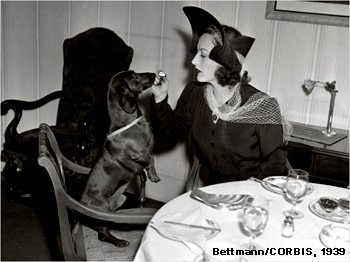 DOGGY
DEAREST Joan Crawford sharing a bite with her dog. Some
people share all with pets. DOGGY
DEAREST Joan Crawford sharing a bite with her dog. Some
people share all with pets.
|
She briefly
considered giving some of her real estate billions
to other humans — indigent people, to be specific
— but later changed her mind, leaving instead
up to $8 billion in a charitable trust solely for
the care and welfare of dogs. She favored her Maltese,
Trouble, over her family, providing $12 million for
the dog in her will, a lot more than she left her
grandchildren.
Predictably,
the news of the extent of Mrs. Helmsley’s charitable
bequest was greeted last week with outrage about misguided
priorities and
jokes about a wealthy
woman
so arrogant, imperious and ill-tempered that only
a canine could abide her.
But Mrs. Helmsley, though richer and crankier than
most, was hardly the first person to deem the companionship
of dogs
or other pets more gratifying
|
than that of people, raising the question of how common such
sentiments are and whether they represent a reasonable choice
in a world of fickle and unpredictable two-legged creatures,
or evidence of some deep-seated psychological disturbance.
The field of psychotherapy has traditionally viewed those
whose closest relationships are with animals as somehow lacking,
their affections pathologically misplaced, their devotion
a symptom of their inability to forge healthy connections
with the humans around them.
But in recent years, researchers have begun to take far more
seriously the bonds between humans and animals — perhaps
unsurprising in a society where more than 68 million households
include one pet — and to evaluate those relationships
in a more positive light.
Their findings support the notion that feeling closer to a
pet than to anyone else is more common than one might think.
“There are whole segments of the population that prefer
being in the company of dogs than people, and I’m not
sure that’s such a negative thing,” said Joel
Gavriele-Gold, a psychoanalyst in private practice in Manhattan
and the author of “When Pets Come Between Partners.”
One-third of the participants in a 1990 study by researchers
at Virginia Commonwealth University were found to have had
closer relationships to their dogs than to their family members,
as evidenced by scores on psychological tests.
In another study, Lawrence A. Kurdek, a psychologist at Wright
State University in Ohio, found that college students who
had a high level of attachment to their dogs showed greater
attachment to the pets than to their fathers. Their attachment
to their mothers, siblings and best friends was just about
the same as their attachment to their canine companions, Dr.
Kurdek found.
The study, reported in the April issue of the Journal of Social
and Personal Relationships, found that the students who were
most strongly attached to their dogs did not show high levels
of anxiety or avoidance — characteristics that some
therapists would expect to see in people with unusually fierce
bonds to animals.
The finding, Dr. Kurdek wrote, supports the idea that “people
strongly attached to their pet dogs do not turn to pet dogs
as substitutes for failed interactions with humans.”
To Dr. Gavriele-Gold, the intensity of the relationship between
people and their pets is unsurprising.
“Humans tend to be very disappointing — notice
our divorce rate,” Dr. Gavriele-Gold said. “Dogs
are not hurtful and humans are. People are inconsistent and
dogs are fairly consistent.”
Still, he said, he has seen patients who, betrayed and wounded
in childhood, have turned to a cat or dog for the uncritical
support and love they never received.
“If you grew up in an atmosphere where you were abused,
you’re not going to have a high regard for people,”
he said.
Bennett Roth, also a psychoanalyst in Manhattan, recalled
a woman he once treated who viewed the years of her life through
the lens of what dog or cat she owned at the time.
“The cats were essentially more reliable to her than
her family had been, and she didn’t feel safe with other
people,” Dr. Roth said.
In other cases, a pet can provide an outlet for more unpleasant
traits, like a need to control others, a refusal to compromise
or an inability to grant other people autonomy. Dr. Gavriele-Gold
described one patient as “a total control freak”
who became a dog trainer. “It worked out really well
for him,” he said. “He was able to marry a woman
who was totally laid-back, and he had no desire to control
her because he was able to do it with the dogs.”
Several experts said that from everything they had read about
Mrs. Helmsley, who died last August, her relationship with
her dog may have fallen into the pathological category. Healthy
or not, Mrs. Helmsley did not go quite as far in her devotion
as some others. She may have backed her love for Trouble with
millions, but, perhaps because she hailed from a more staid
generation, she never quite declared the bond exclusive.
Others do. A Web site in England, www.marryyourpet.com, features
testimonials from pet owners who claim, seriously or not,
that their relationships with their dogs or cats are primary.
And Marc Bekoff, an animal researcher in Colorado, said he
was startled recently at a meeting when a woman kept talking
about her “significant other.”
It turned out, he wrote in an e-mail message, that she was
talking about a beagle.
Original:
http://www.nytimes.com/2008/07/06/weekinreview/06goode.html?_r=1&ref=weekinreview&oref=slogin
|

GIT ALONG, LI'L DOGGY!
By LUKAS I. ALPERT
July 5, 2008
Meet Whiplash - the rodeo monkey from Big Spring, Texas, who
wows the crowd before bull-riding shows by saddling up on a
border collie.
 The
spectacle is the brainchild of the capuchin monkey's handler,
Tommy Lucia. The
spectacle is the brainchild of the capuchin monkey's handler,
Tommy Lucia.
"One morning, I woke up and decided I was crazy,"
Lucia told The Dallas Morning News.
And the world is a better place for it, with crowds falling
in love all over the country.
"You'll notice as he comes in to that arena, people just
start screaming and hollering. People just love him," Lucia
said.
Using a special saddle and harness, Whiplash, 21, has been riding
dogs since age 3. He had about 1,000 hours of training over
eight months before ever riding in public, Lucia said.
At home, the primate has his own room, complete with bed, TV
and DVD player. On the road, he has his own quarters in Lucia's
recreational vehicle.
Whiplash, who goes by the name Pistol when he's not performing,
has two mounts - a pair of border collies called Ben and Toby.
|

July
4, 2008
ASPCA Assists in Record-Breaking Puppy Mill Raid
The ASPCA is assisting in Tennessee's largest-ever puppy mill
raid, lending our special cruelty investigation team that
includes two forensic veterinarians and our Mobile Animal
Crime Scene Investigation (CSI) Unit .
The 747 animals discovered in the raid, which began early
last Wednesday, were kept in enclosures throughout the 92
acres of hilly and rocky terrain known as Pine Bluff Kennels
in Lyles, TN. While the vast majority is dogs, other animals
on the property include horses, burros, miniature horses,
chickens, goats, parrots and pedigreed cats.
The ASPCA team, including Dr. Melinda Merck , the nation's
premier forensic veterinarian and animal CSI, was deployed
at the request of the Humane Society of the United States
to assist in the collection of evidence for future use in
the likely criminal prosecution of the farm’s owner.
According to Merck, there are about 700 dogs on the property—including
more than 200 puppies—all suffering from a lack of basic
care. The dogs were found in feces-encrusted, unventilated
pens with little or no food or water. Maladies such as matting,
sores, broken limbs, hernias and abscesses are prevalent.
Breeds found on the site run the gamut, from Pomeranians and
Chihuahuas to German shepherds and Great Danes.
“This is one of the worst situations I have ever seen,”
says Merck. “Animals are in extreme states of neglect
and illness. Some are dead. The overcrowding, the unsanitary
conditions, the flea and parasite infestation, as well as
the stress of competing for food and coping with untreated
illnesses, are all severe.”
“We are pleased to be able to lend both human resources
and hi-tech equipment to this effort in Tennessee as part
of our ongoing fight against puppy mills,” says ASPCA
President & CEO Ed Sayres. “We want to see this
cruelty come to an end.”
Original:
http://www.aspca.org/site/PageServer?pagename=media_tristatenewsalert070408#1
|

Legacy of $8 Billion? For Us? Dogs Take the News in Stride
By RALPH BLUMENTHAL
Published:
July 3, 2008
Froggy, a 5-month-old
Yorkshire and cairn terrier mix, stared at the front-page article,
sniffed it dutifully and wandered off Wednesday for better sniffing
elsewhere in the Washington Square Park dog run.
|
|
So
Leona Helmsley, before her death last year at 87, had
secretly earmarked up to $8 billion of her real estate
fortune for the care and welfare of dogs — way
beyond the mere $12 million she had willed to her Maltese,
Trouble — although it remained unclear whether
trustees would regard her statement of intent as binding.
Froggy had trouble just following the tale. “It’s
the frontal lobe thing,” said his owner, Annie
Albrecht, a Hollywood writer. But once she explained
the situation, she said, Froggy was ecstatic. (Ms. Albrecht
was happy to translate, as other owners also did for
their pets quoted below).
“I’d have a lovely green field and a fountain
and a big place for me to sit and watch,” Froggy
said of Ms. Helmsley’s largess. “Oh, and
I’d have free doggie day care and also health
care for doggies that don’t have a home, and spaying
and neutering for cats, too.”
|
|
|
Ethan,
a 3-year-old poodle,
saw the story for himself.
|
“Cats?”
said Sidney, Roberta Bayley’s 7-year-old pug, playing
nearby. “Let them get their own millionaire.”
Billy, a 9-year-old Jack Russell terrier who was playing with
Sidney, said, “If I had my way, I’d buy every squeaky
toy I could get my hands on.”
Also, “more no-kill shelters would be nice,” Billy
told her owner, Laura Hughes, a casting director.
“What I would do,” Nina, a 5-year-old beagle-Labrador
mix, told her owner, Sarah Levy, a lawyer, between tummy scratches,
“is get the biggest jar of peanut butter, and I’d
open my own dog run with no other dogs and a thousand people."
|
Nikita,
a Kerry blue terrier, compulsively scratching her
shaggy coat, had her own plans for the money, she
assured her owner, Derek Berg, a photographer: “I’d
make a special squirrel farm and no skateboarders
within two miles — They scare me and get me
very angry, mostly the sounds.”
Tearing around the sandy run, Tennessee, a Labrador
retriever and Great Pyrenees mix, said he did not
want anything for himself, but would use the money
to buy a bigger apartment for his owner, Mariel Rittenhouse,
a freelance writer, and her boyfriend — while
cautioning that $8 billion no longer buys the kind
of Manhattan space it used to.
Some
hesitated to embrace Ms. Helmsley. “Maybe she
is making up for past misdeeds,” said Ethan,
a poodle belonging to Claudia Schalb, an art critic.
|
Robert
Coane/ Scoop & Howl |
|
Derek
Berg translates for Kerry blue
Nikita at Washington Square Park |
But many
seemed willing to forgive the darker aspects of her record
— she went to prison for tax evasion and was widely
derided as the Queen of Mean for her exacting and tyrannical
ways.
“She left it to us, and she could have just bought more
shoes,” said Max, a busily herding border collie and
setter mix belonging to Barry Ratoff, an artist.
Froggy had some reservations: “I would think a children’s
hospital might have been a better choice.”
Oliver begged to differ. A wire-haired dachshund with impeccable
counterterrorism credentials — he worked for a time
for Hans Blix, the chief United Nations weapons inspector,
sniffing out weapons of mass destruction, said his owner,
Laura Bong, a film editor and dog walker — he had some
worldly experience others lacked. He sat alone, gazing at
the commotion.
“It’s a good idea even though she was not so nice
a person,” Oliver said, adding, “I told you there
were no weapons of mass destruction there.”
If he didn’t romp much with the other dogs on Wednesday,
he had a lot on his mind. “He’s upset about the
Zimbabwe election and the gun thing,” Ms. Bong said,
adding that Oliver would undoubtedly prefer to be home with
“his down comforter and cashmere wrap.”
(Oliver’s claims of overseas service could not be immediately
verified.).
Lola, a Chihuahua in a rhinestone collar, interrupted her
run to confide a dream to her owner, Samantha Retrosi, a student:
a dream of someday owning a collar with real diamonds.
Sappho Nelly, another Chihuahua with extensive training as
a therapy dog comforting hospital patients, told her owner,
Nina Goedé, an artist and composer from Paris, that
the Helmsley billions could be put to good use opening up
a shaded small-dog section in the dog run, so that little
featherweights like her wouldn’t have to keep looking
over their shoulders for the brutes. Cradled in her owner’s
arms, she spoke in a fetching French accent.
Another Oliver, a wheaten terrier stopping to gulp water,
agreed. “Buy a bigger dog park,” he urged his
owner, Erma Eliazov, a brands consultant. “This is gross.”
Across town, in Tompkins Square Park, George Rand, a retired
nurse practitioner, sat on a bench with Johnny, an ailing
8-year-old adopted part pit bull found wandering in Brooklyn.
Johnny hadn’t read the Helmsley article in The New York
Times — “He’s kind of a Daily News kind
of dog,” Mr. Rand said. But he said Johnny would know
just what to do with the Helmsley billions. “He’d
keep about $500,000 for medical care and give away the rest,”
Mr. Rand said. “He’s that kind of dog.”
Original: http://www.nytimes.com/2008/07/03/nyregion/03dogs.html?ref=nyregion
|
Pit
Bulls’ Owner Is Charged in Mauling of Neighbor, 90
By AL BAKER
Published: July 3, 2008
The owner of two pit bulls has been charged in the dogs’
mauling of an elderly Staten Island man that left him in critical
condition, the authorities said on Wednesday.
 The
dogs’ owner, James W. McNair (left), 28, a registered
sex offender, was arrested late Tuesday and charged with keeping
unleashed dogs and with failure to have collars or tags on
the dogs, officials said. He was also charged with possession
of fireworks, which were found when the police searched his
home, the authorities said. The
dogs’ owner, James W. McNair (left), 28, a registered
sex offender, was arrested late Tuesday and charged with keeping
unleashed dogs and with failure to have collars or tags on
the dogs, officials said. He was also charged with possession
of fireworks, which were found when the police searched his
home, the authorities said.
William J. Smith, a spokesman for the Staten Island district
attorney’s office, said on Wednesday that Mr. McNair
would also be charged with second-degree assault.
The victim, Henry S. Piotrowski, 90, was attacked about 11
a.m. Tuesday in his yard on John Street, which is adjacent
to Mr. McNair’s backyard in the Elm Park neighborhood.
It was not until a neighbor, Reginald Bell, ran at the dogs
with a butcher knife that they stopped.
Mr. Piotrowski, who drove a tank during World War II, remained
in critical condition on Wednesday at Richmond University
Medical Center, said Jennifer Sammartino, a hospital spokeswoman.
The dogs were later euthanized, according to a spokesman at
Animal Care and Control of New York City.
The dogs — named Popeye and Brutus — stripped
most of the skin off Mr. Piotrowski’s arm and leg, and
according to a cousin the leg had to be amputated.
Mr. Smith, from the district attorney’s office, said
Mr. McNair was released from state prison in 2004 after serving
a sentence for third-degree rape. He was not expected to be
arraigned until Thursday, Mr. Smith said.
The authorities said the fireworks were in plain sight in
Mr. McNair’s home on Newark Avenue. Their value is more
than $100, according to an arrest report.
Police Commissioner Raymond W. Kelly called the attack on
Mr. Piotrowski “a horrendous situation,” and spoke
of a separate attack early Wednesday in Brooklyn in which
a pit bull bit off part of a 3-year-old’s ear during
a family dispute.
“It is an increasing concern for us,” Mr. Kelly
said. “You see police officers encounter dogs virtually
on a daily basis. In some areas they’re being used as
weapons.”
Original:
http://www.nytimes.com/2008/07/03/nyregion/03maul.html?ref=nyregion
|

Helmsley, Dogs’ Best Friend, Left Them Billions
By STEPHANIE STROM
Published: July 2, 2008
Sure, the hotelier and real estate magnate Leona Helmsley left
$12 million in her will to her dog, Trouble. But that, it turns
out, is nothing much compared with what other dogs may receive
from the charitable trust of Mrs. Helmsley, who died last August.
 |
Her
instructions, specified in a two-page “mission statement,”
are that the entire trust, valued at $5 billion to $8
billion and amounting to virtually all her estate, be
used for the care and welfare of dogs, according to two
people who have seen the document and who described it
on condition of anonymity.
It is by no means clear, however, that all the money will
go to dogs. Another provision of the mission statement
says Mrs. Helmsley’s trustees may use their discretion
in distributing the money, and some lawyers say the statement
may not mean much anyway, given that its directions were
not incorporated into Mrs. Helmsley’s will or the
trust documents.
“The statement is an expression of her wishes that
is not necessarily legally binding,” said William
Josephson, a lawyer who was the chief of the Charities
Bureau in the New York State attorney general’s
office from 1999 to 2004.
Still, longstanding laws favor adherence to a donor’s
intent, and the mission statement is the only clear expression
of Mrs. Helmsley’s charitable intentions. That will
make the document difficult for her trustees, as well
as the probate court and state charity regulators, to
ignore. |
Jennifer
Graylock/Associated Press |
Leona
Helmsley and Trouble in New York in
January 2000 |
The two people
who described the statement said Mrs. Helmsley signed it in
2003 to establish goals for the multibillion-dollar trust
that would disburse assets after her death.
The first goal was to help indigent people, the second to
provide for the care and welfare of dogs. A year later, they
said, she deleted the first goal.
Howard J. Rubenstein, a spokesman for the executors of Mrs.
Helmsley’s estate, said they did not want to comment
on the statement because they were still working to determine
the trust’s direction.
Mrs. Helmsley, the widow of Harry B. Helmsley, who built a
real estate empire in Manhattan, was best known for her sharp
tongue and impatience with humanity. She became a household
name when she was featured in glossy advertisements for the
Helmsley hotels. “It’s the only palace in the
world where the queen stands guard,” advertisements
for the Helmsley Palace proclaimed.
But for many Americans, she later became a symbol of unbridled
arrogance and belief in entitlement, particularly after she
was convicted in 1989 of $1.2 million in federal income tax
evasion, for which she was sent to prison. She was the subject
of a 1990 television film, “Leona Helmsley: The Queen
of Mean,” with Suzanne Pleshette in the title role,
and at least three books.
When she died last year at 87, she left all but a few million
dollars of her vast estate to what will become one of the
nation’s dozen largest foundations when the probate
process is finished. She had $2.3 billion in liquid assets
when she died, according to the probate petition, and the
disposal of her real estate holdings is expected to produce
an additional $3 billion to $6 billion.
Even if the resulting total is at the low end of the estimate
— $5 billion or so — the trust will be worth almost
10 times the combined assets of all 7,381 animal-related nonprofit
groups reporting to the Internal Revenue Service in 2005.
The five executors of her will — Mrs. Helmsley’s
brother, Alvin Rosenthal; two of her grandsons, Walter and
David Panzirer; her lawyer, Sandor Frankel; and her longtime
friend John Codey — have been preoccupied with disposing
of the real estate.
They are also the trustees of the Leona M. and Harry B. Helmsley
Charitable Trust and, according to the two people who discussed
the mission statement, have fretted about the public outcry
that disclosure of its terms might incite.
They have reason for concern: News last year that the biggest
named beneficiary in Mrs. Helmsley’s will was Trouble,
her Maltese, led to death threats against the dog, which now
requires security costing $100,000 a year. But they also cannot
sit on the liquid assets much longer without raising questions
from the attorney general’s office, which oversees the
use of charitable assets in New York State.
The trustees recently hired a philanthropic advisory service
to help them figure out a way to remain true to Mrs. Helmsley’s
intentions while at the same time pursuing broader charitable
goals with her foundation.
Judge Renee R. Roth of Surrogate’s Court in Manhattan
will also play a role. She has already demonstrated a willingness
to be flexible, cutting the size of Trouble’s trust
fund to $2 million, from the $12 million prescribed in Mrs.
Helmsley’s will, and ordering that the difference be
added to the pending charitable trust.
Judge Roth also agreed to a settlement between the trustees
and two of Mrs. Helmsley’s grandchildren who were explicitly
left out of her will. The agreement gave those grandchildren
$6 million each.
There are many ways the trustees could spend the Helmsley
money on dogs. National groups like the Humane Society of
the United States and the American Society for the Prevention
of Cruelty to Animals have programs dedicated to dogs, and
many smaller local groups rescue abandoned and abused dogs.
Or the trustees could use the trust’s money to finance
veterinary schools or research on canine diseases.
Her goal of helping dogs was not Mrs. Helmsley’s only
posthumous quirk. In her will, she ordered that her tomb,
in Sleepy Hollow Cemetery in Sleepy Hollow, N.Y., be “acid-washed
or steam-cleaned” once a year.
She also made two grandchildren’s combined $10 million
inheritance contingent on their visiting their father’s
grave, requiring that a registration book be placed in the
mausoleum to prove that they had shown up.
Original:
http://www.nytimes.com/2008/07/02/us/02gift.html?_r=1&hp&oref=slogin
|

Beloved Pets, Displaced by Floodwaters, Find Temporary Shelter
in Iowa
By
MALCOLM GAY
Published:
June 30, 2008
CEDAR RAPIDS, Iowa — As floodwaters began to rise this
spring, forcing thousands from their homes, Sgt. Kent Choate
oversaw one of the larger evacuation efforts, providing shelter
to hundreds of animals whose owners had been displaced.
|
|
| Anne
Duffy holds a rescued German shepherd. |
Supplies
arrive at a pet shelter in Cedar Rapids, Iowa. |
|
Sandra
L. Dyas for The New York Times |
"We
expected we’d house our animals and maybe 100 more lost
animals,” said Sergeant Choate, who is in charge of
the animal control unit of the city’s Police Department,
“but then one of the city’s pumps broke, and we
knew it was going to grow exponentially. We just didn’t
know how big.
Almost every spring, water from the nearby Cedar River flooded
the approach to the building that housed the animal shelter.
But this spring was different. Heavy rains left surrounding
farmland saturated, and by early June the engorged Cedar River,
normally a lazy stretch of water that feeds the Mississippi,
had washed over its banks, flooding an estimated 4,200 homes
here and displacing thousands.
As the shelter flooded, animal control officers were forced
to relocate the animal shelter to higher ground at nearby
Kirkwood Community College, where Anne Duffy, a professor
of veterinary technology, had previously offered the college’s
Animal Health Technology building as a shelter during flooding.
“We both agreed after the May flooding that we should
put a policy together,” Ms. Duffy said, referring to
Sergeant Choate. “We were going to get right on that,
but then the flood came up before the policy did.”
As the situation deteriorated, flood victims, many staying
in hotels, shelters or cars, began dropping off pets at the
college. Others, who had been forced to flee without their
pets, began calling in with pleas for their animals to be
rescued. Within days, what had started as a makeshift shelter
had grown into a sprawling operation housing nearly 1,000
animals — dogs, cats, rabbits, birds, lizards, even
a red-eared slider turtle — in three buildings.
With the influx of animals came an infusion of aid. Several
national chain stores donated supplies. Veterinary technicians
came from as far away as California to volunteer, and legions
of veterinarians, groomers and even flood victims soon arrived
at the shelter wanting to help.
On Saturday, 40-pound bags of dog food were stacked pell-mell
throughout the complex, pet toys were crammed into boxes,
and desks, shredded paper and cat litter had been pushed into
corners of classrooms. Ms. Duffy estimated that volunteers
had logged roughly 25,000 hours at the shelter.
One of the lessons driven home after Hurricane Katrina —
in which an estimated 200,000 animals were displaced —
was that some residents risked, and lost, their lives rather
than leave a beloved pet behind.
“The biggest thing learned by everyone from Katrina
is the importance of animals in people’s lives,”
said Diane Webber, disaster preparedness director for the
Humane Society of the United States. “They can’t
be excluded from disaster planning and response. People aren’t
going to function and they’re not going to evacuate
if their animals aren’t provided for.”
Ms. Webber, who estimated the Humane Society sheltered 15,000
animals across Louisiana and Mississippi during the 2005 hurricane,
said animal evacuation first arose as an issue after Hurricane
Andrew’s march across southern Florida and Louisiana
in 1992.
The dedication of Americans to their pets is well documented,
including a Zogby International poll in 2006 in which 49 percent
of adults reported they would refuse to evacuate if they could
not take their pets.
Joanna Hughes, 45, said her husband, Philip, had lived with
their six dogs in a garage for several days after they evacuated
their home in nearby Palo.
“My husband would’ve stayed there right with the
dogs until they hauled him away in shackles,” said Ms.
Hughes, who visited her dogs at the Kirkwood shelter Saturday.
“He cares more about the pets than he ever did about
the house.”
Ramona Potts and her mother, Dorothy Jensen, refused to leave
their four dogs, including a miniature poodle named Lilly
Mae, when floodwaters forced them to evacuate their homes
about 10 blocks from the Cedar River.
“We were living in a Buick,” said Ms. Potts, 51,
who visited the dogs at the shelter Saturday. “But my
dogs weren’t doing too well in the car. Lilly Mae kept
jumping out the window.”
Still, many animals were either abandoned or forgotten as
the floodwaters approached.
One of the dogs at the shelter, a white German shepherd, was
rescued by searchers who were answering a call to rescue another
animal.
“There was no rescue request on this dog,” Ms.
Duffy said. “She was swimming back and forth in five
feet of water when they pulled her out of the house. She was
just swimming from the back of the house to the front of the
house.”
Ms. Duffy added that that although the German shepherd showed
signs of having recently given birth, rescuers did not find
her litter. “We speculate that she lost her puppies
in the flood,” Ms. Duffy said.
As the waters have receded, the shelter’s population
has dropped to around 620. The city of Cedar Rapids has imposed
a 14-day hold on all pet adoptions, although unclaimed pets
like the German shepherd may eventually be shipped to out-of-state
shelters for placement.
“We’re trying to give people a chance to find
their lost pets before we put strays up for adoption,”
Ms. Duffy said. “But there’s really no way the
people of Cedar Rapids could adopt all these animals.”
|

PA’s Puppy Mill Reform Bill Scores a Victory!
June 27.
2008
On Tuesday, June 24, an important piece of ASPCA-supported,
state-level legislation addressing puppy mills took a giant
leap forward as Pennsylvania House Bill 2525 was passed by the
House Committee on Agriculture and Rural Affairs. HB 2525 sets
higher standards for conditions in Pennsylvania’s commercial
kennels. Among other protections for dogs, the bill would double
the minimum floor space for primary enclosures, require that
dogs have access to an outdoor exercise area and mandate annual
veterinary care.
Securing this committee’s approval was the bill’s
final procedural hurdle—it is now eligible to be voted
on by the full PA House of Representatives.
Cori A. Menkin, Esq., Senior Director of Legislative Initiatives
at the ASPCA, testified before the House Agriculture Committee
Hearing on June 12 in support of HB 2525. Aided by the steadfast
and vocal support of Pennsylvania members of the ASPCA Advocacy
Brigade , Menkin was instrumental in helping to secure approval
of the bill.
“We are grateful to the committee for their swift approval
and are hopeful that its chairman, Michael Hanna, will move
the bill to the full floor for a vote quickly,” says Menkin.
“This bill is a tremendous opportunity to dramatically
improve the lives of dogs in Pennsylvania's commercial kennel
industry, and the ASPCA remains committed to helping push this
much-needed piece of legislation through.”
To learn more about the plight of puppy mill dogs, please visit
ASPCA.org/puppymills
|

Press Release
ASPCA
Assists in Tennessee’s Largest-Ever Puppy Mill Raid
Dispatches Forensics Team, Mobile CSI Unit for Triage
of Sick & Injured Animals
NEW YORK, June 26, 2008—The ASPCA ®(The American
Society for the Prevention of Cruelty to Animals ®) is
assisting in Tennessee’s largest-ever puppy mill raid
of more than 700 dogs, lending a special forensic cruelty
investigation team that includes two forensic veterinarians,
as well as its "Mobile Animal Crime Scene Investigation
(CSI) Unit," a critical tool in the collection and processing
of evidence at crime scenes.
“We are pleased to be able to lend our assistance, both
in terms of human resources and equipment, in our ongoing
fight against animal cruelty,” said ASPCA President
and CEO Ed Sayres. “The ASPCA team is helping in all
aspects of the recovery, collection, storage and documentation
of animal evidence at the site. The ASPCA’s Mobile Animal
CSI unit is an important component in this effort, as it offers
the ability to work on-site with the necessary tools, allowing
evidence to be processed more accurately and efficiently.”
The ASPCA team was deployed at the request of the Humane Society
of the United States (HSUS), which led the raid, to assist
in the collection of evidence for the prosecution of the criminal
case. The team includes the ASPCA’s Dr. Melinda Merck,
the nation’s premier forensic veterinarian and “animal
CSI,” Dr. Ellen Hirschberg, and five disaster response
team experts— the ASPCA’s Sandy Monterose, Allison
Cardona, Felicia Earley, Eric Lee and Chris Fagan—and
volunteer veterinarian Dr. Solvieg Evans.
The 747 animals discovered in the raid, which began early
yesterday, were housed in various enclosures among the property’s
92 acres of hilly and rocky terrain known as Pine Bluff Kennels
in Lyles, Tennessee. The farm’s owner could face criminal
charges.
According to Dr. Merck, the majority of the animals are dogs,
including more than 200 puppies, suffering from a general
lack of husbandry, such as little to no food or water, lack
of proper ventilation in enclosed areas, and feces encrusted
pens. Conditions such as matting, sores, broken limbs, hernias,
abscesses, and a host of other medical conditions are prevalent.
Breeds observed include basset hounds, Jack Russell terriers,
Pomeranians, Chihuahuas, boxers, Chow-Chows, dachshunds, Shih
tzus, German shepherds, border terriers, shar-peis, pugs,
Yorkshire terriers, and Great Danes. Other animals on the
property include horses, burros, miniature horses, chickens,
goats, parrots and purebred cats.
“This is by far one of the worst situations I have ever
seen,” said Dr. Merck. “Animals are in extreme
cases of neglect and illness, and some are dead. The overcrowding,
unsanitary conditions, flea and parasite infestation, as well
as the stress of competing for food and coping with untreated
illnesses, is severe.”
Animals in critical condition were examined immediately on
the ASPCA’s CSI unit, which operates under the leadership
of Dr. Merck and brings both state-of-the-art forensics tools
and unmatched expertise to crime scenes. The specially-designed
vehicle is also outfitted with medical equipment tailored
for animal patients.
Animals at the facility are in the official custody of the
HSUS and are being transported to a nearby emergency shelter.
They are expected to be placed in shelters and placed up for
adoption. Many of the other animals, including livestock,
are in temporary foster care.
The rescue was set into motion by the HSUS’ Tennessee
state director who received undercover tips and worked with
investigators with the District Attorney’s office for
the 21st Judicial District to build a case against the puppy
mill operator. Law enforcement personnel from the Hickman
County Sheriff’s Department, the Tennessee Department
of Agriculture, the 21st Judicial District Drug Task Force
and the Tennessee Highway Patrol assisted in executing the
search warrant. Other organizations assisting in the rescue
included the Humane Society of Missouri, the Nashville Humane
Society, High Forest Humane Society, Hickman County Humane
Society, Tampa Bay SPCA and many others.
The ASPCA’s “Mobile Animal Crime Scene Investigation
(CSI) Unit,” the nation’s first, was unveiled
in December 2007. A “forensics first,” the “Animal
CSI” vehicle was created to significantly advance the
prosecution of animal cruelty and help strengthen cases against
offenders by incorporating the emerging field of veterinary
forensics in crime scene investigations. It also provides
a proven chain of custody for law enforcement, thus ensuring
the integrity of the evidence, and helps reduce the stress
placed on the animals that are the innocent “collateral
victims.”
“Puppy mills are nothing but large-scale, substandard
commercial breeding operations that house dogs in overcrowded
and often unsanitary conditions, without adequate veterinary
care, food, water and socialization,” said Sayres. “We
want to see this cruelty come to an end.”
To learn
more about the plight of puppy mill dogs, please visit
ASPCA.org/puppymills
|

Homeless Pets Crowd Shelters as Families Hit Hard Times
By
BRENDA GOODMAN
Published:
June 26, 2008
ATLANTA — “Desperate Pets!” read the headline
of an online classified ad posted from Lee County, Fla., which
is ranked first in the nation in home foreclosures.
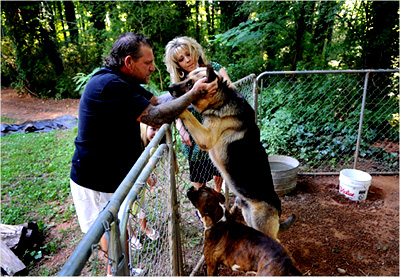 Roger
and Tammy West lost their house in Jasper, Ga., to
foreclosure and moved to a rental property. They say
they cannot afford to keep two of their three dogs. Roger
and Tammy West lost their house in Jasper, Ga., to
foreclosure and moved to a rental property. They say
they cannot afford to keep two of their three dogs.
Photo:
Erik
S. Lesser for The New York Times
|
“Please
Help!” begged a post from a pet owner in Carroll
County, Ga., who said she had two dogs that would be
homeless when her mother’s home was foreclosed
on in a few weeks. “Our shelter has something
like an 80 percent kill rate,” the post said.
“I have exhausted every effort I know to find
them a good home. No one wants a pregnant dog.”
As mounting layoffs and foreclosures have caused many
middle-class Americans to lose their economic footing,
some are parting with their pets, a trend that has sent
a tide of displaced dogs and cats to rescue groups and
county animal shelters around the country, officials
said. |
“One
lady was crying to me today and said: ‘I’ve either
got to feed my kid or feed my dog. What would you do?’ ”
said Shari Johannes, owner
of Dog Pack Rescue, a
“no kill” shelter in Kingston, Ga., that keeps
animals until they are adopted.
Like most such no-kill rescue groups in areas where foreclosures
are high, Ms. Johannes, who is keeping 180 dogs on five acres,
is over capacity. She will not accept any more animals, though
people beg her daily to take their pets.
When no-kill rescue groups turn pets away, the last option
for owners is usually a county animal shelter, which will
typically euthanize animals when space runs out.
In Georgia, which ranked sixth in the nation in foreclosures
in May, directors of county animal shelters reported that
the number of pets surrendered by their owners spiked in the
first part of the year.
The number of pets left at Henry County Animal Care and Control
in McDonough, Ga., was up 71 percent for the first four months
of 2008 compared with the same period in 2007, said Gerri
Dueringer, the shelter’s director.
In Clayton County, 22 percent more pets were surrendered in
the first part of the year compared with 2007, said Mark Thompson,
a police captain and director of the animal shelter in Jonesboro,
Ga.
Other areas of the country hit hard by foreclosures are seeing
similar increases, said Wayne Pacelle, president and chief
executive of the Humane Society of the United States.
“In terms of relinquishment, I’d say this is the
most serious circumstance that I can recall,” Mr. Pacelle
said. And as more pets are being turned in, he noted, cash
donations to animal rescue groups have declined and fewer
people are adopting pets.
“It’s a bit of a triple whammy,” he said.
The Humane Society recently started a foreclosure fund, which
offers grants of $500 to $2,000 to help nonprofit animal rescue
groups weather the crisis. Since late March, when the fund
was announced, 133 groups have applied for aid and 11 have
been given grants.
“Obviously, it’s a crisis for local shelters;
I worry about what it means for our society,” said Betsy
Saul, a founder of Petfinder.com, a Web site that showcases
animals for adoption at 11,000 sites in the United States.
Ms. Saul recently polled her member organizations to gauge
the problem and found that half of her respondents had seen
pets turned in because of home foreclosures in the last six
months.
After months without construction work, Roger West of Jasper,
Ga., began to miss mortgage payments. In May, he and his wife,
Tammy, and their 6-year-old daughter, Macy, became the third
family on their street to lose their home to foreclosure.
“The way things have fell off, we’re just praying
our way through it,” Mr. West said.
Though they were able to move to a much smaller rental home,
they decided that they could not afford to keep two of their
three dogs, a German shepherd and a boxer.
“It’s like losing a member of the family,”
said Tammy West, who is trying to find the dogs a home on
the Web site Craigslist. “They’re not bad or mean
or anything. They are just dogs that are going through a bad
situation like we are.”
The Wests, who said they had $11 in the bank after they paid
their bills recently, were able to persuade their new landlord
to give them some time to find new homes for the dogs, but
they know that other pet owners, and their pets, have not
been so lucky.
Tracy Thompson, facility manager of the Paulding County animal
shelter in Dallas, Ga., said: “We are a fast-growing
county, or we were. And it kind of came to a screeching halt.
We have a lot of empty construction and vacant homes around
here.”
Ms. Thompson said the flood of new animals because of foreclosures
had already led to an increase in euthanizations at her facility.
“Last month, we euthanized 151 animals for space,”
she said. “In June, we’re already up past that.”
“We see people who are at the end of their rope,”
Ms. Thompson said. “We’ve had some bring their
animals in who are living in their cars, and we’re all
in tears then.”
Ms. Dueringer, the Henry County shelter director, said: “You
pick up the young, adult, healthy dog and its only crime is
that it’s alive. And you have to put it to sleep. It’s
torturous to staff. It’s heartbreaking.”
Original
http://www.nytimes.com/2008/06/26/us/26pets.html?_r=1&oref=slogin
|

Lukas
I. Alpert, Wire Services
June 18,
2008
A man and
his Dog miraculously survived a fall off a 200-foot cliffin
Southern England while in a car.
When rescuers
got to the car, the Dog, named Zim Zam, was gone. He turned
up two days later at home -- hiding under the kitchen table. |

Beaten-down
dog from Vick case has his day
Pit bull
rescued from famous dogfighting ring now helps cancer patients
Marianne
Favro, KNTV
June. 17,
2008
MOUNTAIN
VIEW, Calif. - It’s a Dog’s life. And for Leo
it couldn’t be better.
 Leo
— rescued from heavy chains that confined him as one
of the pit bulls in former NFL quarterback Michael Vick’s
dogfighting ring — is a lover, not a fighter. He now
happily frolics in a clown collar as he makes the rounds at
the Camino Infusion Center, where he brings comfort to cancer
patients undergoing chemotherapy. Leo
— rescued from heavy chains that confined him as one
of the pit bulls in former NFL quarterback Michael Vick’s
dogfighting ring — is a lover, not a fighter. He now
happily frolics in a clown collar as he makes the rounds at
the Camino Infusion Center, where he brings comfort to cancer
patients undergoing chemotherapy.
Despite his training as a killer, Leo is a sweetheart as he
visits his friends on the ward.
“He is wonderful, and all the patients love Leo,”
said Paula Reed, the facility’s oncology director. “They
really love his eyes and gentleness.”
Six months ago, Leo should have been dead.
When officers raided Vick’s Bad Newz Kennels in Smithfield,
Va., last year, they found dogs, some injured and scarred,
chained to buried car axles. Forensic experts discovered remains
of dogs that had been shot with a .22-caliber pistol, electrocuted,
drowned, hanged or slammed to the ground for lacking a desire
to fight.
Vick, an All-Pro quarterback for the Atlanta Falcons, was
suspended indefinitely and is serving 23 months in federal
prison after pleading guilty in August to bankrolling the
dogfighting operation and helping to kill as many as eight
dogs. Three co-defendants also pleaded guilty and were sentenced
to prison.
About 50 dogs were rescued.
Animal advocates are divided over whether fighting dogs can
be trusted to have new lives as pets or working dogs. One
of the dogs seized at Bad Newz was put down as too aggressive,
but the others were dispersed to sanctuaries and training
facilities across the country.
An ‘incredible’ difference
with patients
One of them was Leo, who ended up in the care of Marthina
McClay, a certified trainer and counselor in Los Gatos, near
San Francisco. McClay is president of Our Pack, an advocacy
group for pit bulls.
“He was a little like a caveman at a tea party,”
McClay said. “He didn’t have a lot of training.”
But after five weeks of intense instruction and supervision,
and more weeks of acclimation, Leo is now — with all
due respect —a pussy cat. He loves putting his head
on a patient’s lap and batting his big brown eyes.
“The difference that he’s had with our patients
has been incredible — the smiles on their faces, the
joy when they see him,” said Reed of the cancer center.
“Leo is a survivor and our patients are survivors, and
I think they can relate to each other,” she said.
Original
story and video http://www.msnbc.msn.com/id/25214356/from/ET/
|

Bill
Passes Raising Pooper Scooper Fines
Posted: Thursday,
05 June 2008
ALBANY, N.Y. (AP) -- The Legislature has given final
passage to a bill that would charge $250, more than double the
current fine, for pet owners who don't pick up after their dogs
in some parts of New York state.
Dog owners currently have to pay $100 if they don't pick up the
poop. The change would apply to the five boroughs of New York
City, Albany and Yonkers.
The Assembly passed the bill Wednesday and the Senate had already
passed it. A spokesman for Gov. David Paterson says the governor
will review the measure. |

Editorial Notebook
The Cost
of Smarts
By
VERLYN KLINKENBORG
Published:
May 7, 2008
Research on animal intelligence always makes me wonder just
how smart humans are. Consider the fruit-fly experiments described
in Carl Zimmer’s piece in the Science Times on Tuesday.
Fruit flies who were taught to be smarter than the average fruit
fly tended to live shorter lives. This suggests that dimmer
bulbs burn longer, that there is an advantage in not being too
terrifically bright.
Intelligence, it turns out, is a high-priced option. It takes
more upkeep, burns more fuel and is slow off the starting
line because it depends on learning — a gradual process
— instead of instinct. Plenty of other species are able
to learn, and one of the things they’ve apparently learned
is when to stop.
Is there an adaptive value to limited intelligence? That’s
the question behind this new research. I like it. Instead
of casting a wistful glance backward at all the species we’ve
left in the dust I.Q.-wise, it implicitly asks what the real
costs of our own intelligence might be. This is on the mind
of every animal I’ve ever met.
Every chicken that looks at you sideways — which is
how they all look at you — is really saying what Thoreau
said less succinctly: you are endeavoring to solve the problem
of a livelihood by a formula more complicated than the problem
itself. Thoreau himself would not dispute that he was hoping
to recover the chicken’s point of view. He went to Walden
Pond “to remember well his ignorance.”
Research on animal intelligence also makes me wonder what
experiments animals would perform on humans if they had the
chance. Every cat with an owner, for instance, is running
a small-scale study in operant conditioning. I believe that
if animals ran the labs, they would test us to determine the
limits of our patience, our faithfulness, our memory for terrain.
They would try to decide what intelligence in humans is really
for, not merely how much of it there is. Above all, they would
hope to study a fundamental question: Are humans actually
aware of the world they live in? So far the results are inconclusive.
http://www.nytimes.com/2008/05/07/opinion/07wed4.html?_r=1&ref=opinion&oref=slogin
Related:
Lots
of Animals Learn, but Smarter Isn’t Better (May 6, 2008)
|

Cops:
Dogs Removed from Suspected L.I. Puppy Mill
Posted: Wednesday, 07 May 2008
EAST NORTHPORT,
N.Y. (AP) -- Dozens of dogs have been removed by
police and firefighters from a suspected puppy mill on Long
Island.
Authorities say most of the dogs were filthy, scared and living
in a house in East Northport that was filled with foul air.
The
Suffolk County Society for the Prevention of Cruelty to Animals
says a woman faces misdemeanor animal cruelty charges.
The organization says 56 dogs were removed from the house.
Most were shih tzus and poodles.
Puppy mills often exist to produce purebred puppies in large
numbers. Many organizations working to combat animal cruelty
say they put animals in deplorable conditions.
|

Researchers Seek to Demystify the Metabolic Magic of Sled Dogs
By
DOUGLAS ROBSON
Published:
May 6, 2008
When humans engage in highly strenuous exercise day after day,
they start to metabolize the body’s reserves, depleting
glycogen and fat stores. When cells run out of energy, a result
is fatigue, and exercise grinds to a halt until those sources
are replenished.
Dogs are different, in particular the sled dogs that run the
annual Iditarod Trail Sled Dog Race in Alaska. This is a grueling
1,100-mile race, and studies show that the dogs somehow change
their metabolism during the race.
Dr. Michael S. Davis, an associate professor of veterinary physiology
at Oklahoma State University and an animal exercise researcher,
said: “Before the race, the dogs’ metabolic makeup
is similar to humans. Then suddenly they throw a switch —
we don’t know what it is yet — that reverses all
of that. In a 24-hour period, they go back to the same type
of metabolic baseline you see in resting subjects. But it’s
while they are running 100 miles a day.”
Dr. Davis, who studied the sled dogs, found they did not chew
up their reserves and avoided the worst aspects of fatigue.
He is pursuing the research for the Defense Advanced Research
Projects Agency, which gave him a $1.4 million grant in 2003
to study the physiology of fatigue resistance of sled dogs.
Dr. Davis, who is teaming with researchers at Texas A&M
in a $300,000 Darpa grant, awarded last fall, has been traveling
to Alaska for years to learn why the sled dogs are “fatigue-proof.”
“They have a hidden strategy that they can turn on,”
he said. “We are confident that humans have the capacity
for that strategy. We have to figure out how dogs are turning
it on to turn it on in humans.”
Researchers have not demonstrated that ability in other species,
but Dr. Davis said migratory mammals or birds could have it.
Nor is it similar to the mammalian diving reflex that lets aquatic
mammals like seals, otters and dolphins stay under water for
long periods of time by slowing metabolic rates.
“The level of metabolism is staying the same,” Dr.
Davis said. “It’s not slowing down their calorie
burn rate.”
In fact, sled dogs in long-distance racing typically burn 240
calories a pound per day for one to two weeks nonstop. The average
Tour de France cyclist burns 100 calories a pound of weight
daily, researchers say.
How the dogs maintain such a high level of caloric burn for
an extended period without tapping into their reserves of fat
and glycogen (and thus grinding to a halt like the rest of us)
is what makes them “magical,” Davis says.
|
A
SMALL DIGRESSION: FROM CANINE TO EQUINE

Editorial
Another
Horse-Racing Horror
Published:
May 6, 2008
There is no reason why a race of one-and-a-quarter miles should
be a death sentence for a horse, as it was on Saturday for the
3-year-old filly, Eight Belles. She was euthanized after breaking
both front ankles immediately after coming in second in the
Kentucky Derby.
The racing industry has claimed, as it always does after such
a horrifying incident, that racing young thoroughbreds isn’t
all that dangerous to their well-being. But the nature of racing
and breeding has changed over the years. Good horses, whose
careers often begin and end before their bones are fully mature,
are racing less often than they used to, which means they only
need enough endurance to last a few races. That makes it all
the easier to breed for the lightness of build — and the
fragility — that Eight Belles showed.
There are, of course, owners and trainers who love thoroughbreds
for themselves and for their ability to perform on the racetrack,
which is a reasonable test of sound breeding. But the real race
increasingly seems to be to capitalize on a horse’s success
— to move a horse through its career as quickly as possible.
The sums involved are immense, so much so that the horses seem
more like financial vehicles than animals with an existence
of their own. The life of the money comes to seem just as important
as the life of the horse.
How beautiful a galloping thoroughbred can be — everyone
who watched the Derby can attest. But we also got to witness
just how narrow the margin is between beauty and tragedy. It
is exactly as narrow — and only as sure — as the
bones in a horse’s legs. The first rule of racing must
be the welfare of these horses. Nothing else is acceptable.
|

May 2, 2008
ASPCA RESPONDS TO OUTCRY OVER “STARVING DOG” EXHIBIT
Late last week the ASPCA issued a press release in response
to the tremendous outpouring of public concern over a 2007 art
exhibition by Costa Rican artist Guillermo Habacuc Vargas that
featured an emaciated dog. Because reports on the duration of
the exhibit and the condition and fate of the dog vary widely—including
those issued from the Nicaraguan gallery involved and Vargas
himself—it is impossible at this time to know conclusively
what happened, or if the images and stories flooding the Internet
are real. However, the ASPCA understands and shares the outrage
felt by animal lovers over this alleged act of cruelty that,
if true, sadly is not a criminal act in Nicaragua.
“The ASPCA is opposed to cruelty to animals of all types,
in all societies,” says ASPCA President Ed Sayres. “However,
it is also not the policy of the ASPCA to condemn entire communities
or countries for the cruel acts of individuals. What we need
to do is step up our efforts to educate the public on the humane
treatment of animals so that such events do not occur again.”
Online activity regarding this incident has increased steadily
over the last several weeks after many websites have reported
that Vargas is planning to participate in the VI Central American
Visual Arts Biennale later this year in Honduras.
While the ASPCA’s programs are limited to the United States,
we are a member and supporter of the World Society for the Protection
of Animals (WSPA). WSPA and member society the Honduras Association
for the Protection of Animals and their Environment (AHPRA)
have persuaded organizers of the Honduras Biennale to make AHPRA
official exhibition observers. Additionally, although Vargas
has stated that his exhibit will not feature a dog, the Biennale
has agreed to codify rules prohibiting animal abuse. WSPA has
also indicated to the ASPCA that it will increase efforts to
enact stronger animal protection laws in Nicaragua.
The ASPCA asks supporters to advocate on behalf of animals through
their own actions by supporting international, national and
local animal welfare organizations, and by educating their own
communities about how to detect and combat animal cruelty. To
add your voice to the chorus of those working for the humane
treatment of animals, please visit www.fightcruelty.org
to take the ASPCA’s Pledge to Fight Animal Cruelty.
http://www.aspca.org/site/PageServer?pagename=media_tristatenewsalert050208 |
|

Montana
Dog Owners Find Wild-Animal Traps Put Pets in Harm’s Way
By
JIM ROBBINS
Published:
April 30, 2008
MISSOULA, Mont. — The first order of business when freeing
a dog caught in a trap, Anja Heister said, is to put a stick
in its mouth. “No matter how much it loves you, it may
try to bite,” Ms. Heister explained to a group gathered
at a coffee shop here last week.
The demonstration was one of several across Montana being conducted
by Footloose Montana, a nonprofit organization led by Ms. Heister.
The group is teaching people how to free pets inadvertently
caught in traps set legally for wild fur-bearing animals.
Full
Article: http://www.nytimes.com/2008/04/30/us/30traps.html?_r=1&scp=3&sq=Jim+Robbins&st=nyt&oref=slogin
|

|

PETA’s Latest Tactic: $1 Million for Fake Meat
By
JOHN SCHWARTZ
Published:
April 21, 2008
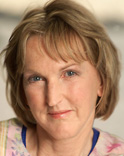 Ingrid
Newkirk, PETA
Ingrid
Newkirk, PETA |
People
for the Ethical Treatment of Animals wants to
pay a million dollars for fake meat — even if it
has caused a “near civil war” within the organization.
The organization said it would announce plans on Monday
for a $1 million prize to the “first person to come
up with a method to produce commercially viable quantities
of in vitro meat at competitive prices by 2012.”
The
idea of getting the next Chicken McNugget out of a test
tube is not new. For several years, scientists have worked
to develop technologies to grow tissue cultures that could
be consumed like meat without the expense of land or feed
and the disease |
potential
of real meat. An international symposium on the topic was held
this month in Norway. The tissue, once grown, could be shaped
and given texture with the kinds of additives and structural agents
that are now used to give products like soy burgers a more meaty
texture.
New
Harvest, a nonprofit organization formed to promote the
field, says on its Web site, “Because meat substitutes are
produced under controlled conditions impossible to maintain in
traditional animal farms, they can be safer, more nutritious,
less polluting and more humane than conventional meat.”
Jason Matheny, a doctoral student
at Johns Hopkins University who formed New Harvest, said the idea
of a prize for researchers was promising. Citing the example of
the Ansari X Prize, a competition that produced the first privately
financed human spacecraft, Mr. Matheny said, “they inspire
more dollars spent on a research problem than the prize represents.”
A founder of PETA, Ingrid Newkirk,
said she had been hoping to get the organization involved in advancing
in vitro meat technology for at least a decade.
Full
article -- http://www.nytimes.com/2008/04/21/us/21meat.html?_r=1&ref=us&oref=slogin |

Posted:
Tuesday, 15 April 2008
Seeing
Eye Dog Retires After 63 (Dog) Years of Service
NEW YORK
-- After 63 long years of hard work - - dog years, that is
- - Ruger the seeing eye dog is calling it a career.
Kevin Coughlin, 46, of Manhattan, who is blind, has to
give up his beloved guide dog, Ruger on Friday because of
the yellow lab’s advanced age. For nine years Ruger
has helped Coughlin navigate the jam-packed sidewalks of the
city, saving him from cars, cabs and construction sites.
|
|
Ruger |
Kevin
Coughlin and Ruger |
Coughlin
told 1010 WINS he realized Ruger had found the right home
one day when 42nd Street was even more crowded than usual,
“Ruger went to the left and he went to the right.
He couldn’t go around people so he was stomping his
feet in place like he was an impatient New Yorker."
The bond between this man and this dog grew even stronger
a few years ago when Ruger had cancer surgery. Coughlin
nursed his dog back to health. “I felt like I
was finally able to give back a little to him,” said
Coughlin. As Friday, the day of departure, nears, Coughlin
spoke lovingly of the animal he calls, “my colleague
and my pal,” saying he will miss him immensely. “I
am so blessed to have had him in my life."
Ruger
will be retiring with an adoptive in Warcick NY
But before he goes, the helpful pooch is being honored
for all those years of service, on Thursday at Manhattan's
St. Agnes Church from 5-7 p.m. Folks at the church say they
plan on thanking Ruger by giving him a sterilized bone and
some of Mother Hubbard's mini-treats.
Word is, he's most excited about the mini-treats.
|

In
the West, a Fierce Battle Over Wolves
By
KIRK JOHNSON
Published: April 13, 2008
DENVER — Gray wolves have entered the spin cycle.
Since March 28,
when the wolf was taken off the list of federally protected
species in Idaho, Montana and Wyoming, a fierce battle of perceptions
and posturing has unfolded on the Web and in the news media
as pro-wolf and anti-wolf forces stake out sometimes hyperbolic
positions concerning where in the West animals and humans should
exist.
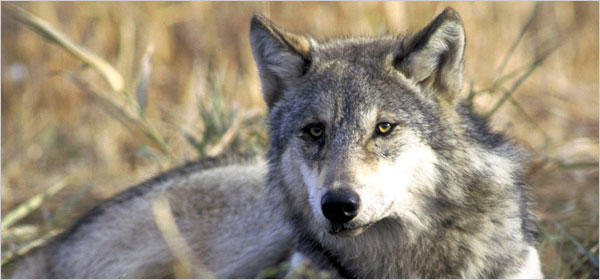 United States
Fish and Wildlife Service, via Associated Press
United States
Fish and Wildlife Service, via Associated Press |
The backdrop is
a running time clock and a lawsuit. On April 28, a coalition
of environmental groups has said it will to go federal court
challenging the decision to lift protections.
Until then, the court of public opinion is in session, as cases
are built for how the new system of state management is working
or not.
FULL
ARTICLE: http://www.nytimes.com/2008/04/13/us/13wolves.html?_r=1&ref=us&oref=slogin
RELATED
Dot
Earth: Howling Over Federal Plan to Expand Wolf Killing
|

April 12,
2008
Is
it safe?
Now the evidence is in: If a community is humane,
then yes, it’s safe. And if it harbors cruelty to animals,
it’s not safe for people, either.
In a recent prison survey in Chicago, 7 out of 10 people convicted
of violent crime said they’d begun with animals. And
dog-fighting is right up at the top.
That’s why Best Friends is working
in a model program with Safe Humane Chicago
to reach people, especially young people, before they’re
drawn into the vortex of violence.
This week, we visit a high school where young people have
signed on to learn more about animals – and about how
kindness to animals builds a better world for all of us.
For
More:
http://news.bestfriends.org/index.cfm?page=news&mode=entry&entry=35CB2EF5-19B9-B9D5-9DBE8E9F036895DA
Groundbreaking work with
the VICKtory dogs.
|
Emotional
healing 
Halle
was terrified of people
when she came to Best Friends last December.
The change has been amazing. This week, read about how
she and the others are coming out of their shells.
When
Halle first came to Best Friends
in early January, she was absolutely terrified of people.
That’s understandable, considering that she was
one of the dogs rescued from Michael Vick’s
dog fighting ring.
Halle and 21 other “Vicktory”
dogs have been at the sanctuary for almost
three months now, and their progress has been nothing
short of amazing.
|
|
|

EDITORIAL
When Protection Vanishes
Published:
April 5, 2008
At midnight on March 28, the gray wolves in Wyoming slipped
out of the protection of the Endangered Species Act and became
other kinds of creatures: trophy game animals to be hunted
in the state’s northwest corner and predators to be
shot on sight elsewhere.

The nature of the wolf didn’t change,
only the restraints imposed on humans. In the next three days,
three wolves were killed, two by hunters and one by a rancher,
all in the predator zone where the only restriction is the
obligation to report a kill within 10 days. Environmental
groups plan to sue to reverse the lifting of these protections,
but they are barred from doing so for 30 days — plenty
of time for more wolves to die.
It is tempting to adduce an ancestral hostility between man
and wolf. But this is a problem in economics. Wolves kill
a small number of livestock, and compensating ranchers’
losses is a price worth paying. What this is really about
is a competition between two top predators — man and
wolf — for elk. Elk-hunting generates revenue, and wolves
cannot pay for the elk they take.
Gray wolves in the Rocky Mountains were eradicated in the
early 20th century, so it is easy to think of them as a special
case. They were reintroduced by humans — a legally mandated
intervention — and they will be killed by humans because
of another legal intervention. Their survival is wholly a
matter of our intent. And yet you might say the same thing
about every other species, every other ecosystem on this planet.
The more we think about it, the more we believe the only nature
that matters anymore is human nature. This is not a happy
thought. The answer to every important environmental question
ultimately depends on human self-restraint. The simple ethical
fact seems to be that humans cannot restrain themselves, not
without laws and incentives that are only as solid as our
weakest intentions. The laws change, and overnight all that
good work is threatened by gun smoke.
http://www.nytimes.com/2008/04/05/opinion/05sat3.html?_r=1&ref=opinion&oref=slogin
|

TENANT
WINS VS. BEASTLY LANDLORD
It's claws
for celebration
By ALEX GINSBERG
Publised:
April 3, 2008
A Manhattan woman
who keeps three dogs and five birds in her Upper West Side apartment
won a battle yesterday against her landlords, who said her barnyard-like
home was creating a nuisance.
"We won," chirped Jacqueline Bartone, 71, who has
lived in the apartment for more than four decades. "I can
now sleep soundly and not have any anxiety."
Manhattan Housing Court Judge Peter Wendt ruled in favor of
Bartone and husband, Charles O'Hara, 60, after taking the unusual
step of visiting the apartment himself.
"[It is] not even approaching a nuisance in any regard,"
he said, according to Bartone's lawyer, Adam Leitman Bailey.
http://www.nypost.com/seven/04032008/news/regionalnews/tenant_wins_vs__beastly_landlord_104802.htm
|

Before
Greeting NATO, Romanians Confront Canines
By NICHOLAS KULISH
Published:
April 2, 2008
BUCHAREST, Romania — President Bush’s security
detail has a different breed of assailant to guard against while
he attends the meeting of NATO leaders here: the city’s
infamous stray dogs.
 Petrut
Calinescu
Petrut
Calinescu |
Dogcatchers
on the job in Bucharest last year. A law passed early this
year prohibits the city
from euthanizing strays. |
Special squads of dogcatchers are already stationed along the
road from the airport to the Palace of the Parliament, where
the meeting will be held this week, to prevent the beasts from
harassing delegates on foot or nipping at the wheels of their
motorcades. Meanwhile, the rest of the city remains under a
worsening canine occupation.
The city government reports that 9,000 people are bitten each
year here by dogs, though those numbers include bites by strays
and pets. Officials will not venture a guess at the number of
strays, and estimates of the semi-feral population in the local
news media range from 30,000 to 200,000 dogs.
But everyone agrees that the problem has been growing recently,
thanks to a January law that prohibits the city from euthanizing
the dogs. Also unable to spay or neuter the dogs and return
them to the street, city officials are facing severe overcrowding
at the pound and a paralysis of policing.
“Because the shelters are full, we cannot capture the
dogs,” Simona Panaitescu, director of the city’s
administration for animal supervision, said of the canine Catch-22.
“We are stuck in the middle.” The city used to nab
1,500 dogs each month, according to Ms. Panaitescu, of which
80 percent were put down and 20 percent adopted.
The local debate flared up earlier this year when two women
were mauled by stray dogs in separate attacks. A Japanese businessman
was killed in January 2006 when he was bitten in the femoral
artery.
The stray dogs of Romania are one of the longest running stories
in Eastern Europe. Their population first exploded when the
Communist dictator Nicolae Ceausescu demolished thousands of
houses to make way for an ill-considered reconstruction plan.
Residents forced to move into tiny apartments had no room for
their dogs, which they then put out on the street.
Throughout Romania, dogs can be seen trotting along the sides
of roads and peering from perches on trash bins. At night, their
baying and barking provides a constant backdrop, like the honking
of car horns in big cities.
Like the country’s most famous biter, Dracula, the dogs
have captured the imaginations of locals as well as foreigners.
One intrepid dog made headlines last year when he found his
way onto the track during an auto race — and survived.
Ioana Pirvulescu, a representative of the animal-welfare group
Four Paws in Bucharest, said she hoped that a new law permitting
authorities to parole spayed and neutered dogs could pass as
soon as next week, after the NATO meeting ends.
“Most of the dogs are peaceful and quiet dogs,”
she said. “Living on the street is not easy. In a few
years, they will disappear.”
Original
- http://www.nytimes.com/2008/04/02/world/europe/02dogs.html?_r=1&scp=2&sq=Nicholas+Kulish&st=nyt&oref=slogin
|
"We
have to convince the people of Bucharest, who are dog
lovers, to treat their dogs like they treat their children
and not just let them roam the streets."

|
|
|

Posted:
Friday, 28 March 2008
Giants
LB Antonio Pierce Pleads Guilty to Animal Neglect
|
MONROE
TOWNSHIP, N.J. (AP) -- A member of the Super
Bowl champion New York Giants has pleaded guilty to neglecting
his pet pit bulls.
Middle linebacker Antonio Pierce appeared
in municipal court in Monroe Township on Thursday and
agreed to pay a $1,300 fine.
Authorities
say one of the dogs was severely underweight and suffering
from a respiratory illness. They also say Pierce and his
girlfriend let the dogs run loose and failed to get them
rabies shots. |
|
Jocelyn
Maldanado also pleaded guilty and was fined $1,300.
A lawyer for the couple says the dogs were given away as part
of the plea agreement.
The dogs were discovered running around a neighbor's yard in
late January, the week before the Giants upset New England to
win the Super Bowl.
http://www.1010wins.com/Giants-LB-Pierce-Pleads-Guilty-to-Animal-Neglect/1906304
More
- http://www.pet-abuse.com/profiles/13631/
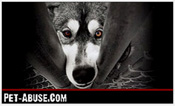
|
| 
A Bid to Lure Wolves With a Digital Call of the Wild
By
KIRK JOHNSON
Published:
March 19, 2008
BOZEMAN, Mont. — The long, lonely howl of a wolf shatters
the early morning stillness. But is it real? Beginning this June,
it might be hard to tell, even for the wolves.

J.
Husseman/Idaho Fish and Game
A
G.P.S. collared black wolf in Idaho in July 2007.
|
One
of the most famous sounds in nature is going digital. Under
a research project at the University of Montana in Missoula,
scientists are betting that the famous call-and-response
among wolves can be used to count and keep track of the
animals.
Tricked by technology, scientists say, wolves will answer
what amounts to a roll call triggered by a remotely placed
speaker-recorder system called Howlbox. Howlbox howls, and
the wolves howl back. Spectrogram technology then allows
analysis that the human ear could never achieve —
how many wolves have responded, and which wolves they are.
“With
audio software, we’ll be able to identify each wolf
on a different frequency, so we can |
count wolves
individually, kind of like a fingerprint,” said David Ausband,
a research associate at the University of Montana Cooperative
Wildlife Research Unit, where Howlbox was developed.
“With audio software, we’ll be able to identify each
wolf on a different frequency, so we can count wolves individually,
kind of like a fingerprint,” said David Ausband, a research
associate at the University of Montana Cooperative Wildlife Research
Unit, where Howlbox was developed.
The devices, using off-the-shelf technology,
cost about $1,300, including $300 for a solar panel. Audio recordings
in the wild are nothing new, of course. Bird and amphibian researchers,
in particular, have long used recordings to find or flush out
critters. Howlbox’s innovations are the tools of digital
analysis and programmed instructions that tell Howlbox when to
howl, when to sleep because the wolves are sleeping, and how to
store each day’s file on a disk.
The experiment will begin with a pilot project in which four Howlboxes
will be placed in remote areas of Idaho in June. That month was
chosen because it is when the packs gather with their spring-born
pups in what is called a rendezvous.
Wolf pups will howl at almost anything, scientists say. But a
test here in Montana in January also showed that adult wolves
can also be fooled by a good sound system.
Money is a driving force behind the research, much of which is
being paid for by the Nez Perce Indian tribe in Idaho, which has
deep cultural links to the western gray wolf.
Traditional tracking tools like radio collars and aerial surveillance
were used extensively after wolves were reintroduced into Yellowstone
National Park in the mid-1990s under the Federal Endangered Species
Act. But federal protections will end later this month, and so
too will the deep pockets needed for flyovers and catching and
collaring.
A spokesman for the Nez Perce tribe, Curt Mack, said Howlbox might
be a cost-efficient answer.
“We’re at a transition moment from wolf recovery to
long-term management,” said Mr. Mack, the tribe’s
gray wolf recovery coordinator. “We need new tools.”
Another issue for Howlbox is the human response. To the uninitiated,
a Howlbox-enhanced forest could sound as if wolves were everywhere
— a scary proposition. Montana wildlife officials are braced
for a public relations campaign if the project moves forward.
“That is something we would not do without touching base
with local folks,” said Carolyn Sime, the wolf program coordinator
at the Montana Department of Fish, Wildlife and Parks “They
need to know that just because you hear the sound, it doesn’t
necessarily mean that wild wolves are howling at their back door.”
|
A
prototype of a Howlbox, technology being developed to elicit
and identify howls from wolves. |
Original
+ Multimedia: Wolves Responding to Howlbox in Bitterroot Mountains
http://www.nytimes.com/2008/03/19/science/earth/19howl.html?ref=us
|
TOP
STORY- FOLLOWUP

PUERTO RICO FACES SUIT OVER ROUNDUP OF DOGS
|
|
|
John
Hower, 10, with Buster in Barceloneta. He refused to surrender
Buster when animal control workers tried to take him.
|
Stray
dogs in Barceloneta, P.R. Animal rights advocates say
such animals are often rounded up and disposed of inhumanely.
Photos:
Damon Winter/The New York Times
|
Wilma
Gonzalez, 18, waits to have her dog, Pucha, inoculated
at a Humane Society of Puerto Rico clinic near San Juan.
|
Scrutiny
for Puerto Rico Over Animal Treatment
By
KIRK SEMPLE
Published:
March 9, 2008
BARCELONETA, P.R. — This much seems certain about the
events of last October at three housing projects in this town
near Puerto Rico’s northern coast: Men working for the
municipality entered the projects, rounded up dozens of dogs
and cats that they said violated the housing authority’s
no-pets policy and took them away.
What happened next is less clear, but a lawsuit filed on behalf
of 33 families claims that city employees and contractors drugged
and brutalized dozens of animals and then flung them from a
50-foot-tall highway bridge into a weed-choked ravine and left
them to die.
Witnesses say they found a pile of dog corpses and skeletons
beneath the bridge, but the contractors have denied wrongdoing
and city officials have denied responsibility.
News of the event became an international embarrassment for
Puerto Rico and something of a vindication for animal rights
advocates here and on the United States mainland who had long
tried to draw attention to the plight of animals on the island.
Animal rights advocates contend that the inhumane disposal of
animals was routine, with unwanted dogs, cats and even farm
animals hurled from bridges, intentionally crushed by vehicles
or butchered with machetes. Government nonchalance, they say,
has allowed this to go on.
But only with the Barceloneta case, they say, did anything start
to happen. It spurred threats of a tourism boycott, inspired
the government to begin addressing more forcefully the issue
of animal welfare and precipitated soul-searching among the
Puerto Rican people.
“In our culture we have not addressed these issues because,
probably, we did not think they were important,” said
Carlos M. Carazo, director of the animal disease division of
Puerto Rico’s State Office for Animal Control, in an interview
in San Juan last month. “In Puerto Rico, we have so many
issues to address, we haven’t had the leisure time to
think about animals. But this is probably the time to start
thinking about it.”
Puerto Rico, among United States territories, has long had a
poor international reputation for the treatment of animals.
There is no government program for mass sterilization or registration
of pets and little animal welfare education in the schools.
The island has only about a half-dozen animal shelters, and
while municipalities are charged with rounding up strays, that
duty has largely been ignored, government officials and animal
advocates say.
Puerto Rican pet owners will often dump unwanted animals along
roads or on beaches, animal advocates say. Roaming packs of
mangy dogs are common in many towns.
One of the most notorious dumping grounds is a spit of land
on the southeastern coast near the town of Yabucoa. It is known
as Dead Dog Beach. According to animal welfare advocates, thousands
of dogs have wound up there in the last decade.
“I’ve found dogs poisoned in the bushes,”
said Sandra Cintron, 37, an animal rescuer who lives in Yabucoa
and drives to the beach every morning with a sack of dry food
and jugs of fresh water for the shifting population of abandoned
animals. “Sometimes they put them in bags and toss them
in the jungle.”
Ms. Cintron, whose volunteer work is supported by several Puerto
Rican and international animal welfare groups, has been tending
to the stray dogs at Dead Dog Beach since 2001. She has taken
hundreds to be neutered and has found homes for dozens. She
has named them all and keeps photographs of them in albums.
Animal rights groups say that over the years they have been
inundated with letters and e-mail messages from tourists offended
by the stray dog problem.
One rights group in San Juan is the Save a Sato Foundation.
The group’s Web site explains that sato is slang for “street
dog.”
An e-mail message sent to the group by a woman who identified
herself as Susan, was typical: “I visited P.R. a few years
ago and was appalled and literally sickened by the homeless
dog situation. I spent my entire vacation feeding stray dogs.
The trip was miserable and horrible and I swore never to return
and to tell everyone I knew about the experience.”
A 2002 study by the Puerto Rico Hotel and Tourism Association
estimated that the stray animal problem was costing the commonwealth
about $5 million a year in lost tourism. “Numerous groups
and conventions have canceled plans to hold meetings in Puerto
Rico after observing the stray dog and cat situation,”
the report said.
Still, it was five years before the government acted.
“In Puerto Rico, nobody has taught our culture animal
control and protection concepts,” said Mr. Carazo of the
animal control office, which was formed last year. “We
are now beginning to address those issues.”
Since the Barceloneta case, the animal control office has accelerated
new regulations and guidelines for animal control specialists,
shelters and law enforcement agencies on how to manage strays,
adoptions, spay clinics and licensing. Completion of the guidelines
will result in the disbursement of $1.5 million in seed money
to establish animal shelters in each of the commonwealth’s
78 municipalities, said Wilma Rivera, executive director of
the office. The government has also created a program to educate
two police coordinators in every region, who will train the
rest of the police force in the proper handling of pet cruelty
cases.
The commonwealth’s tourism agency has also formed a committee
to push for more government action, complementing an animal
welfare committee that operates under the auspices of the hotel
and tourism board.
Meanwhile, a group of lawyers is drafting more comprehensive
animal protection legislation with stiffer penalties.
Still, animal welfare advocates are concerned that as the Barceloneta
case wanes, the government’s interest may flag. But Edilia
Vazquez, director of the Save a Sato Foundation, said the Barceloneta
case has unified the once-fractured animal welfare community.
“We realize we need to work with each other and keep the
finger in the side of the government,” Ms. Vazquez said.
Original
+ Multimedia and related stories @ http://www.nytimes.com/2008/03/09/us/09dogs.html?_r=1&ref=us&oref=slogin
|

Drug Raid in Yonkers Yields Dogfighting Evidence, 15 Pit Bulls
YONKERS,
N.Y. (AP)
Wednesday,
05 March 2008
 Anthony
Gonzalez, left, Peter Byrne, right Anthony
Gonzalez, left, Peter Byrne, right |
Two
scarred pit bulls were found dead Wednesday
in trash bags just as police announced the rescue of 15 other
dogs and the discovery of a dogfighting pit in a Yonkers basement.
Ken Ross, police chief for the Westchester County Society
for the Prevention of Cruelty to Animals, said it was not
clear if the dead dogs were connected to the Yonkers find. |
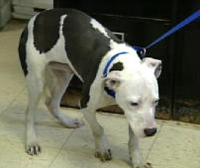 Photo
from WNBC.com
Photo
from WNBC.com |
"We just ripped open a couple of trash bags and found two pit
bulls,'' he said. ``One male, one female, decomposed.'' Yonkers
Police Commissioner Edward Hartnett said they were found in the
Riverdale area of the Bronx.
Wednesday's developments come two months after two crippled pit
bulls, bloodied from dogfighting, were found in a trash bin at a
Yonkers gas station. One of those dogs died. Despite the offer of
rewards, no arrests have been made in that case.
The discovery of the 15 pit bulls in Yonkers came during a Tuesday
night raid by narcotics police, said police spokeswoman Lt. Diane
Hessler. Besides 6 ounces of cocaine, drug packaging and nearly
$16,000 in cash, the police found a 3-foot-high Plexiglas fighting
enclosure, treadmills for dogs, chains, a whip and syringes used
on the dogs, officials said.
They also heard dogs in a garage, obtained a search warrant and
called in the SPCA, Ross said. He said the garage was filthy with
excrement, no food or water was available to the 15 dogs and some
were scarred and emaciated.
During the raid, two Yonkers men were arrested on drug possession
charges, Hessler said. Peter Byrne, 25, and Anthony Gonzalez, 24,
were to be arraigned later Wednesday.
Ross said the dogs found Tuesday would be seeing veterinarians Wednesday
and Thursday. He said the SPCA was determining whether the evidence
would support felony dogfighting charges or just misdemeanor cruelty
charges. The felony is punishable by up to four years in prison,
the misdemeanor by up to one year.
Over the past year, there have been several signs of dogfighting
in the urban areas of lower Westchester, just north of New York
City. Last summer, five Rottweilers and a pit bull were rescued
in Mount Vernon, not long after an injured pit bull was found lying
in its own blood in the street. Also in Mount Vernon, 63 kittens
were found in boxes on the doorstep of an animal shelter, likely
saved from use as dogfighting bait. In October, six scarred dogs
were found in a Yonkers garage.
Ross said Wednesday that publicity from the dogs found in January
and from the case of football pro Michael Vick, who was sent to
prison for training pit bulls for fighting, had helped raise awareness
of the crime. He said narcotics police have been trained to look
for signs of dogfighting during their drug investigations "because
the two often are linked.''
Photo
from WNBC.com |
| 
 GOOD
NEWS: GOOD
NEWS:
New “VICKTORIES” Every Day
7 March 2008
For the dogs rescued from ex-footballer Michael
Vick’s kennels, every day is a new experience. This
week, for example, was a breakthrough for Lance. At first, Lance
would literally run into the fence as he tried to hide from everyone.
But now he looks forward to his walks, plays with toys, and is
beginning to enjoy his life. Check out Lance’s story here
, and on the blog you can see Oliver taking off on a car ride.
It’s one step at a time, but what a pleasure to see the
dogs enjoying themselves.
|
Read
More:
http://news.bestfriends.org/index.cfm?page=news&mode=entry&entry=658BD797-19B9-B9D5-9D917AEADD34CD9E |

Uno, champion beagle, retires from competition
Uno,
the prize-winning beagle, will no longer compete, but he has
a busy upcoming schedule that may include a White House visit.
By Ben Walker, The Associated Press
NEW YORK — He was one of the greats in his sport, an underdog
from a small Southern town who became a most popular champion.
He thrilled fans by running around like a playful pup, until
there was nothing left to prove. This week, he bowed out. So
long, Uno the beagle.
Less than a month after winning best in show at the Westminster
Kennel Club, his team made it official: America's top dog has
retired.
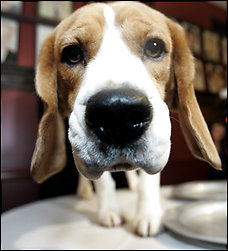 AP
Photo/Frank Franklin II
AP
Photo/Frank Franklin II
|
"If anyone could bark out signals like
Brett Favre, it's Uno," David Frei, host of the Westminster
television coverage, said Friday. "Like Brett, he did
it all."Someday, Uno will lead a pet's life and maybe
breed future champs. In the meantime, he'll be a pretty
hectic hound.
The White House wants him to visit the Oval Office next
month. The St. Louis Cardinals would like him to run out
a first ball. Oprah's people called, hoping to schedule
an appearance. He's set to ride a float in the Macy's Thanksgiving
Day parade.
The only beagle to win at Westminster, Uno turns 3 in May
and many dog fanciers hoped they'd see him baying inside
show rings for at least another year. This li'l Snoopy certainly
was on track to become the top winning beagle ever —
he owns 33 best in show ribbons, about a dozen short of
the record for his breed. |
Yet his four owners and handler Aaron Wilkerson decided it
was time to call it career, albeit earlier than most dogs retire.
There has not been a repeat champion at Westminster since an
English springer spaniel called DJ won in 1971-72. The last
to try, a wire fox terrier called Lacey, did not make it out
of the terrier group in 1993.
"There's nothing else to top," Wilkerson, who lives
with Uno in Lugoff, S.C., told The State newspaper of Columbia.
There was no thought, either, of taking him to England for the
world's largest dog show. The Crufts event started this week
with about 23,000 dogs — Westminster draws around 2,600.
"Let his legacy be running around the Garden with the crowd
giving a deafening roar," Frei said. "It was louder
than anything I've heard in 19 years of doing the show. Let
people remember Uno that way."
Uno's retirement was expected since the night he bayed up a
storm at Westminster. The sold-out crowd gave a standing ovation
when judge J. Donald Jones surveyed the seven finalists, made
his choice and announced, "Let me have the beagle."
The Westminster winner receives no prize money. The victory
is worth a silver bowl, and Uno promptly put his paws inside
the prize.
With personality-plus, Uno created quite a stir the rest of
the week in Manhattan. He made the rounds on the network TV
shows and rang the opening bell at the Nasdaq stock exchange.
A state representative in Illinois declared the month in his
honor. Governors in Texas and Missouri still want to pet Uno.
This week, Uno will be the featured guest at a dog event in
Hilton Head, S.C. Later, he'll make appearances in New York
and California. Eventually, he'll wind up in Texas with co-owner
Caroline Dowell.
While his show days are over, he isn't done showing off. "His
tail hasn't stopped wagging," Frei said.
http://www.usatoday.com/sports/2008-03-07-dogs-uno-retires_N.htm
More
- WASHINGTON POST: http://www.washingtonpost.com/wp-dyn/content/article/2008/03/07/AR2008030702792.html
|

Tradition or Fluff? A Dog Show Wrestles With Its Image
By
SARAH LYALL
Published: March 7, 2008
 Christopher
Furlong/Getty Images Christopher
Furlong/Getty Images |
BIRMINGHAM, England — Perhaps you believe
that a legitimate dog-show competition should not include
an event in which a middle-aged lady sashays moodily alongside
her dog to the Irene Cara anthem “What a Feeling”
while wearing a John McEnroe-style headband and pink leg
warmers.
Alessia Pierdomenico/Reuters
The Japanese spitz is among 183 breeds at Crufts this year.
The competition includes 39 dogs from the United States |
Well, tough, said Mike Richardson as he watched that very thing
— a kind of canine homage to the 1983 film “Flashdance”
— at the Crufts dog show on Thursday morning. “It’s
what people want to see,” he said. “They want to
see the excitement.”
Mr. Richardson, a 41-year-old window washer and dog performance
enthusiast, had unwittingly put his finger on the big debate
churning beneath the surface this year at Crufts, the world’s
largest and, arguably, most respected dog show. Last month,
Paul Keevil, then the press officer for the British & Irish
Dog Breeds Preservation Trust, shocked the British canine establishment
when he denounced the show, the high point on the dog calendar,
as “far too theatrical.”
Full
Article: http://www.nytimes.com/2008/03/07/world/europe/07dog.html?_r=1&scp=2&sq=sarah+Lyall&st=nyt&oref=slogin
|
| 
MAGAZINE
Consumed
Scaring
Up Demand
By
ROB WALKER
Published:
March 2, 2008
Organic pet food
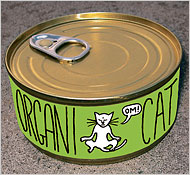
Peter
Arkle
|
Just about a year ago, tainted food killed more
than a dozen dogs and cats around the United States, and a
massive recall involved more than 100 varieties of edible
pet products from a range of big-selling brands. As the crisis
snowballed, there was a lot of talk about how the recall had
given a boost to the sellers of natural, organic or raw pet
foods, as panicked consumers sought safe alternatives. In
fact, such brands reported that sales had doubled or tripled
or better, while news accounts said that mainstream brands
were scrambling. A fundamental shift in mass-market consumer
behavior seemed to be under way. |
|

Metropolitan Diary
Published: February 25, 2008
DEAR
DIARY:

Photo
Nicole Bengieno
|
The
other morning I left my apartment with my 11-pound mutt’s
leash in one hand and several envelopes in the other.
Before we reached the corner, Miles did his thing. I whipped
out a plastic bag and, being a diligent citizen, did mine.
Now, as it so happens, the trash can is adjacent to the
mailbox and ...
The second I realized that I had “mailed”
my dog’s deposit instead of my credit card bills,
I just stood there, frozen in disbelief....
|
|

Two soldiers’ dogs will arrive safely in the US after
an emergency rescue from Iraq
WASHINGTON,
DC – Saturday, February 23, 2008
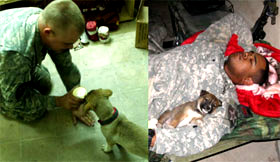 Liberty
and K-Pot, two puppies rescued off Iraqi streets by US troops
have survived sure death thanks to SPCA International’s
Operation Baghdad Pups and program sponsors I Love Dogs, Inc.Liberty
and K-Pot have been serving in Iraq as sanctioned security dogs
for the unit who adopted them, but the unit is moving to a forward
operating base and is not allowed to bring the dogs along. If
SPCA International had not come to the rescue in time, K-Pot
and Liberty would have been left to the harsh war-torn streets
and Iraqi civilians who are sometimes hostile to dogs who have
befriended our US troops. Liberty and K-Pot have provided endless
love and a sense of home to our US soldiers serving in Iraq. Liberty
and K-Pot, two puppies rescued off Iraqi streets by US troops
have survived sure death thanks to SPCA International’s
Operation Baghdad Pups and program sponsors I Love Dogs, Inc.Liberty
and K-Pot have been serving in Iraq as sanctioned security dogs
for the unit who adopted them, but the unit is moving to a forward
operating base and is not allowed to bring the dogs along. If
SPCA International had not come to the rescue in time, K-Pot
and Liberty would have been left to the harsh war-torn streets
and Iraqi civilians who are sometimes hostile to dogs who have
befriended our US troops. Liberty and K-Pot have provided endless
love and a sense of home to our US soldiers serving in Iraq.
This emergency rescue will culminate with a tearful welcome
home at JFK International Airport in New York. Liberty and K-Pot
will be greeted by the soldiers’ families – a wife
and a sister who will be taking care of them until their loved
ones return home to be reunited with the animals who gave them
so much hope and comfort through the horrors of war.
A successful emergency rescue mission for our US soldiers’
war dogs Liberty and K-Pot. They are security dogs for a US
Army unit stationed in Iraq outside the green zone and they
will arrive safely in the US on a flight direct from Baghdad.
Liberty and K-Pot are SPCA International’s first emergency
rescues from the war zone through the Operation Baghdad Pups
program.
http://www.spca.com/press/item/31
|
Beagle
K-Run's Park Me in First
Wins Best in Show
at Westminster Dog Show,
a Historic First for Breed
13 February
2008
SCOOP SNOOP SOPHIE BEAGLE CANINE COANE: 'KUDOS TO NÚMERO UNO
UNO'
Adds, "He's jess go-juice!"
|
|
|
| Sophie
Beagle Canine Coane |
K-Run's
Park Me in First, a.k.a. Uno |
In
the cartoons, beagles are cool. In the comic strips, Snoopy made beagles
heroic. But at the Westminster Kennel Club's world-famous
dog show, beagles lose. For 100 years, they've watched poodles and terriers
hoard the glory. This year, Vegas had the odds of a beagle winning Best
in Show at 400-1.
But this dog finally has his day!
Uno
(whose
official name is K-Run's Park Me in First), a
3-year-old from Illinois, is the perfect incarnation of ancient genes,
according to the Westminster judges. He has the long ears that are favored
by hunters because they keep scents close to the ground. Though it wasn't
put to the test in the judging at Madison Square Garden this week, he
likely has a nose that could find a mouse in an acre-wide field in under
a minute.
The breed goes back to ancient Rome, where beagles were around before
the birth of Christ. Shakespeare wrote of their loyalty, and their fan
base — which has included world leaders such as Queen Elizabeth
and President Johnson — is certain to swell.
"I think with the breed winning the Westminster Dog Show is just
going to increase the popularity of the breed and more people are going
to become aware of how great they are as a house dog for a family,"
John Cisto of the Bath & Biscuit Dog Spa said.
But beagle buyers beware. Beagles' single-minded determination to sniff,
howl and dig makes them great hunters but high-maintenance roommates.
Uno's handler, Aaron Wilkerson, had some advice for anyone inspired
by the pup's victory to go get themselves a beagle.
"I hope you have a fenced-in yard," he said. "They like
to put their nose down and go check everything out." But those
willing to put in the work could be rewarded with 25 pounds of tail-wagging
love and, hopefully, the new status won't go to beagles' heads.
|



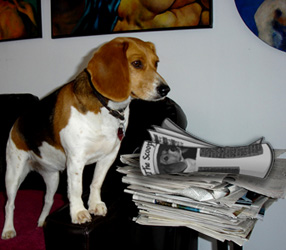

 chicks,
eight guinea pigs, two stray puppies and even 15 rabbits.
chicks,
eight guinea pigs, two stray puppies and even 15 rabbits.
 Geoff added: 'They are inseparable at the moment, Bramble
walks between her legs and they keep kissing each other. They
walk together round the sanctuary. It's absolutely marvellous.
It's a real treat to see them.
Geoff added: 'They are inseparable at the moment, Bramble
walks between her legs and they keep kissing each other. They
walk together round the sanctuary. It's absolutely marvellous.
It's a real treat to see them. 




 pressuring
designer Donna Karan to drop fur from her designs--by protesting
outside her boutiques, crashing her runway show, and exposing
her cruel use of fur onlin--Donna Karan has
pressuring
designer Donna Karan to drop fur from her designs--by protesting
outside her boutiques, crashing her runway show, and exposing
her cruel use of fur onlin--Donna Karan has  announced
that all her Fall 2009 lines will be fur-free and that she
has "no plans" to use fur in the future.
announced
that all her Fall 2009 lines will be fur-free and that she
has "no plans" to use fur in the future. 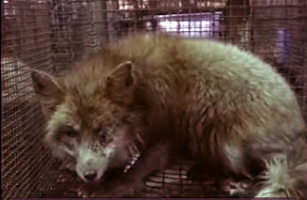



 chased
an intruder from her family's New City home on Tuesday.
chased
an intruder from her family's New City home on Tuesday.  Iraqi
Journalist Hurls Shoes at Bush and Denounces Him on TV as a
‘DOG’
Iraqi
Journalist Hurls Shoes at Bush and Denounces Him on TV as a
‘DOG’


 Vice
President-elect Joe Biden has picked out a 3-month-old male
German shepherd from a suburban Philadelphia kennel to bring
with him to Washington.
Vice
President-elect Joe Biden has picked out a 3-month-old male
German shepherd from a suburban Philadelphia kennel to bring
with him to Washington.
 On November 20, ASPCA Humane Law Enforcement agents arrested
Bronx resident Cedric Flemming for neglecting his seven-year-old
female dog, Precious. Flemming, 28, was charged with one count
of misdemeanor animal cruelty, punishable by up to one year
in jail and a $2,000 fine.
On November 20, ASPCA Humane Law Enforcement agents arrested
Bronx resident Cedric Flemming for neglecting his seven-year-old
female dog, Precious. Flemming, 28, was charged with one count
of misdemeanor animal cruelty, punishable by up to one year
in jail and a $2,000 fine. 



 the
final exam. The big day arrives. But, right before the instructor
tells you to pick up your pencil, you sit down on a chair
full of thumbtacks while hundreds of fire ants come spilling
out of your desk to nibble on your arms. Think it'd be easy
to concentrate? Oscar the Vicktory dog didn't think so either.
Thank goodness he had another chance!
the
final exam. The big day arrives. But, right before the instructor
tells you to pick up your pencil, you sit down on a chair
full of thumbtacks while hundreds of fire ants come spilling
out of your desk to nibble on your arms. Think it'd be easy
to concentrate? Oscar the Vicktory dog didn't think so either.
Thank goodness he had another chance! 
 for
about 20,000 interceptions, is applauded by K-9 enforcement
officers during his retirement party in the Customs area at
the Tom Bradley International Terminal at LAX.
for
about 20,000 interceptions, is applauded by K-9 enforcement
officers during his retirement party in the Customs area at
the Tom Bradley International Terminal at LAX.  The
police had been investigating whether the killings, which
shocked this low-crime nation, were motivated by recent scandals
involving tens of millions of lost pension records, which
are administered by the ministry.
The
police had been investigating whether the killings, which
shocked this low-crime nation, were motivated by recent scandals
involving tens of millions of lost pension records, which
are administered by the ministry.  Ex-NFL
player Vick allowed dogs to savage family pets: report
Ex-NFL
player Vick allowed dogs to savage family pets: report allowed
his fighting dogs to savage family pets, a federal
government agency has said in a report.
allowed
his fighting dogs to savage family pets, a federal
government agency has said in a report.
 a
Long Island coffee house.
a
Long Island coffee house. 
 Tafik Habib,
40, pleaded guilty to ``overdriving, torturing and injuring''
an animal, a violation of the state's agricultural law. He
admitted to the court he kicked the 15-pound, nearly 3-year-old
dog and beat her with an umbrella.
Tafik Habib,
40, pleaded guilty to ``overdriving, torturing and injuring''
an animal, a violation of the state's agricultural law. He
admitted to the court he kicked the 15-pound, nearly 3-year-old
dog and beat her with an umbrella.  was wrong because the dogs didn't come to meet me,'' he said
in the courthouse lobby.
was wrong because the dogs didn't come to meet me,'' he said
in the courthouse lobby.  raged
through a Bronx pet shop.
raged
through a Bronx pet shop. Turns
out that when it comes to biting White House visitors, First
Dog Barney is a repeat offender.
Turns
out that when it comes to biting White House visitors, First
Dog Barney is a repeat offender. 

 13-year-old
mixed-breed Dog that survived a Cicero house fire after
his owner refused to flee the burning home without him.
13-year-old
mixed-breed Dog that survived a Cicero house fire after
his owner refused to flee the burning home without him. “We
have two criteria that have to be reconciled. One is that
Malia is allergic, so it has to be hypoallergenic. There
are a number of breeds that are hypoallergenic. On the other
hand, our preference would be to get a shelter dog, but,
obviously, a lot of shelter dogs are mutts like me. So —
so whether we’re going to be able to balance those
two things, I think, is a pressing issue on the Obama household.”
“We
have two criteria that have to be reconciled. One is that
Malia is allergic, so it has to be hypoallergenic. There
are a number of breeds that are hypoallergenic. On the other
hand, our preference would be to get a shelter dog, but,
obviously, a lot of shelter dogs are mutts like me. So —
so whether we’re going to be able to balance those
two things, I think, is a pressing issue on the Obama household.” Dogs
nail dumb-ashes
Dogs
nail dumb-ashes Fifty-six
percent of Massachusetts voters spoke up for greyhounds
by voting “Yes” for a ballot initiative that
will phase out commercial dog racing in the state by 2010.
Despite a major advertising campaign launched by the opposition,
over 1.6 million people voted in favor of the initiative.
This is a huge victory for the many animal welfare groups
and volunteers who worked hard to get this measure passed
and will have a direct impact on the over 1,000 greyhounds
at Massachusetts's two racing tracks. These dogs will
no longer have to spend twenty hours a day confined in small
stacked cages and risk injuries associated with racing including
broken bones, paralysis, seizure, head trauma and death.
Fifty-six
percent of Massachusetts voters spoke up for greyhounds
by voting “Yes” for a ballot initiative that
will phase out commercial dog racing in the state by 2010.
Despite a major advertising campaign launched by the opposition,
over 1.6 million people voted in favor of the initiative.
This is a huge victory for the many animal welfare groups
and volunteers who worked hard to get this measure passed
and will have a direct impact on the over 1,000 greyhounds
at Massachusetts's two racing tracks. These dogs will
no longer have to spend twenty hours a day confined in small
stacked cages and risk injuries associated with racing including
broken bones, paralysis, seizure, head trauma and death. Prevention
of Farm Animal Cruelty Act. This landmark victory
will improve the lives of nearly 20 million farm animals
who are currently confined and crammed into cages on factory
farms throughout California. By phasing out the use
of battery cages, gestation crates, and veal crates, the
law not only benefits animals in California, but also sends
a strong message that these confinement methods are cruel
and should be banned.
Prevention
of Farm Animal Cruelty Act. This landmark victory
will improve the lives of nearly 20 million farm animals
who are currently confined and crammed into cages on factory
farms throughout California. By phasing out the use
of battery cages, gestation crates, and veal crates, the
law not only benefits animals in California, but also sends
a strong message that these confinement methods are cruel
and should be banned.  The
White House The Washington Post 's Al Kamen reports that
Barney,
President George W. Bush and First Lady Laura Bush's Dog,
tried to bite a reporter from Reuters . (This comes via
The Huffington Post's Media vertical .)
The
White House The Washington Post 's Al Kamen reports that
Barney,
President George W. Bush and First Lady Laura Bush's Dog,
tried to bite a reporter from Reuters . (This comes via
The Huffington Post's Media vertical .) 
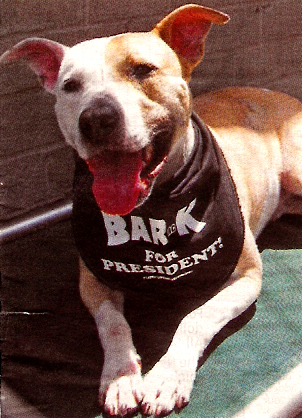
 guard
a box of kittens! Four family members and one Dog escaped the
fire.
guard
a box of kittens! Four family members and one Dog escaped the
fire.  juggernaut.
A co-production of Yash Raj Films and Walt Disney Pictures,
“Romeo” is something new under the Indian sun:
sophisticated computer-generated animation that uses stars
to voice the characters. But craftsmanship and Disney aside,
“Romeo” is very much a conventional Hindi movie
with a small-guys-versus-gangsters plot, song-and-dance sequences
and film references galore.
juggernaut.
A co-production of Yash Raj Films and Walt Disney Pictures,
“Romeo” is something new under the Indian sun:
sophisticated computer-generated animation that uses stars
to voice the characters. But craftsmanship and Disney aside,
“Romeo” is very much a conventional Hindi movie
with a small-guys-versus-gangsters plot, song-and-dance sequences
and film references galore.  NEW
YORK ~AP
NEW
YORK ~AP The
dogs, ranging in age from 2 months to 6 years, are relatively
healthy, but are not well socialized to strangers and new environments.
The
dogs, ranging in age from 2 months to 6 years, are relatively
healthy, but are not well socialized to strangers and new environments.
 Tuesday
at Lackland Air Force Base , offering a long overdue facility
that gives advanced medical treatment for combat-wounded dogs.
Tuesday
at Lackland Air Force Base , offering a long overdue facility
that gives advanced medical treatment for combat-wounded dogs.



 "I
just want my puppy home," Sgt. Gwen Beberg
of Minneapolis (left with Ratchet) wrote to her mother in
an e-mail Sunday from Iraq , soon after she was separated
from the dog following a transfer. "I miss my dog horribly."
Beberg, 28, is scheduled to return to the U.S. next month.
"I
just want my puppy home," Sgt. Gwen Beberg
of Minneapolis (left with Ratchet) wrote to her mother in
an e-mail Sunday from Iraq , soon after she was separated
from the dog following a transfer. "I miss my dog horribly."
Beberg, 28, is scheduled to return to the U.S. next month.


 The
request, by the United States Fish and Wildlife Service, follows
a temporary order by Judge Donald Molloy of Federal District
Court in Missoula, Mont., against the service’s decision
in March to remove the wolf from the list. The agency said
then that the wolf population in the Northern Rockies had
fully recovered.
The
request, by the United States Fish and Wildlife Service, follows
a temporary order by Judge Donald Molloy of Federal District
Court in Missoula, Mont., against the service’s decision
in March to remove the wolf from the list. The agency said
then that the wolf population in the Northern Rockies had
fully recovered. Judge
Donald Molloy (left) of Federal District Court has had much
to do with this outcome. In July, in response to a lawsuit
from environmental groups, he found that the government had
failed to meet its own standards for delisting the wolves.
Crucially, the service had provided no evidence of interbreeding
among the scattered populations of wolves. Interbreeding is
an important sign of adequate, stable numbers.
Judge
Donald Molloy (left) of Federal District Court has had much
to do with this outcome. In July, in response to a lawsuit
from environmental groups, he found that the government had
failed to meet its own standards for delisting the wolves.
Crucially, the service had provided no evidence of interbreeding
among the scattered populations of wolves. Interbreeding is
an important sign of adequate, stable numbers.  prison
on Monday for her role in an infamous fatal dog mauling. Marjorie
Knoller, whose dogs attacked a neighbor, was sentenced to 15
years to life.
prison
on Monday for her role in an infamous fatal dog mauling. Marjorie
Knoller, whose dogs attacked a neighbor, was sentenced to 15
years to life.
 Ms.
Knoller asserted that she had tried to protect her neighbor
from the dogs, a powerful breed called Presa Canario.
But prosecutors convinced a jury that Ms. Knoller was both
aware of the dogs’ violent potential and blithe to other
people’s safety. Ms. Knoller’s husband, Robert
Noel, who was not present at the attack, was also convicted
of involuntary manslaughter.
Ms.
Knoller asserted that she had tried to protect her neighbor
from the dogs, a powerful breed called Presa Canario.
But prosecutors convinced a jury that Ms. Knoller was both
aware of the dogs’ violent potential and blithe to other
people’s safety. Ms. Knoller’s husband, Robert
Noel, who was not present at the attack, was also convicted
of involuntary manslaughter. For
more in-depth coverage of our rescue efforts in Galveston
County, please check out our Rapid Response community on the
Network.
For
more in-depth coverage of our rescue efforts in Galveston
County, please check out our Rapid Response community on the
Network.  A
federal wildlife official in Billings said the government
planned to retreat for now from its attempt to take gray wolves
in the Northern Rockies off the endangered species list.
A
federal wildlife official in Billings said the government
planned to retreat for now from its attempt to take gray wolves
in the Northern Rockies off the endangered species list. 

 If
only Goldilocks had a feisty dog.
If
only Goldilocks had a feisty dog.  Tomorrow
is Day One of the Democratic National Convention in Denver,
Colo.
Tomorrow
is Day One of the Democratic National Convention in Denver,
Colo.  More
than 1,000 puppies have a new lease on life following their
discovery Saturday in a large puppy mill breeding facility
tucked away in the backwoods of West Virginia, just outside
of city of Parkersburg.
More
than 1,000 puppies have a new lease on life following their
discovery Saturday in a large puppy mill breeding facility
tucked away in the backwoods of West Virginia, just outside
of city of Parkersburg.  When
she was just hours old, Zoya’s mother Helga lost interest
in her cub and zookeepers realized they would have to intervene
to save her. As part of the hand-rearing process, one of
the keepers took Zoya home to meet Sam. The two hit it
off well. In fact, Sam surprised the keepers by showing
a nurturing and attentive attitude to the little tiger.
When
she was just hours old, Zoya’s mother Helga lost interest
in her cub and zookeepers realized they would have to intervene
to save her. As part of the hand-rearing process, one of
the keepers took Zoya home to meet Sam. The two hit it
off well. In fact, Sam surprised the keepers by showing
a nurturing and attentive attitude to the little tiger. 
 Swimmer
Amanda Beard might be the sexiest and most compassionate U.S.
Olympic athlete of all time. Need proof? Check out the anti-fur
ad that she did—naked—for PETA.
Swimmer
Amanda Beard might be the sexiest and most compassionate U.S.
Olympic athlete of all time. Need proof? Check out the anti-fur
ad that she did—naked—for PETA.  The Saudi religious police have reportedly vowed to strictly
enforce a ban on the sale of pet cats and dogs in Riyadh and
walking animals in public.
The Saudi religious police have reportedly vowed to strictly
enforce a ban on the sale of pet cats and dogs in Riyadh and
walking animals in public.  Zander
the dog has become a real fan of the old saying "If at
first you don’t succeed.…" It took more than
one try to help the poor guy feel better.
Zander
the dog has become a real fan of the old saying "If at
first you don’t succeed.…" It took more than
one try to help the poor guy feel better.  THOSE
who hope to taste dog meat when they visit Beijing
for this summer’s Olympics may be disappointed. The
Beijing Catering Trade Association has ordered all 112 designated
Olympic restaurants to take dog off the menu, and has strongly
advised other establishments to stop serving it until September.
Waiters have been urged to “patiently” suggest
alternative dishes to customers who ask for dog. It’s
all part of a wider campaign to avoid offending foreigners
during the Games. (Beijingers have also been told to line
up nicely, to stop spitting and even to avoid asking tourists
questions about their ages, salaries and love lives.)
THOSE
who hope to taste dog meat when they visit Beijing
for this summer’s Olympics may be disappointed. The
Beijing Catering Trade Association has ordered all 112 designated
Olympic restaurants to take dog off the menu, and has strongly
advised other establishments to stop serving it until September.
Waiters have been urged to “patiently” suggest
alternative dishes to customers who ask for dog. It’s
all part of a wider campaign to avoid offending foreigners
during the Games. (Beijingers have also been told to line
up nicely, to stop spitting and even to avoid asking tourists
questions about their ages, salaries and love lives.) 

 On this, the 30th anniversary birthday of our famous "poop
scoop" law, the first of its kind to work in a big city
and model for communities around the world, what are we celebrating
- besides the fact that we don't have to scrape something
off our shoes?
On this, the 30th anniversary birthday of our famous "poop
scoop" law, the first of its kind to work in a big city
and model for communities around the world, what are we celebrating
- besides the fact that we don't have to scrape something
off our shoes?

 A
federal judge in Missoula, Mont., has given Rocky Mountain gray
wolves a well-deserved reprieve. In February, the federal Fish
and Wildlife Service had effectively sentenced hundreds of wolves
to death by lifting the protections provided by the Endangered
Species Act. Since then, because of far weaker state protections
in Wyoming, Montana and Idaho, more than 100 wolves out of a
total population of 1,500 have been killed. As many as 500 more
were doomed to die in state-authorized hunts this fall.
A
federal judge in Missoula, Mont., has given Rocky Mountain gray
wolves a well-deserved reprieve. In February, the federal Fish
and Wildlife Service had effectively sentenced hundreds of wolves
to death by lifting the protections provided by the Endangered
Species Act. Since then, because of far weaker state protections
in Wyoming, Montana and Idaho, more than 100 wolves out of a
total population of 1,500 have been killed. As many as 500 more
were doomed to die in state-authorized hunts this fall.  When
her beagle, Rocco, squeezed himself under the backyard gate
and disappeared into the streets of Queens, 5-year-old Natalie
Villacis refused to believe - as her parents reluctantly told
her - that she would
When
her beagle, Rocco, squeezed himself under the backyard gate
and disappeared into the streets of Queens, 5-year-old Natalie
Villacis refused to believe - as her parents reluctantly told
her - that she would 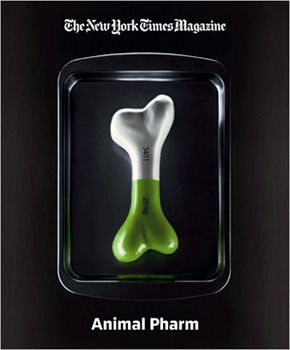
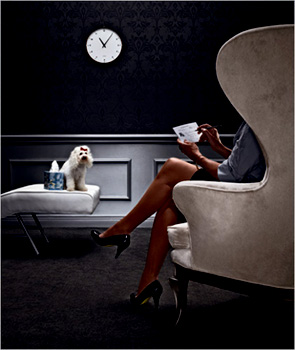
 This
loveable goofball is one of four Vicktory dogs to be featured
in an upcoming two-hour National Geographic Channel special:
"Dogtown: Saving the Michael Vick Dogs." In order
to help put a face to the show, Georgia attended the press
tour so that the critics and other attendees could see up
close what the show was all about. The Best Friends team included
John Garcia, Michelle Besmehn, Dr. Michael Dix, Elissa Jones,
Juliette Watt as pilot, and of course Georgia… who racked
up quite a bit more than 15 minutes of fame.
This
loveable goofball is one of four Vicktory dogs to be featured
in an upcoming two-hour National Geographic Channel special:
"Dogtown: Saving the Michael Vick Dogs." In order
to help put a face to the show, Georgia attended the press
tour so that the critics and other attendees could see up
close what the show was all about. The Best Friends team included
John Garcia, Michelle Besmehn, Dr. Michael Dix, Elissa Jones,
Juliette Watt as pilot, and of course Georgia… who racked
up quite a bit more than 15 minutes of fame.  The
ASPCA ®(The American Society for the Prevention of Cruelty
to Animals ®) today announced that it was part of a team
of animal welfare agencies, led by the Humane Society of the
United States (HSUS), as well as the Madison County, Ga. Sheriff’s
Department and Madison County Animal Control, which participated
in a major planned raid of “Shake Down Kennels,”
an alleged dogfighting operation in Danielsville, Ga.
Johnny Johnson, the alleged owner, was arrested and
charged with felony dogfighting.
The
ASPCA ®(The American Society for the Prevention of Cruelty
to Animals ®) today announced that it was part of a team
of animal welfare agencies, led by the Humane Society of the
United States (HSUS), as well as the Madison County, Ga. Sheriff’s
Department and Madison County Animal Control, which participated
in a major planned raid of “Shake Down Kennels,”
an alleged dogfighting operation in Danielsville, Ga.
Johnny Johnson, the alleged owner, was arrested and
charged with felony dogfighting. 

 DOGGY
DEAREST Joan Crawford sharing a bite with her dog. Some
people share all with pets.
DOGGY
DEAREST Joan Crawford sharing a bite with her dog. Some
people share all with pets.  The
spectacle is the brainchild of the capuchin monkey's handler,
Tommy Lucia.
The
spectacle is the brainchild of the capuchin monkey's handler,
Tommy Lucia. 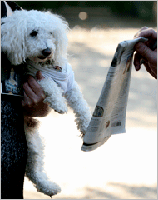
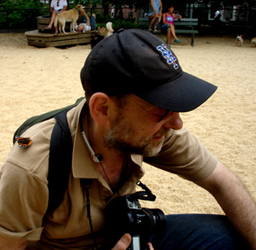
 The
dogs’ owner, James W. McNair (left), 28, a registered
sex offender, was arrested late Tuesday and charged with keeping
unleashed dogs and with failure to have collars or tags on
the dogs, officials said. He was also charged with possession
of fireworks, which were found when the police searched his
home, the authorities said.
The
dogs’ owner, James W. McNair (left), 28, a registered
sex offender, was arrested late Tuesday and charged with keeping
unleashed dogs and with failure to have collars or tags on
the dogs, officials said. He was also charged with possession
of fireworks, which were found when the police searched his
home, the authorities said.
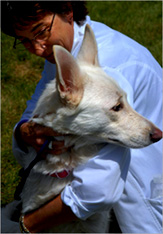

 Roger
and Tammy West lost their house in Jasper, Ga., to
foreclosure and moved to a rental property. They say
they cannot afford to keep two of their three dogs.
Roger
and Tammy West lost their house in Jasper, Ga., to
foreclosure and moved to a rental property. They say
they cannot afford to keep two of their three dogs. Leo
— rescued from heavy chains that confined him as one
of the pit bulls in former NFL quarterback Michael Vick’s
dogfighting ring — is a lover, not a fighter. He now
happily frolics in a clown collar as he makes the rounds at
the Camino Infusion Center, where he brings comfort to cancer
patients undergoing chemotherapy.
Leo
— rescued from heavy chains that confined him as one
of the pit bulls in former NFL quarterback Michael Vick’s
dogfighting ring — is a lover, not a fighter. He now
happily frolics in a clown collar as he makes the rounds at
the Camino Infusion Center, where he brings comfort to cancer
patients undergoing chemotherapy. 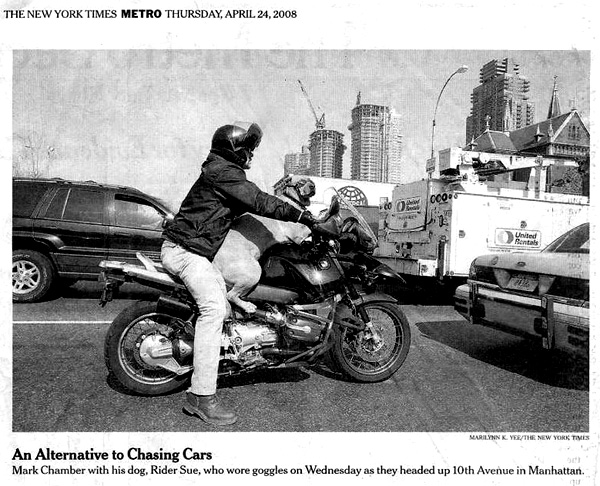

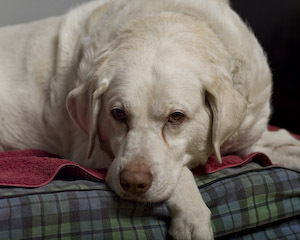
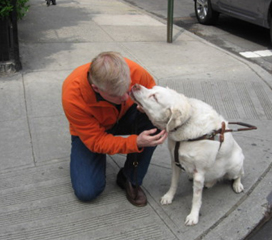





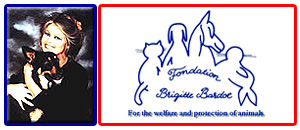


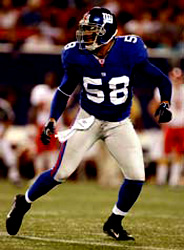



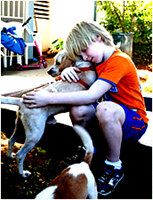


 Anthony
Gonzalez, left, Peter Byrne, right
Anthony
Gonzalez, left, Peter Byrne, right
 GOOD
NEWS:
GOOD
NEWS:
 Christopher
Furlong/Getty Images
Christopher
Furlong/Getty Images

 Liberty
and K-Pot, two puppies rescued off Iraqi streets by US troops
have survived sure death thanks to SPCA International’s
Operation Baghdad Pups and program sponsors I Love Dogs, Inc.Liberty
and K-Pot have been serving in Iraq as sanctioned security dogs
for the unit who adopted them, but the unit is moving to a forward
operating base and is not allowed to bring the dogs along. If
SPCA International had not come to the rescue in time, K-Pot
and Liberty would have been left to the harsh war-torn streets
and Iraqi civilians who are sometimes hostile to dogs who have
befriended our US troops. Liberty and K-Pot have provided endless
love and a sense of home to our US soldiers serving in Iraq.
Liberty
and K-Pot, two puppies rescued off Iraqi streets by US troops
have survived sure death thanks to SPCA International’s
Operation Baghdad Pups and program sponsors I Love Dogs, Inc.Liberty
and K-Pot have been serving in Iraq as sanctioned security dogs
for the unit who adopted them, but the unit is moving to a forward
operating base and is not allowed to bring the dogs along. If
SPCA International had not come to the rescue in time, K-Pot
and Liberty would have been left to the harsh war-torn streets
and Iraqi civilians who are sometimes hostile to dogs who have
befriended our US troops. Liberty and K-Pot have provided endless
love and a sense of home to our US soldiers serving in Iraq.


